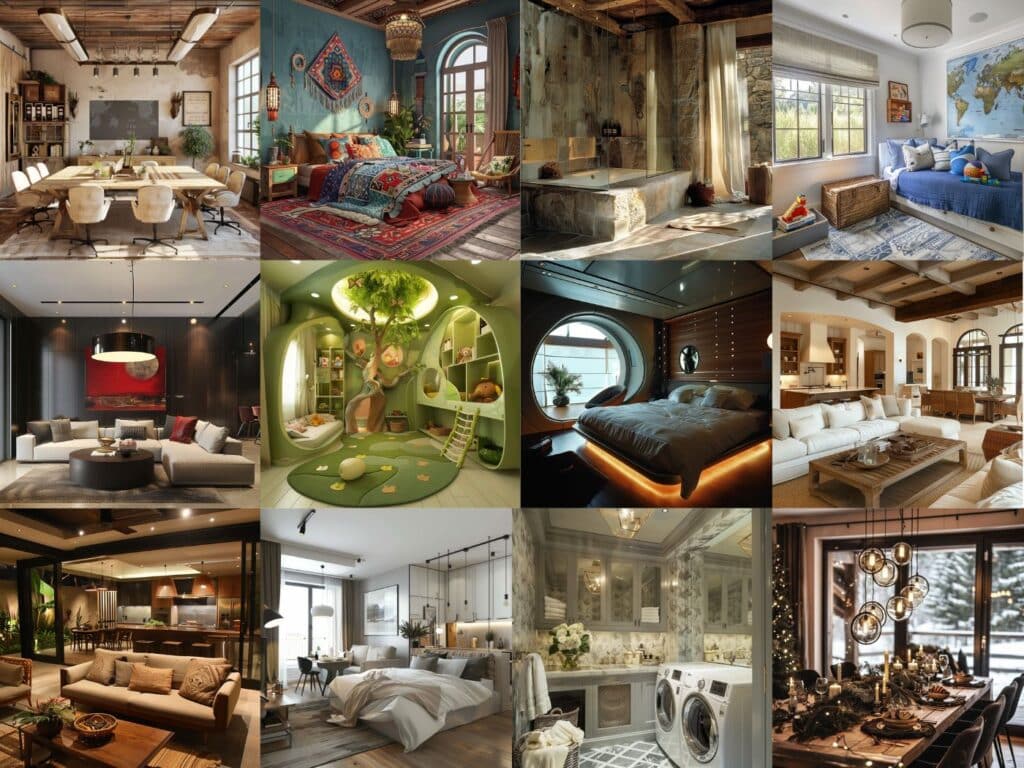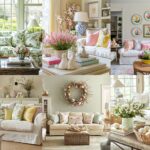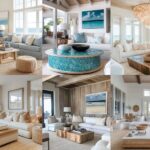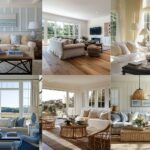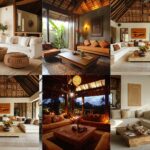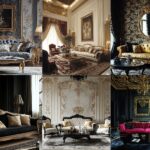Designing your home can feel overwhelming with so many different interior design styles to choose from. You’ve likely encountered terms like contemporary, modern, industrial, and art deco during your research. But what do these styles really mean, and how do you decide which one suits your space best?
Each of the home decor styles below carries its unique characteristics, offering distinct flavors, finishes, and experiences. Understanding these differences isn’t just about aesthetics; it’s about creating a living space that resonates with your personal taste and lifestyle needs.
Let’s explore some top decorating styles that have stood the test of time and continue to be embraced by homeowners today.
#1. Modern
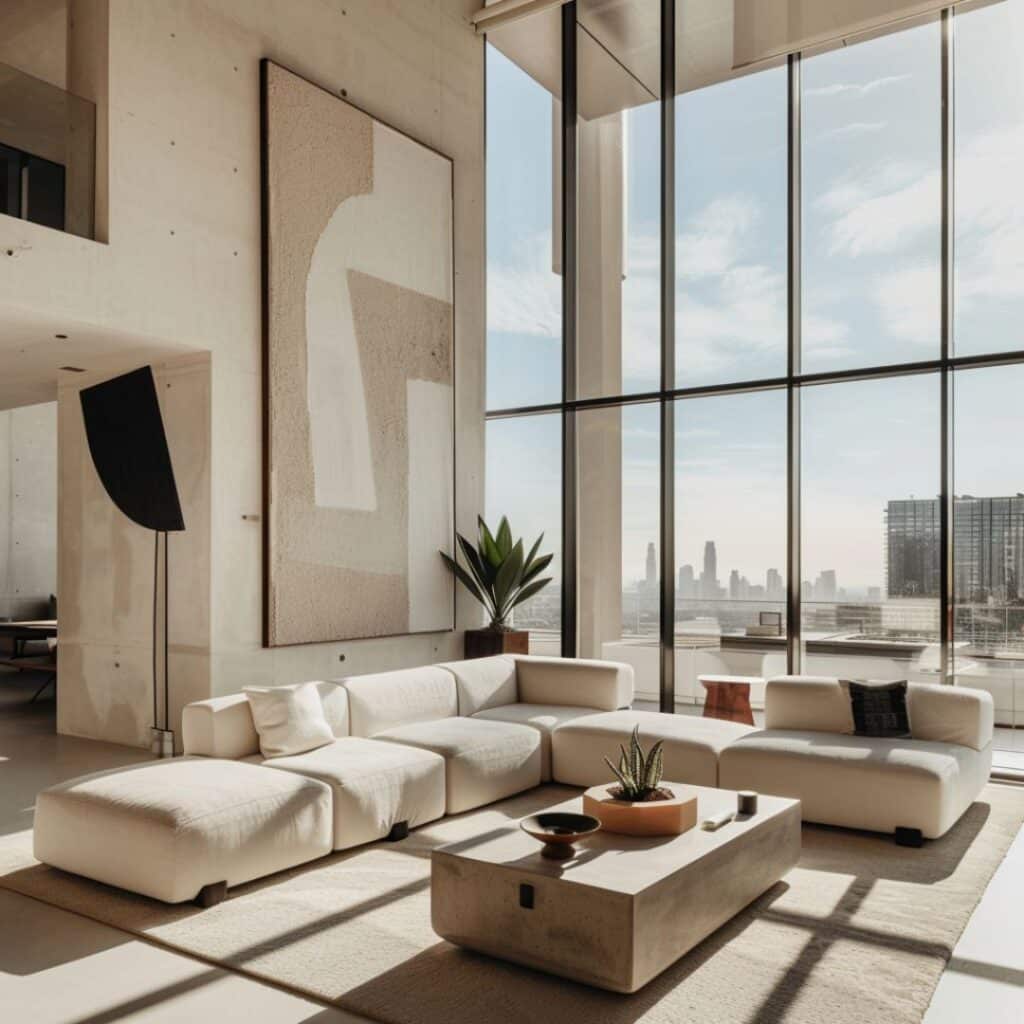
Modern interior design focuses on simplicity, clean lines, and a neutral color palette. It emphasizes functionality and minimalism, with an absence of unnecessary decoration. Furniture in modern design often features natural materials like wood and leather, with sleek, geometric shapes.
Key Elements of Modern Interior Design:
- Simplicity: Emphasizes uncluttered spaces and clean lines.
- Neutral Colors: Uses shades of white, black, and gray, with occasional pops of color.
- Natural Materials: Incorporates wood, leather, and metal.
- Geometric Shapes: Furniture and decor often feature sharp, clean lines.
#2. Minimalist
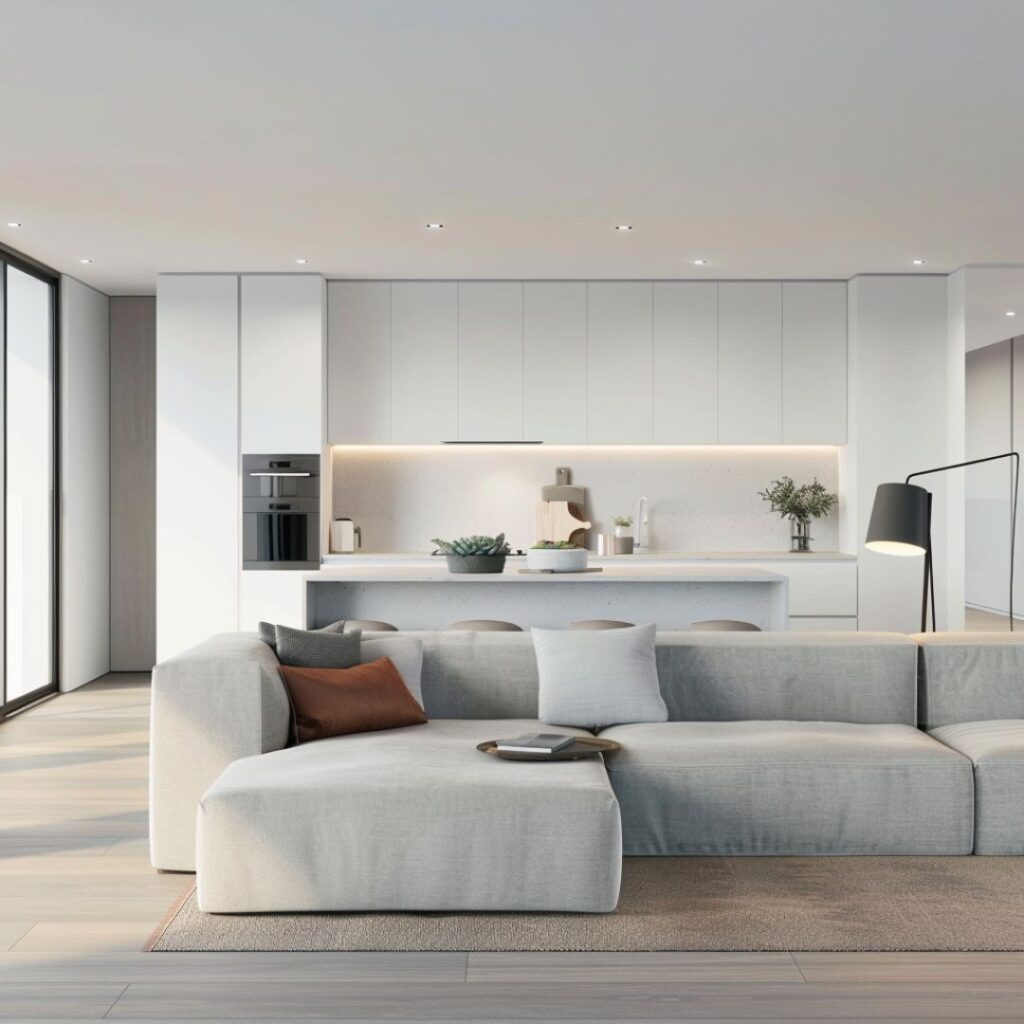
Minimalist interior design is all about simplicity and functionality. It values clean lines, uncluttered spaces, and neutral color palettes like white, black, and gray.
Key Elements of Minimalist Interior Design:
- Simplicity: This design uses only what’s necessary to achieve the desired effect.
- Clean Lines: Expect reductive elements and an overall uncluttered look.
- Neutral Colors: White, black, and gray dominate this style’s palette.
- Natural Materials: Wood, stone, and metal create a warm atmosphere.
In minimalist interiors, less truly is more. Furniture often doubles as storage to keep spaces tidy, and patterns are rare, but textures are essential for adding depth without cluttering the space.
#3. Contemporary
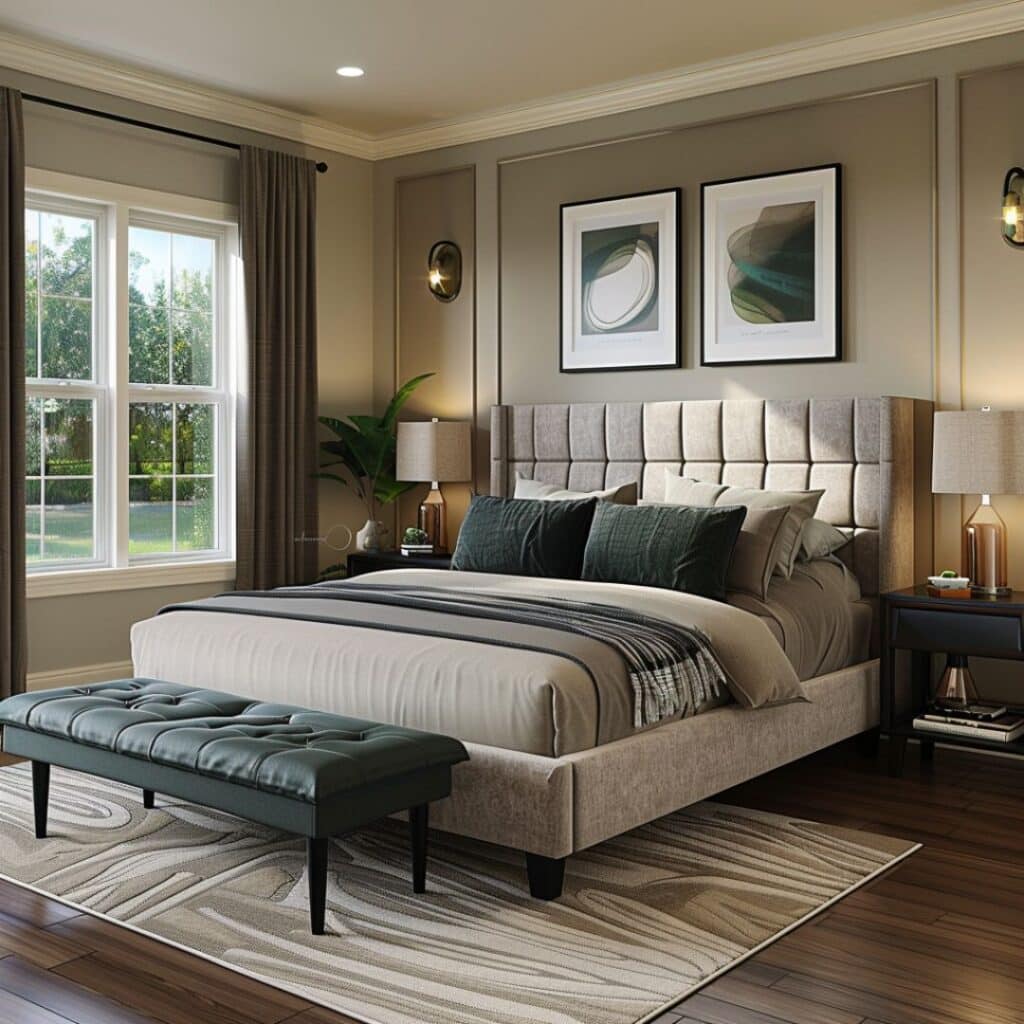
Contemporary interior design evolves with the times, reflecting current trends and preferences. It is often confused with modern design, but while modern design refers to a specific period, contemporary design is more fluid.
Key Elements of Contemporary Interior Design:
- Neutral Colors: Whites, blacks, and grays with bold color accents.
- Clean Lines: Smooth surfaces and crisp, clean lines.
- Open Spaces: Emphasizes open floor plans and natural light.
- Mixed Materials: Combines natural and synthetic materials.
#4. Industrial

Industrial interior design draws inspiration from factories and industrial buildings. It highlights raw, unfinished materials like exposed brick, concrete, and metal. You’ll often see architectural elements like exposed ductwork and pipes.
Key Characteristics
- Exposed Architectural Elements: This style showcases ductwork, pipes, and structural features like brick walls and metal beams.
- Raw Materials: Concrete floors, brick walls, and metal fixtures are common in industrial spaces.
- Neutral Color Palette: Shades of black, gray, white, and brown dominate the color scheme.
Raw and Exposed Materials
Homes with an industrial style embrace the raw look of materials used in factories. Exposed brick walls add ruggedness to your space. Metal beams and pipes bring authenticity.
Utilitarian Aesthetic
Functional furniture inspired by industrial equipment is key. You may well find metal chairs or reclaimed wood tables. Vintage lighting fixtures often feature prominently.
Open and Spacious Layouts
Industrial spaces usually have open layouts with high ceilings. Large windows maximize natural light. Minimal partitions create a sense of openness.
Adding cowhides or sheepskin can soften wood elements for a cozier feel. Fabrics typically lack loud patterns but focus on texture instead. Unexpected additions like an industrial pendant light can enhance sophistication while maintaining rustic charm.
The origin of industrial interior design traces back to when Western European factories closed down at the end of the second industrial revolution—leading people to convert these vacant buildings into residential areas due to population increases.
#5. Scandinavian

Scandinavian interior design is all about simplicity, functionality, and warmth. Originating in the 1950s from Sweden, Norway, and Denmark, this style focuses on creating bright and airy spaces.
Simple Clean Lines
Scandinavian design features clean lines and minimal ornamentation. Furniture often has simple shapes that contribute to a clutter-free environment. This minimalist approach helps in maintaining a sense of order and tranquility.
Natural Materials
Expect to see natural materials like wood, leather, and wool in Scandinavian interiors. These materials are usually used in their raw or lightly processed forms to highlight their beauty. Wooden floors and furniture pieces made from oak or pine are common.
Neutral Color Palette
The color scheme is typically neutral with whites, light grays, and natural hues dominating the palette. This brightens up spaces during the long winter months. The use of these colors creates an inviting atmosphere.
Emphasis on Natural Light
Natural light is crucial in Scandinavian design due to the dark winters in Nordic countries. Large windows without heavy drapes allow maximum sunlight into rooms. Mirrors are strategically placed to reflect light throughout the space.
Quality Craftsmanship
Attention to detail is evident in Scandinavian furniture and decor. Pieces are built to last with high-quality craftsmanship being a key aspect. Functional designs combined with aesthetic appeal make these items timeless investments.
Open Spaces
Open layouts are another hallmark of this style. They provide a sense of flow and freedom within your home. Avoiding unnecessary walls or partitions makes spaces feel larger and more connected.
Lagom Philosophy
Lagom emphasizes balance and moderation—”just the right amount.” It’s about creating harmony without excessiveness or extravagance. This philosophy guides every choice from furniture selection to object arrangement.
By embracing these elements, you can create a cozy yet functional living space that reflects both simplicity and elegance.
#6. Bohemian
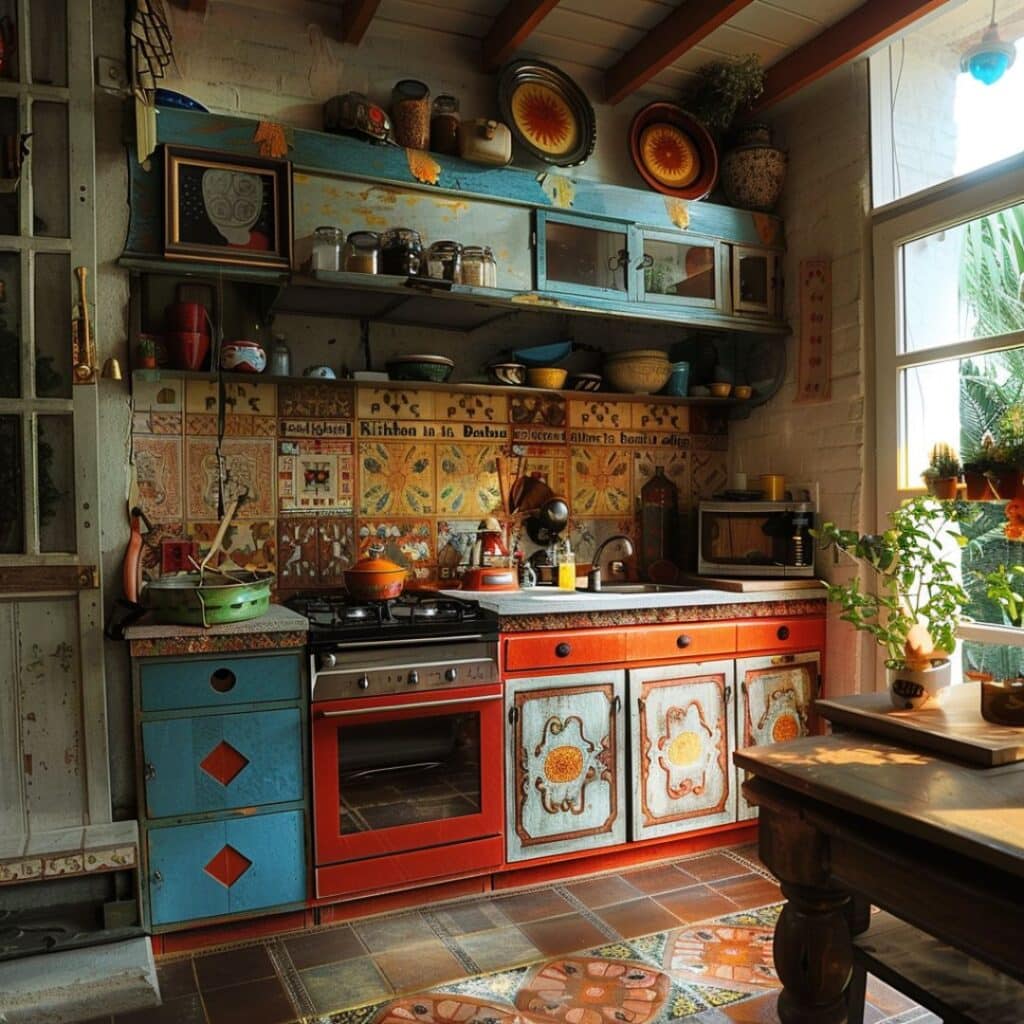
Bohemian interior design, often called Boho, embraces a free-spirited and eclectic approach. It combines bright colors, natural materials, and diverse patterns for a unique look.
Color Palette
Boho design uses neutral shades like brown, green, and gray as a base. These colors provide the perfect backdrop for vibrant hues that bring energy to your space.
Patterns and Textures
Layering patterns is key in Boho style. Mixing rugs, fabrics, and wall hangings creates visual interest. Think of combining paisley prints with ikat or floral designs for an engaging effect.
Natural Materials
Incorporating materials like wood, rattan, and wicker adds warmth. These elements help create a cozy atmosphere that’s essential to Boho spaces.
Eclectic Decor
Mix different cultural influences freely. Display trinkets from your travels to add a nomadic vibe. The absence of order here encourages creativity.
Rich Colors and Textures
Use jewel tones alongside earthy hues for depth. Layer tapestries, cushions, and rugs to enhance texture in your room.
Global Accents
Handmade items like macrame or woven baskets contribute authenticity. Vintage finds can add history while plants bring life indoors.
Bohemian interiors are all about expressing individuality through mixed elements. It’s relaxed yet purposeful chaos that creates an inviting home environment.
#7. Rustic
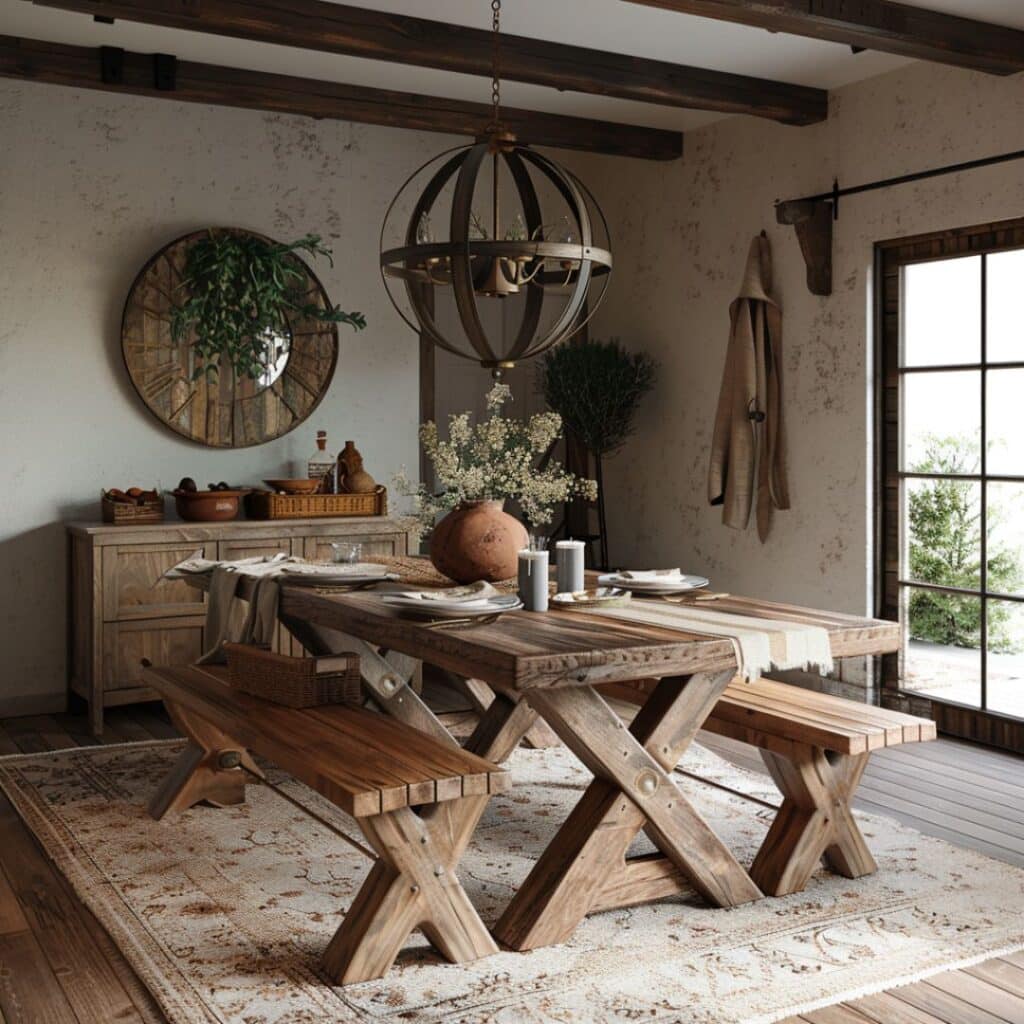
Rustic interior design emphasizes natural elements, comfort, and a relaxed atmosphere. It often blends styles like farmhouse, industrial, and cottage. Here’s what you’ll find in rustic interiors:
Key Features
- Natural Elements: Expect to see wood, stone, and clay. These materials create warmth and invite nature into your home.
- Texture: The decor features rough woods, jute rugs, and raw stone fireplaces. This variety creates a tactile experience.
- Handmade Pieces: Unique handmade items add character. They bring individuality to each space.
- Simplicity: Focus is on the material rather than elaborate designs. This results in streamlined pieces that feel both functional and beautiful.
- Exposed Beams: Common in rustic homes, exposed beams enhance the organic vibe of the space.
Sub-Styles
Farmhouse
Farmhouse style highlights practicality with charm. Think wooden tables, open shelving, and vintage accents that evoke countryside living.
Industrial
Industrial rustic combines ruggedness with modernity. You may well see metal fixtures paired with reclaimed wood for an edgy yet warm look.
Cottage
Cottage style brings coziness through soft fabrics and floral patterns. It’s about creating a welcoming environment with personal touches like family heirlooms or handcrafted accessories.
Incorporating these elements helps achieve a balanced rustic aesthetic that feels both inviting and authentic.
#8. Traditional
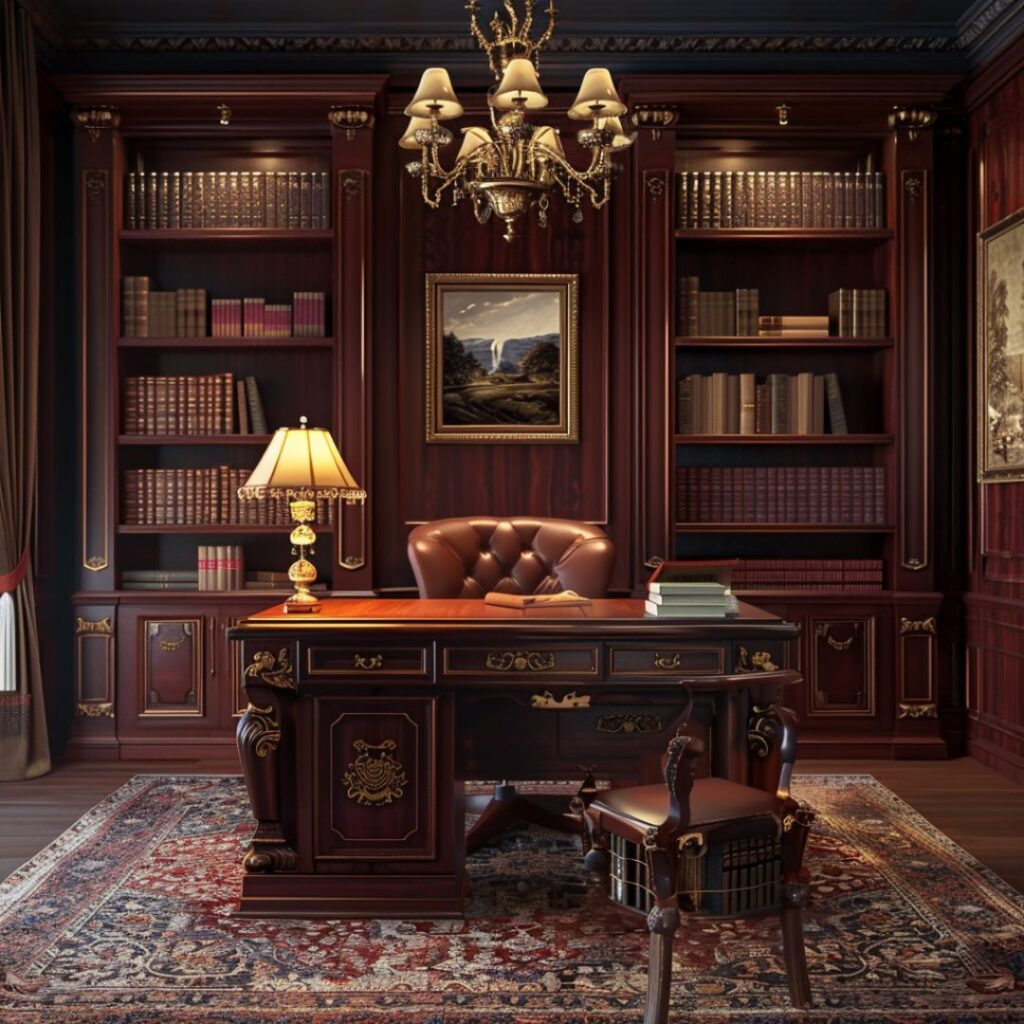
Traditional interior design draws inspiration from 18th- and 19th-century European styles, especially from England and France. This style emphasizes symmetry, order, and classic architectural details like crown molding and wainscoting.
Key Characteristics
- Symmetry: Traditional interiors prioritize balance. You’ll often see pairs of furniture or decor items, such as matching chairs flanking a fireplace.
- Furniture and Decor: Expect formal, elegant pieces with curved lines, tufted upholstery, and intricate carvings. Antiques or vintage items add character.
- Patterns: Classic patterns feature prominently. Stripes, plaids, florals, and damasks are common choices for fabrics and wallpapers.
- Color Palette: Subtle neutrals dominate the color scheme with occasional bold accents to create visual interest without overwhelming.
- Wood Finishes: Dark wood finishes on floors and furnishings provide a rich backdrop that complements the overall aesthetic.
Architectural Elements
Traditional homes feature refined architectural details:
- Crown molding adds elegance to ceilings.
- Wainscoting enhances walls with texture.
- Central fireplaces serve as focal points in living spaces.
Large Statement Pieces
Incorporate grand elements to establish focal points:
- Chandeliers bring drama to dining rooms.
- Oil paintings offer visual depth in gathering areas.
This approach creates a polished look that’s both timeless and sophisticated while maintaining an inviting atmosphere through layered textures like silk, velvet, and wool.
By sticking to these principles, you can achieve a harmonious traditional design that’s both stylish and comfortable for modern living spaces.
#9. Transitional
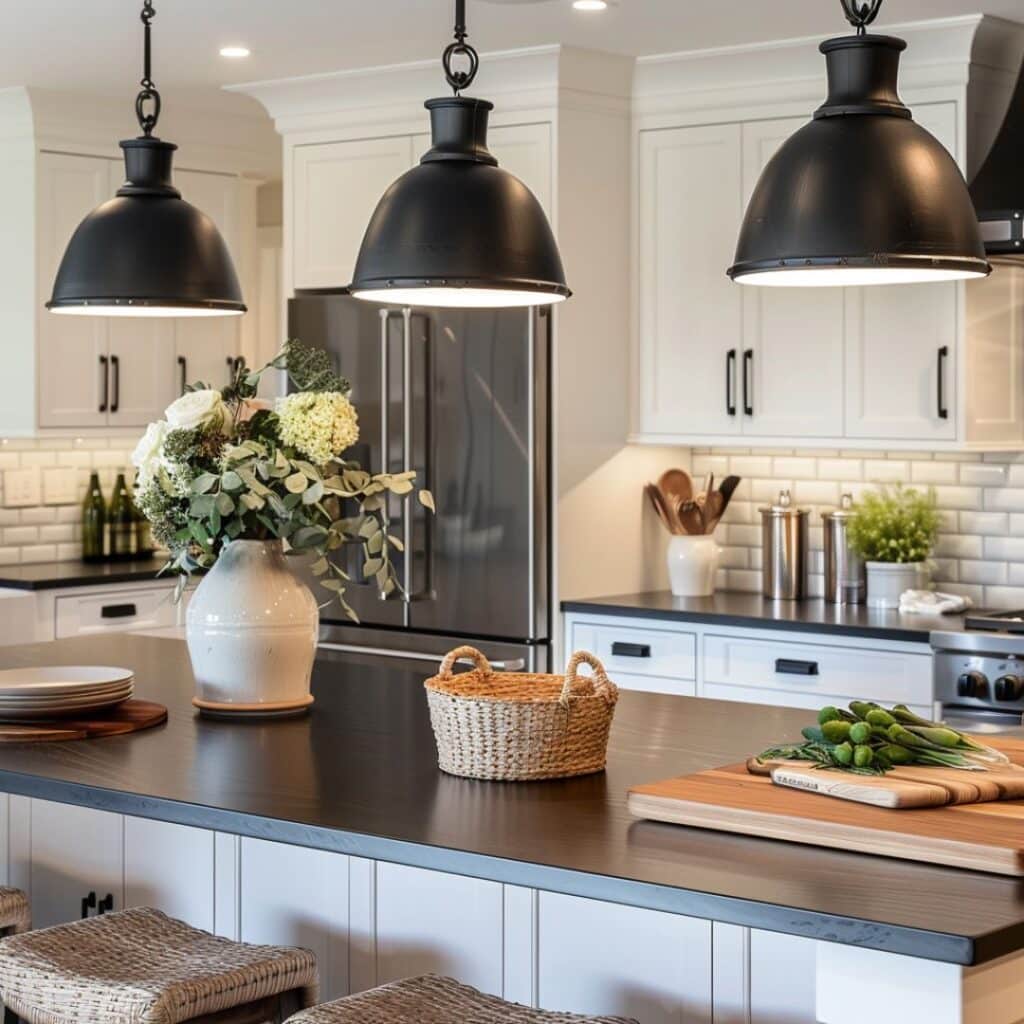
Transitional interior design blends modern and traditional elements. This style creates a timeless aesthetic by combining formal with relaxed touches.
Definition and History
Transitional design merges sleek modernity with classic comfort. It emerged to balance the starkness of modern design with the warmth of traditional styles.
- Neutral Color Palettes: Whites, creams, tans, and grays dominate transitional spaces. Pops of color come through rugs, pillows, or artwork.
- Blended Furniture: Curved and straight lines coexist in furniture. Both traditional and modern pieces are used together for a cohesive look.
This design style allows you to minimize clutter while focusing on textiles and furniture. You can easily incorporate blankets, throws, and area rugs to elevate your space’s appearance.
#10. French Country
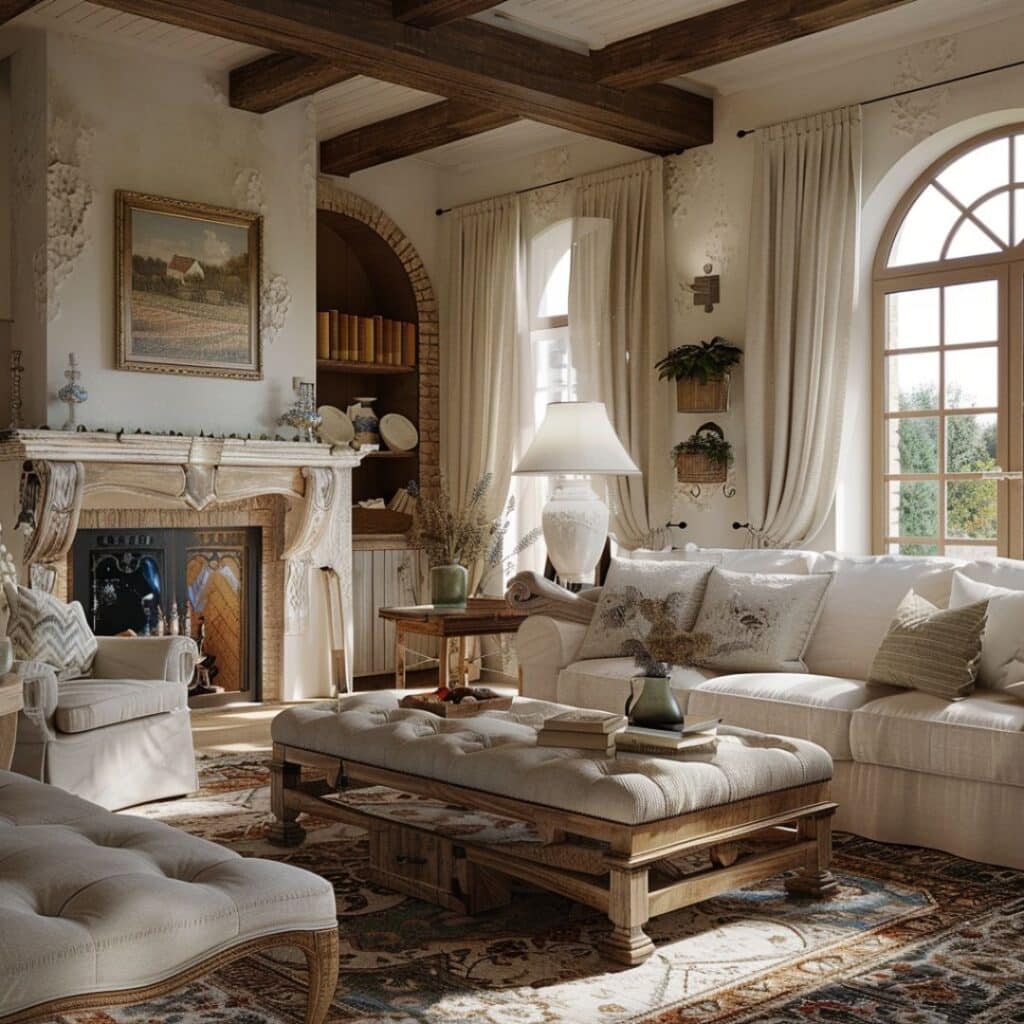
French Country interior design is a charming blend of rustic and refined elements inspired by the picturesque French countryside. This style combines comfort with elegance, creating an inviting atmosphere.
Key Characteristics
- Antique Furnishings: Antique wooden furniture takes center stage. Think intricate carvings, cabriole legs, and distressed finishes. Picture a Louis VI chair updated with modern prints.
- Warm, Soft Colors: A soft color palette defines this style. Warm hues like creams, light blues, soft greens, and muted yellows dominate the space.
- Delicate Prints: Upholstery often features delicate prints like toile, gingham, plaid, or stripes. These patterns add charm to drapery and wallpaper.
- Ornate Details: Ornate details bring sophistication. Chandeliers, wall sconces, and decorative candlesticks enhance elegance in any room.
Materials & Textures
Natural materials are key in French Country design. Stone floors and exposed wooden beams add character. Wrought iron accents also contribute to this aesthetic’s authenticity.
Distressed finishes on furniture highlight imperfections beautifully. Raw textures further emphasize its rustic appeal while maintaining a sense of refinement.
Atmosphere & Ambiance
This style aims to evoke nostalgia and serenity through gentle patinas on weathered furniture or the flickering glow of candlelight. It creates a romantic countryside retreat vibe you can feel at home in instantly.
With these characteristics seamlessly blended together—antique furnishings paired with warm colors—French Country interiors offer both comfort and elegance that stand out effortlessly.
#11. Coastal

Coastal interior design captures the essence of seaside living, evoking relaxation and tranquility. This style is rooted in natural beauty, often drawing inspiration from oceanic and beachside elements.
Color Palette
Soft, washed tones dominate coastal spaces. Think blues, whites, creams, greens, and grays that resemble a rocky shore. These hues create a serene atmosphere that mimics the calming effect of the sea.
Materials and Textures
Natural materials are key in coastal design. Use wood, linen, jute, rattan, and woven textures to achieve an organic feel. These elements bring warmth and authenticity to your space.
Furniture
Opt for comfortable yet durable furniture with traditional shapes. Weathered or driftwood finishes add character while maintaining a relaxed vibe. Pieces should appear lived-in to reflect a laid-back lifestyle.
Light and Airy Vibe
A coastal home feels bright and breezy. Minimize window treatments; choose light sheers that move with the wind to enhance this feeling of openness between indoors and outdoors.
Nautical Accents
Incorporate subtle nautical touches like seashells or maritime-inspired artwork without overdoing it. Elements such as stripes or sailboat motifs can hint at the seaside without overwhelming your decor.
Embracing these characteristics helps you create an inviting coastal retreat regardless of your home’s proximity to the ocean.
#12. Mediterranean
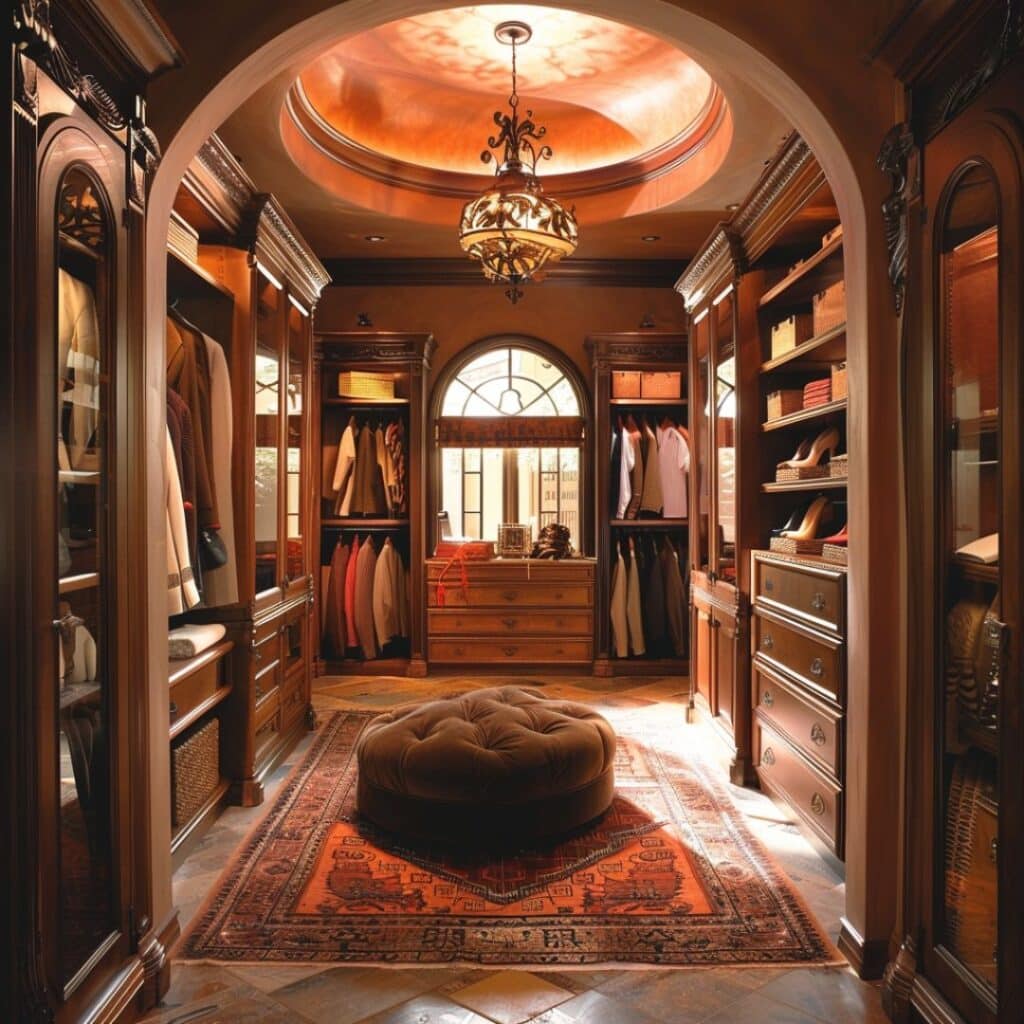
Mediterranean interior design combines warmth and elegance, inspired by the cultures surrounding the Mediterranean Sea. It’s characterized by natural materials like stone, wood, and wrought iron. These elements bring a rustic yet sophisticated touch to your space.
Key Features:
- Natural Materials: Stone floors, wooden beams, and wrought iron fixtures are staples in this style.
- Earthy Tones: Colors include white, cream, wood browns, terra-cotta, red clay, and ochre.
- Indoor-Outdoor Living: Seamless transitions between indoor and outdoor spaces create an open feel.
- Decorative Elements: Look for arched windows and doors along with ornate metalwork.
- Textured Walls: Stucco or plaster walls add depth and character to rooms.
Color Palette
Vibrant earthy colors define Mediterranean spaces. Think terracotta pots on window sills or deep blue ceramic tiles on kitchen backsplashes. The palette often reflects the sea and landscape of areas like Spain or Greece.
Furnishings
Furniture should be both functional and elaborate. Rich wood tones dominate tables and chairs while ornate features add flair. An antique wooden chest can serve as a focal point in any room.
Decorative Touches
Mediterranean homes feature accessories that tell a story. Embroidered fabrics can adorn cushions or throws while colorful mosaic tiles enrich floors or walls. Displaying ceramic tableware adds authenticity to dining areas.
Indoor Plants
Incorporate indoor plants such as olive trees or herbs into your decor for an added Mediterranean vibe. They not only enhance aesthetics but also provide fresh ingredients for cooking!
By blending these elements together thoughtfully you’ll create an inviting atmosphere reminiscent of sunny coastal regions around the Mediterranean Sea.
#13. Mid-Century Modern

Mid-Century Modern is a popular design style from the mid-20th century, typically between the 1940s and 1970s. This style emphasizes simplicity and practicality with clean lines and minimal decoration. Furniture in this category often features geometric or organic shapes, creating an uncluttered look.
Natural materials play a significant role in Mid-Century Modern design. You’ll frequently find furniture made of teak, rosewood, or oak. Additionally, metal, glass, and vinyl are used to add variety and interest.
Bold accent colors are another hallmark of this style. Shades like red, sage green, mustard yellow, and blush pink inject visual excitement into spaces while maintaining a retro feel.
Organic shapes and patterns are common in both furnishings and architecture within this style. Curved lines, rounded contours, and geometric designs contribute to its distinctive appearance.
Homes designed in this aesthetic often have a seamless indoor-outdoor flow. Sliding doors and large picture windows enhance your connection to nature by letting in ample natural light.
Incorporating these elements can help you achieve that timeless yet innovative feel typical of Mid-Century Modern homes.
#14. Farmhouse
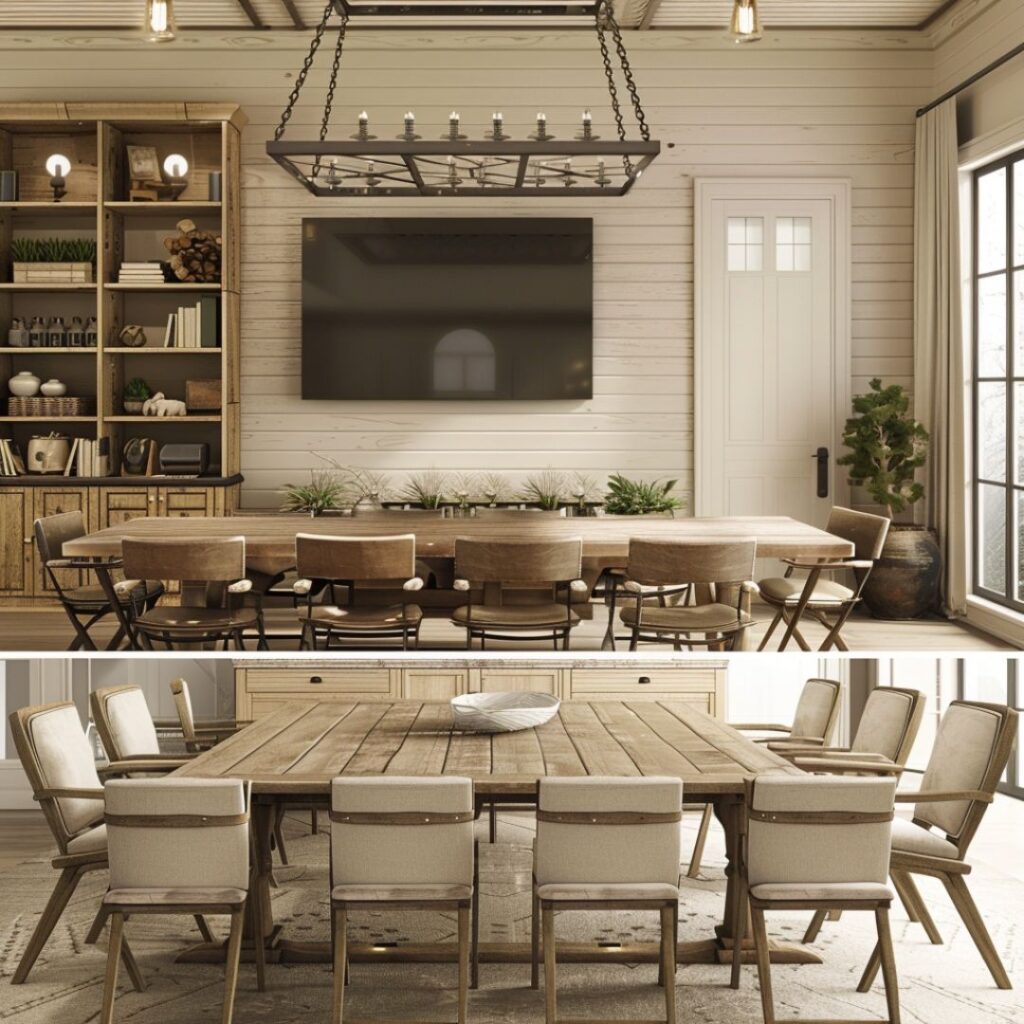
Industrial Farmhouse
Industrial Farmhouse draws inspiration from heavy machinery used on farms. It features industrial lighting, cool metals, and natural wood. You’ll see exposed beams, warm colors, black and off-white accents. Edison bulb pendants add a rustic touch alongside thick wooden elements and blackened iron structures.
Coastal Farmhouse
Coastal Farmhouse blends beachy vibes with modern farmhouse elements. Think oceanic references paired with white oak flooring and classic millwork details. Warm metals like brass and gold mix well with seagrass and rattan pieces. Polished nickel or chrome hardware adds a sleek finish.
Scandinavian Farmhouse
Scandinavian Farmhouse emphasizes minimalism and simplicity. Natural materials dominate the space along with clean-lined furniture and simple woodwork. Light wood flooring pairs perfectly with black or gray accents, while muted shades of color keep the ambiance serene.
Modern Farmhouse
Modern Farmhouse takes traditional farmhouse design to a cleaner, more simplified level without losing character. Shiplap remains popular along with barn doors for that iconic look. Updates include wide plank floors, open-concept living spaces, and sleek lighting options.
Farmhouses are known for their neutral color palettes inspired by nature. Raw wood elements feature prominently in every room alongside greenery to bring the outside in. When adding pops of color consider deep navy, sage green, or burnt orange for an earthy feel.
#15. Shabby Chic

Shabby Chic is an interior design style that blends vintage, rustic, and romantic elements. Originating in the 18th century, it has evolved into a timeless look. The color palette features soft pastels like whites, creams, pale pinks, light blues, and greens. These hues create a light and airy feel.
Furniture in this style often appears distressed or weathered. Techniques like sanding and painting give pieces an aged look. It’s common to see vintage furniture passed down through generations with each adding their touch.
Architectural features play a significant role in Shabby Chic interiors. Wall mouldings, recessed wall niches, and textured plaster finishes add depth to rooms. These elements contribute to a cozy yet elegant atmosphere.
Textiles are essential in achieving the Shabby Chic aesthetic. Fabrics such as lace, linen, cotton, chenille, calico, and velvet are commonly used. They often feature floral or botanical designs which enhance the romantic vibe.
Lighting should be soft to complement the nostalgic ambiance of this style. Vintage or antique fixtures are popular choices for creating warm and inviting spaces.
Overall Shabby Chic captures an elegant yet lived-in look that feels both comfortable and stylish at once.
#16. Art Deco
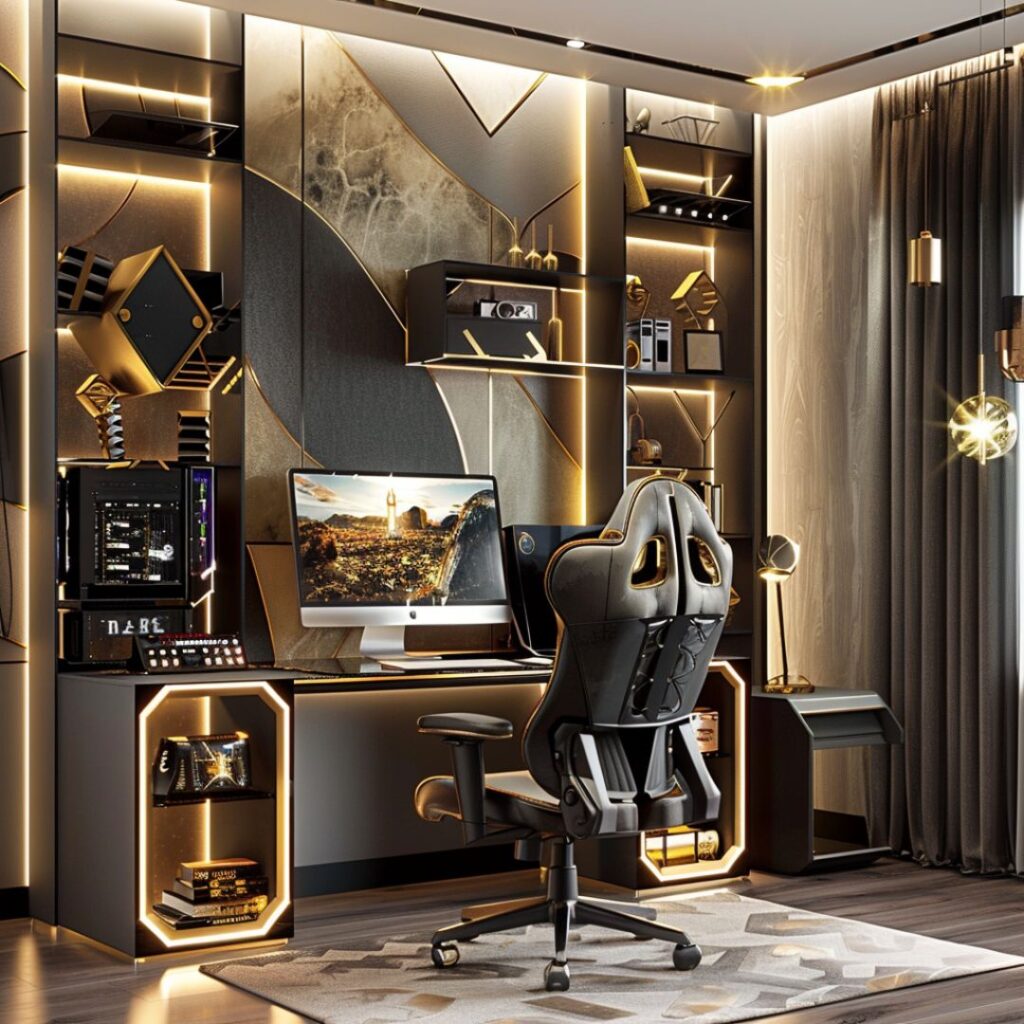
Art Deco is a prominent interior design style known for its opulent and luxurious aesthetic.
History and Origins
Art Deco, short for Arts Décoratifs, started in France in the early 1900s. It gained traction globally in the 1920s to 1940s. This style was showcased at the Exposition Internationale des Arts Décoratifs et Industriels Modernes in Paris in 1925.
Key Elements
- Colors: Bold colors dominate this style. Think bright yellows, reds, greens, blues, and pinks paired with silver or black. For softer hues, use creams and beiges.
- Furniture: Go big with large-scale furniture that’s streamlined without intricate details. Use materials like exotic woods, chrome, mirrors, and lacquer for that luxe feel.
- Fabrics: Stick to solid colors or geometric patterns. Luxurious materials such as velvet and shark skin shine here. Avoid florals and plaids—this isn’t their stage.
Notable Materials
Metal is a staple of Art Deco design due to industrial revolution influences. Glass also plays a significant role; mirrored surfaces add elegance while reflecting modernity’s fascination.
Design Examples
Picture oversized armories or sofas with pointed edges and jagged corners—classic hallmarks of Art Deco design.
Location Inspiration
Miami Beach stands as a beacon for Art Deco inspiration today. Its vibrant displays perfectly capture this iconic style’s essence.
#17. Vintage

Vintage interior design evokes a sense of nostalgia and timeless charm, drawing inspiration from past eras.
History and Origins
While the term “vintage” encompasses various time periods, it generally refers to styles from the mid-20th century onwards. The popularity of vintage aesthetics surged in recent years, driven by a desire to reconnect with past decades and their unique character.
Key Elements
- Colors: A soft and muted palette is characteristic of vintage style. Think pastel shades of pink, blue, green, and yellow, complemented by neutrals like cream, beige, and brown.
- Furniture: Rounded edges, intricate details, and a sense of comfort define vintage furniture. Materials such as wood, rattan, and upholstery fabrics like velvet and linen are essential. Sofas, armchairs, and coffee tables often feature curved lines and ornate accents.
- Fabrics: Floral patterns, polka dots, stripes, and gingham are common fabric choices. Soft textures like cotton, linen, and lace add to the vintage appeal.
- Notable Materials: Wood is a dominant material in vintage design, often featuring warm tones and natural finishes. Metal accents, particularly brass and copper, can add a touch of glamour.
Design Examples
Picture a living room with a plush velvet sofa, a coffee table adorned with family photos, and a record player in the corner. Incorporate antique or vintage-inspired accessories like decorative vases, clocks, and artwork to complete the look.
Location Inspiration
Cities like London, Paris, and New York offer a wealth of inspiration for vintage interior design. Explore antique shops, flea markets, and vintage stores to discover unique pieces that can bring your space to life.
By blending old and new elements, vintage style creates a warm and inviting atmosphere that celebrates the beauty of the past.
#18. Eclectic

Eclectic interior design masterfully mixes elements from different styles to create a vibrant, layered look. This style is all about combining various textures, patterns, and influences to form a cohesive yet visually intriguing space.
Characteristics
- Mixed Patterns: Use geometric shapes, polka dots, and floral prints together. Mixing these can add depth and excitement.
- Global Influences: Incorporate decor from different cultures. Think Moroccan rugs or Japanese ceramics.
- Old and New: Blend vintage items with modern pieces. A retro armchair next to a sleek coffee table creates balance.
- Unexpected Decor: Add personality with unconventional items. A trunk as a coffee table or an antique ladder as a bookshelf can be striking.
- Choose a Core Color Palette: Start with neutral tones like beige or gray. Add pops of color through accent pieces for harmony.
- Avoid Over-Cluttering: Keep the space balanced by not filling every inch. Too much clutter can make your home feel chaotic.
- Blend Different Eras and Styles: Pick items that span various design periods. This adds richness without overwhelming the senses.
#19. Hollywood Regency

Hollywood Regency is a maximalist interior design style that emerged in mid-20th century California. Known for its bold and glamorous aesthetic, this style combines vibrant colors, classic furniture shapes, metallic finishes, fantastical elements, and luxurious accents.
Vibrant Colors
Hollywood Regency uses bright and bold colors like pink, turquoise, yellow, emerald green, black, and white. These hues create a lively atmosphere. Think of pairing a bold pink sofa with turquoise cushions or using emerald green drapes against a neutral wall.
Classic Furniture Shapes
The furniture often features timeless designs from various periods. Mid-century modern pieces like slipper chairs fit seamlessly alongside Neo-Classical items such as Chippendale chairs. This mixture brings an elegant yet eclectic feel to your space.
Metallic and Natural Finishes
Furniture in this style commonly displays finishes in white, black, metallics like gold or silver, and natural wood tones. A glossy black console table paired with gold-framed mirrors can elevate the room’s sophistication.
Fantastical Elements
Incorporate whimsical touches to evoke luxury and travel vibes. Items like palm fronds wallpaper or bamboo light fixtures add exotic flair. Animal prints on rugs or cushions introduce playful dynamics into the decor.
Glamorous Accents
Glamorous details are key to Hollywood Regency’s charm. Chandeliers provide opulent lighting while traditional chests add character. Chinoiserie wallpaper offers intricate patterns that enhance the overall elegance of your interiors.
#20. Zen
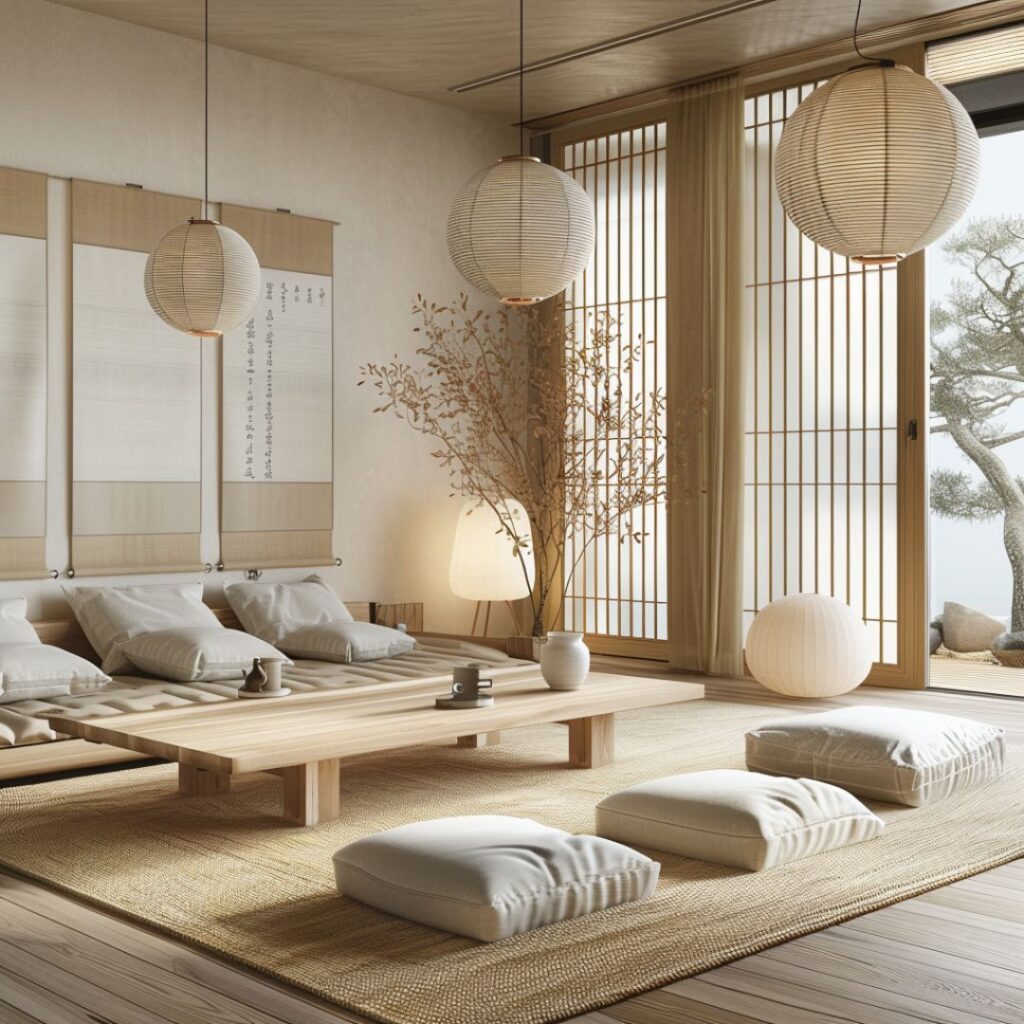
Zen-inspired interior design focuses on creating a peaceful and harmonious environment. Open spaces are essential, providing emotional freedom and mental clarity. Minimalism is key, emphasizing quality over quantity with carefully chosen furniture pieces.
Natural light plays a significant role in this style. Soft, diffused lighting connects you to nature and enhances the ambiance. Neutral color palettes dominated by whites, beiges, and soft grays contribute to the tranquil atmosphere.
Incorporate elements like asymmetrical layouts and natural materials. Use curtain walls or door panels to separate large spaces while maintaining privacy. Opt for shapes inspired by nature rather than geometric ones for a more serene feel.
Asian Zen interiors often feature references to nature through their decor choices. Feng Shui principles are commonly applied to create balance and relaxation within the space. This holistic approach makes your home not just stylish but also calming.
By focusing on these aspects, you can transform your living areas into serene havens that promote relaxation and well-being.
#21. Asian
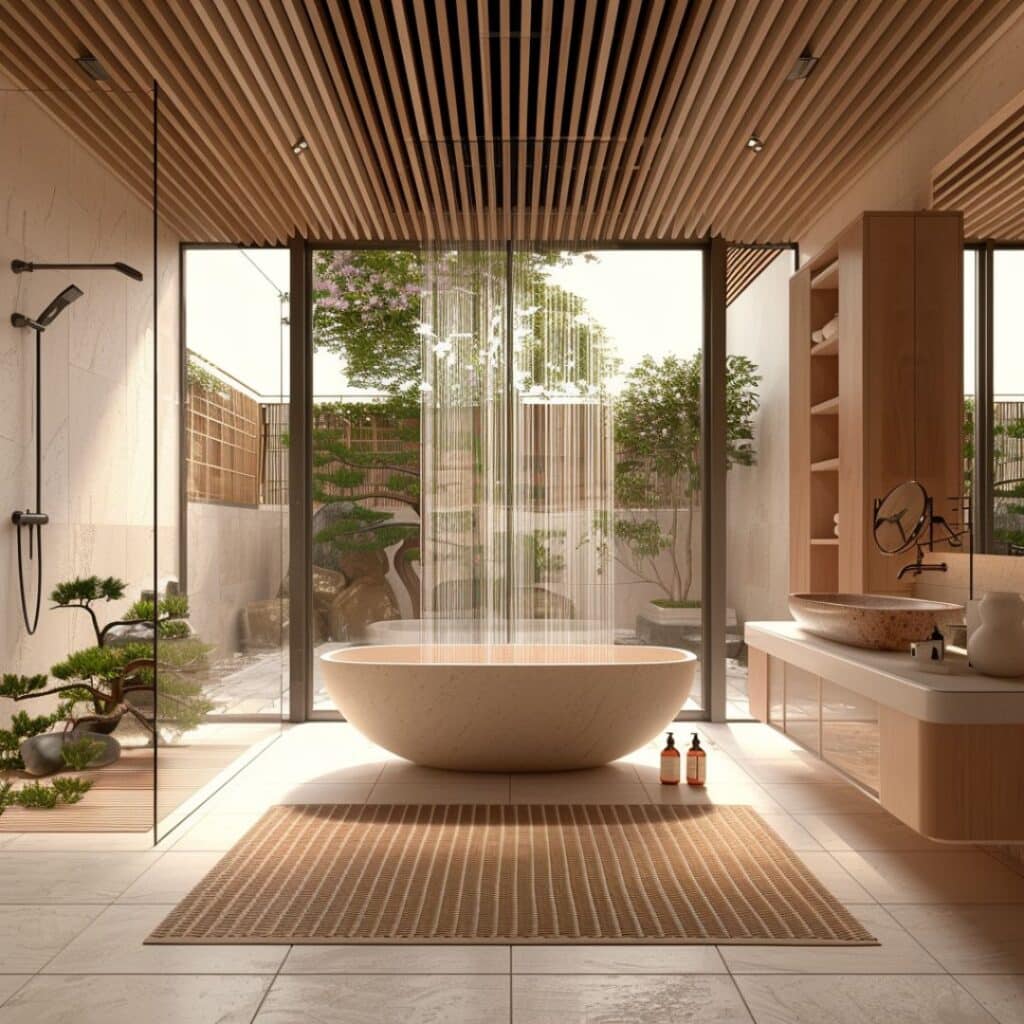
Asian interior design, also known as Oriental design, blends elements from various Eastern Asian countries like Japan, China, Vietnam, Thailand, and Malaysia. This style focuses on creating tranquil spaces with natural materials and minimal decor.
Neutral Color Palette
Asian interiors often feature a neutral color scheme. You’ll see shades of white, cream, beige, brown, sage green, and muted blue. These colors create a calm and serene atmosphere in any room.
Natural Materials
The use of natural materials is prominent in Asian design. Hardwood floors or bamboo accents can add warmth to your space. Stone elements or rattan furniture bring an earthy touch that’s hard to replicate with synthetic materials.
Floral and Nature-Inspired Motifs
Floral patterns and nature-inspired motifs are common in this style. Think cherry blossom designs or bamboo prints on wall art or textiles. They help connect indoor spaces with the outdoors.
Chinoiserie Furniture
Chinoiserie furniture adds an elegant touch to Asian interiors. This style features detailed scenes painted on dark lacquer-like wood. It’s a beautiful way to incorporate intricate artistry into your home design.
By focusing on these key elements—neutral colors, natural materials, floral motifs, and Chinoiserie furniture—you can create a harmonious space that embodies the essence of Asian interior design.
#22. Moroccan
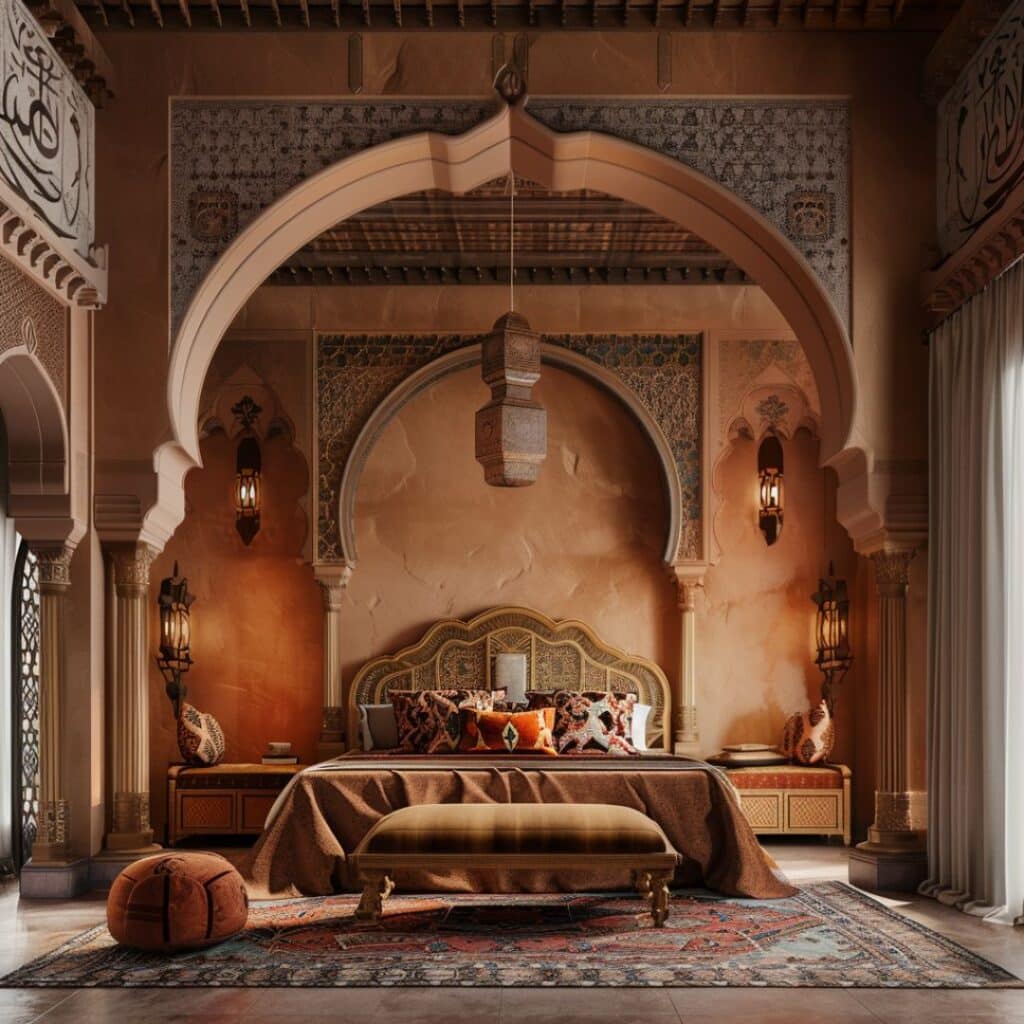
Colors
Moroccan interior design uses deep terracottas, indigos, greens, golds, pinks, and purples. These colors are often combined boldly for a vibrant look. Neutral shades like sand, taupe, beige, and white also feature in contemporary Moroccan designs.
Textures
Layered textiles are key in Moroccan style. You’ll see silks and gauze-like fabrics dividing rooms or framing windows. Intricately carved wooden furniture and woven kilim rugs add depth and richness to the space.
Patterns
Islamic geometric patterns are central to Moroccan decor. Zillij tiles and intricate mosaics create stunning visual effects. Berber rugs with their abstract prints are also a staple in this design style.
Moroccan interior design seamlessly blends various elements to create an inviting atmosphere rich in culture and history.
#23. Tropical
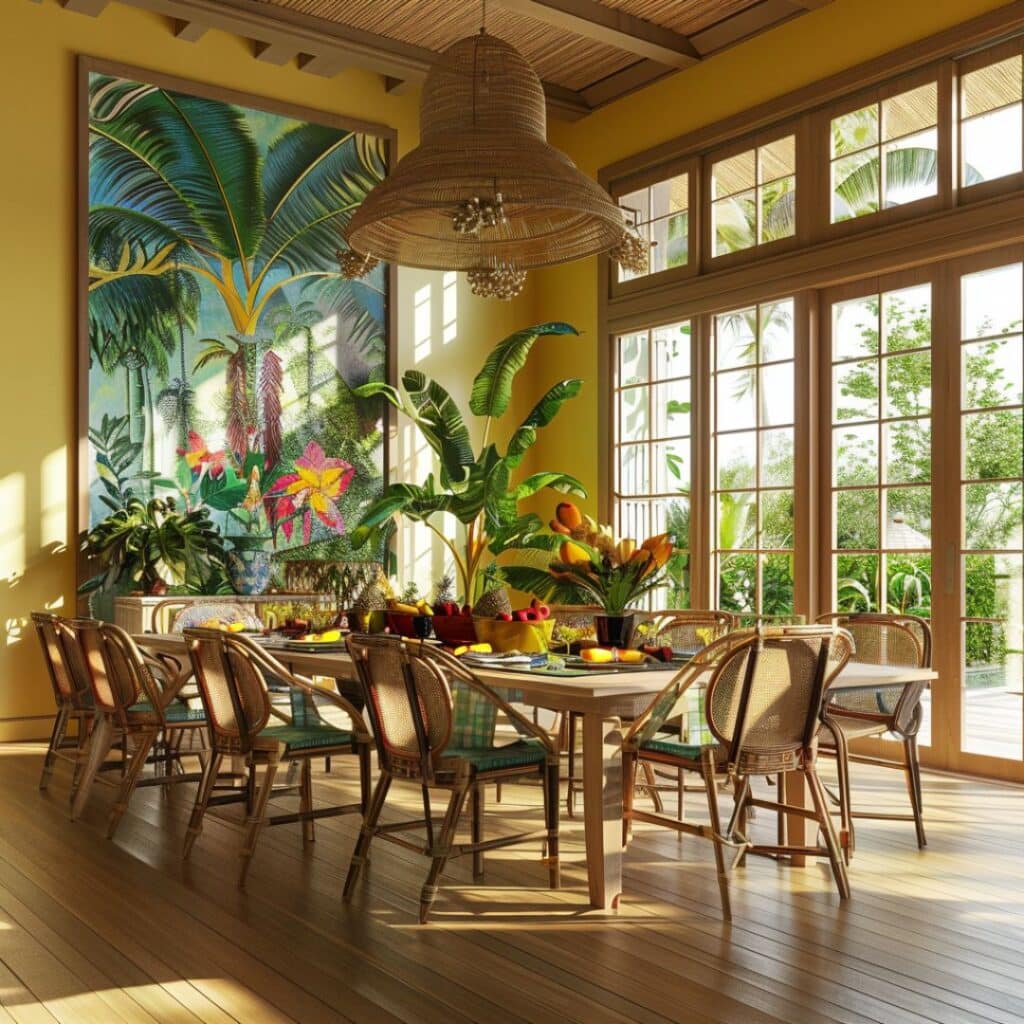
Tropical interior design brings the essence of a lush paradise into your home. The following key elements will help you achieve this vibrant style:
- Natural Materials: Use rattan, cane, bamboo, and silk to create an eco-friendly and natural vibe.
- Plants: Add palm trees, cacti, and snake plants for fresh air and a lively atmosphere.
- Leaf Motifs: Incorporate prints featuring banana leaves, fan palm leaves, and areca palm leaves for that tropical touch.
- Tropical Lighting: Choose fixtures made from parchment paper, wicker, twigs, or seagrass weaves to set a neutral tone.
- Color Palette: Opt for bright colors like pink, blue, green, and yellow to evoke a tropical environment.
#24. Southwestern
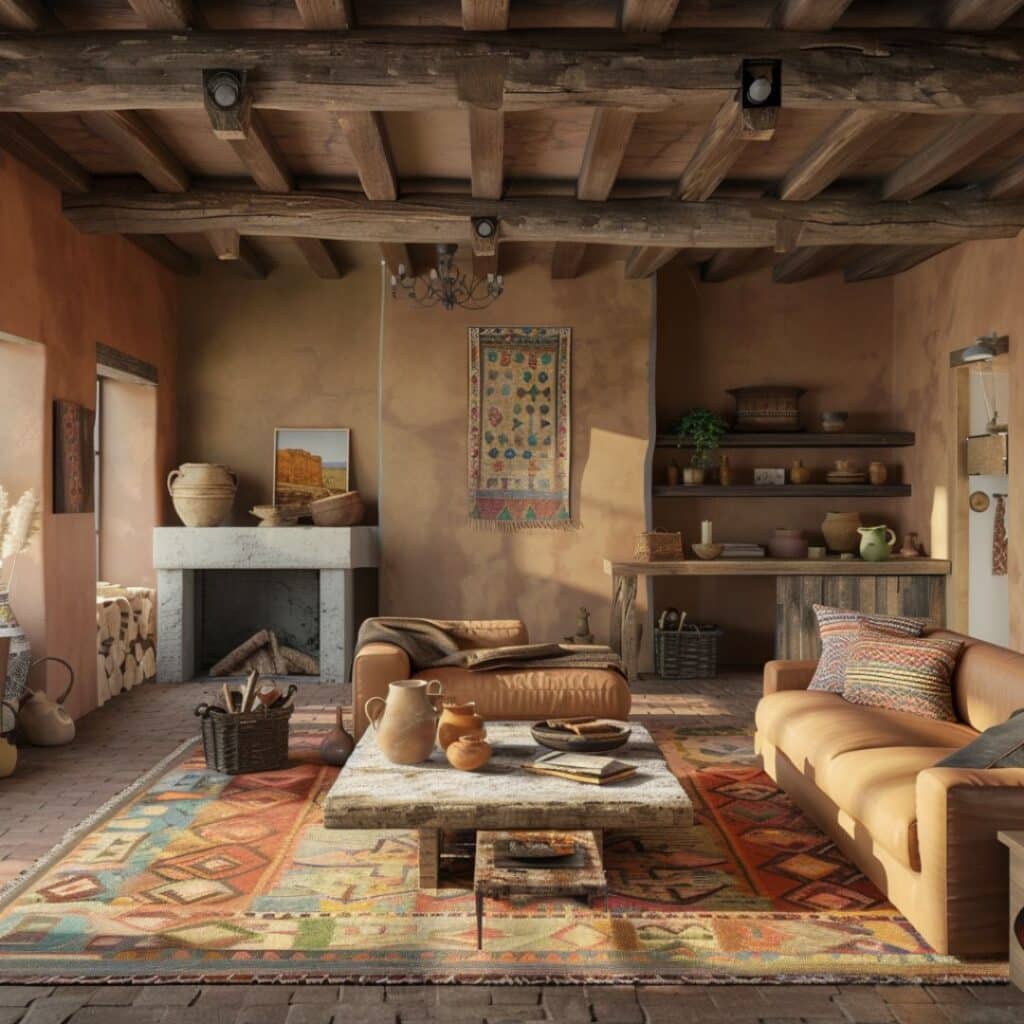
Southwestern interior design draws inspiration from the American Southwest, featuring Native American and Spanish influences. This style often incorporates earthy tones like terracotta and rust, reflecting the region’s natural landscape. You’ll also see vibrant colors like turquoise, reminiscent of the desert sky.
Color Palette
Earthy tones dominate this style. Think terracotta, rust, sandy beige, and muted greens. These colors mirror the natural scenery of the Southwest. Additionally, vibrant shades like turquoise add a touch of brightness to your space.
Materials and Textures
Natural materials are key here. Wood, stone, leather, and wrought iron add warmth and texture. Ceramic tiles and Saltillo tiles are popular for their warm hues and practicality. Woven textiles with geometric patterns contribute to an authentic feel.
Furniture and Accents
Rustic wooden furniture is a staple. Often distressed or vintage-looking pieces bring authenticity to your decor. Hammered metals like copper or brass work well for light fixtures and accents.
By embedding these elements into your home decor, you can create a warm yet lively Southwestern ambiance that reflects both tradition and modernity.
#25. Victorian

Victorian interior design exudes opulence and grandeur from the late 19th century. You’ll find an abundance of patterns, ornamentation, and jewel tones that characterize this style.
Pattern and Ornamentation
Patterns play a vital role in Victorian interiors. Walls, floors, and furniture are adorned with plaids, stripes, florals, and leaf motifs. These intricate designs create a visually rich environment.
Jewel Tones
Rich colors like reds, greens, blues, and browns dominate Victorian spaces. These deep shades add a sense of luxury and elegance to any room.
Furniture
Furniture pieces are often large and ornate with heavy carvings. Look for curved shapes in ottomans or buttoned pieces to enhance authenticity. Intricate woodwork adds another layer of complexity.
By incorporating these elements into your home decor, you can capture the essence of Victorian splendor effortlessly.
#26. Gothic
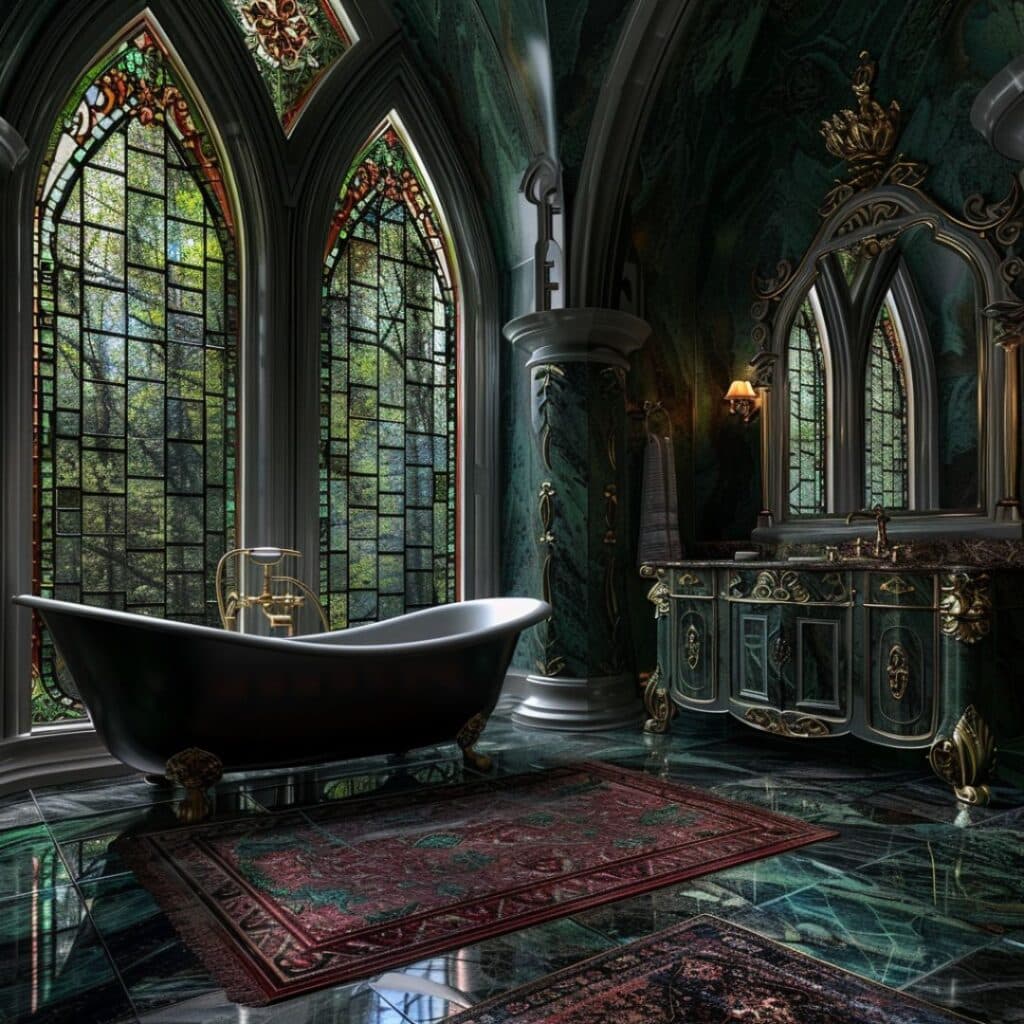
Gothic interior design draws inspiration from the architecture and art of the Middle Ages. It boasts dark, dramatic aesthetics, with rich colors like deep purples, blacks, reds, and jewel tones dominating the palette.
- Dark Colors: Rich hues such as black, deep purple, and red create a moody ambiance. These colors provide a sense of depth and drama.
- Ornate Details: Intricate carvings and moldings are common. Gargoyles, tracery, and heraldic symbols add to the elaborate decor.
- Architecture: Elements inspired by Gothic cathedrals are prevalent. Pointed arches and ribbed vaults offer architectural grandeur.
- Textures: Luxurious materials like velvet and brocade are essential. Satin and lace often adorn upholstery or curtains.
Adopting Gothic design means embracing these distinct elements for a truly dramatic look in your home.
#27. Colonial
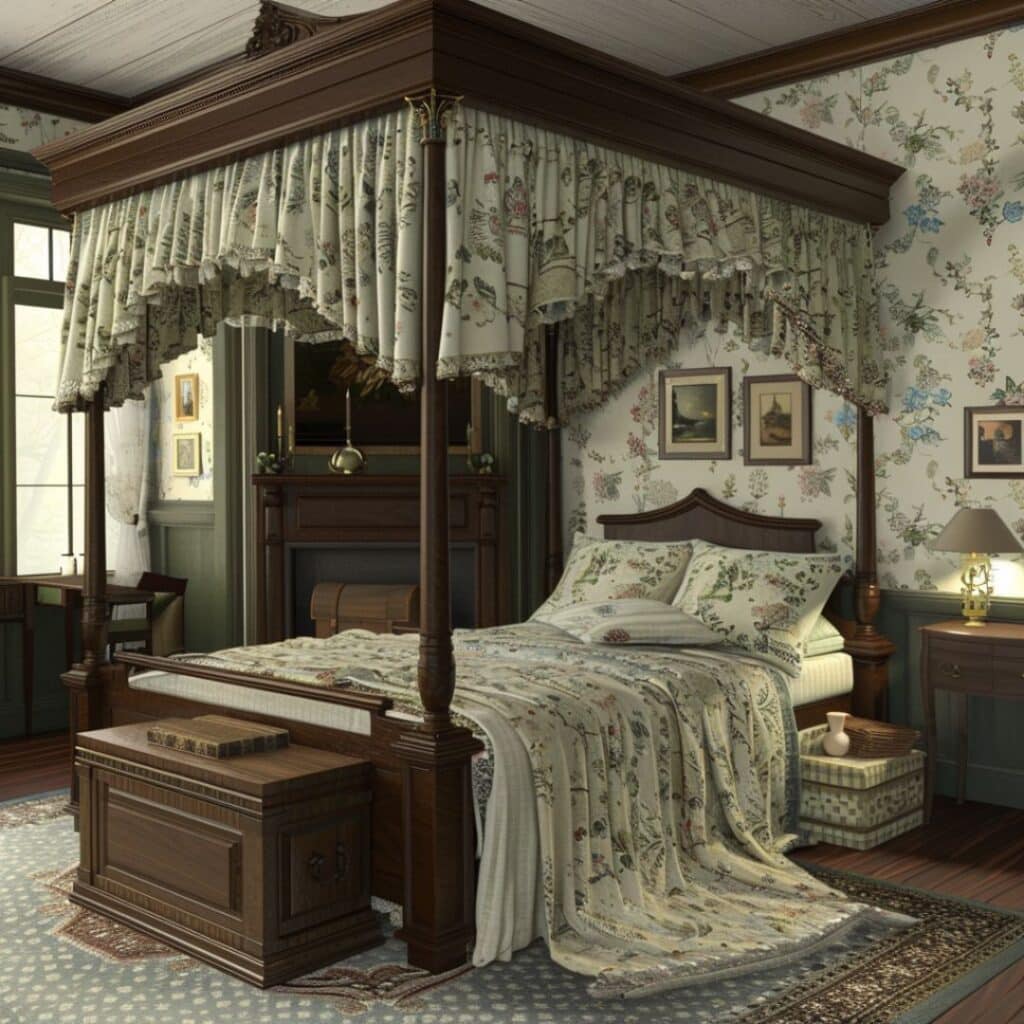
Traditional Colonial
Traditional Colonial design features soft, muted neutral tones. Think pale peaches, pinks, blues, greens, yellows, and browns. These colors bring an understated elegance to any room.
Natural materials dominate this style. You’ll see cotton, wool, linen, wood, and leather used extensively. This choice of materials adds a touch of authenticity.
Furniture in this style is handmade and utilitarian. Expect heavy pieces with straight lines like fiddle-back or ladderback chairs. Decoration is minimal but purposeful.
Decorative elements include portraiture and artwork that reflect the era. Mirrors and ornate wall sconces add a sophisticated charm to your home. Antique knick-knacks such as copper objects complete the look.
New Colonial
New Colonial introduces earthy tones alongside blues and greens. The focus remains on warm colors that create a pleasant atmosphere.
While it retains some traditional aspects, New Colonial incorporates modern comforts seamlessly. This balance offers both visual appeal and functionality suitable for contemporary living spaces.
By embracing these elements in your home decor you achieve a blend of historical richness with modern-day comfort without overwhelming the senses.
#28. Tuscan
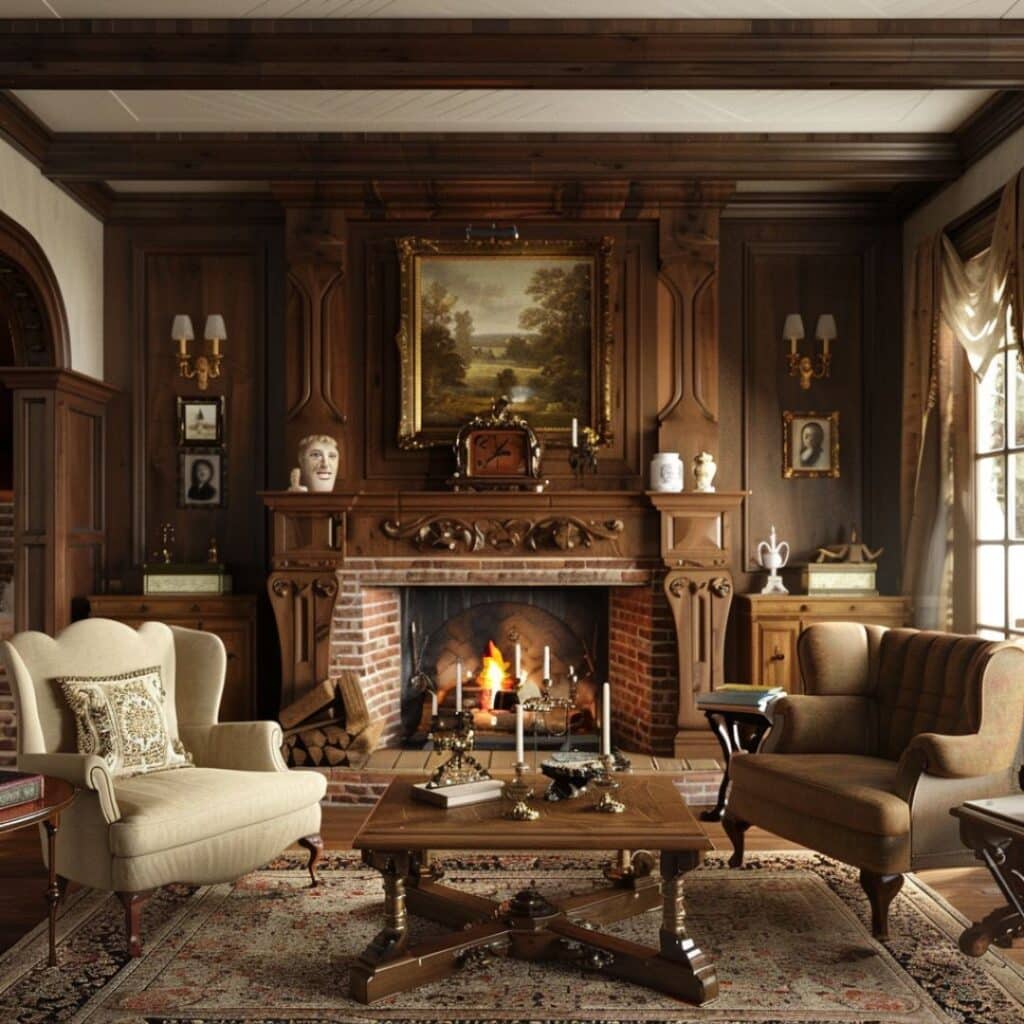
Tuscan interior design captures the rustic charm and warmth of Tuscany, Italy. It incorporates natural materials like stone, wood, and terracotta to create an inviting atmosphere.
- Natural Materials: Use stone walls, wooden beams, and terracotta tiles to bring the outdoors inside. These earthy elements form the backbone of Tuscan style.
- Earth Tones: The color palette includes warm yellows, beiges, browns, and terracottas—reminiscent of sunbaked Tuscan landscapes. These tones evoke a sense of coziness.
- Textured Ceilings: Vaulted or paneled ceilings with exposed wooden beams add depth and warmth to your space. They’re visually striking yet functional.
- Mosaic Flooring: Incorporate glass and stone tiles in intricate patterns on floors for a touch of elegance. Mosaics often complement terracotta flooring beautifully.
- Decorative Accents: Integrate wrought iron details, carved marble pieces, and ornate accessories throughout your home for added character. These accents enhance the overall aesthetic without overwhelming it.
Each aspect works together seamlessly to create a warm and welcoming environment that reflects the essence of Tuscany in your home.
#29. Spanish
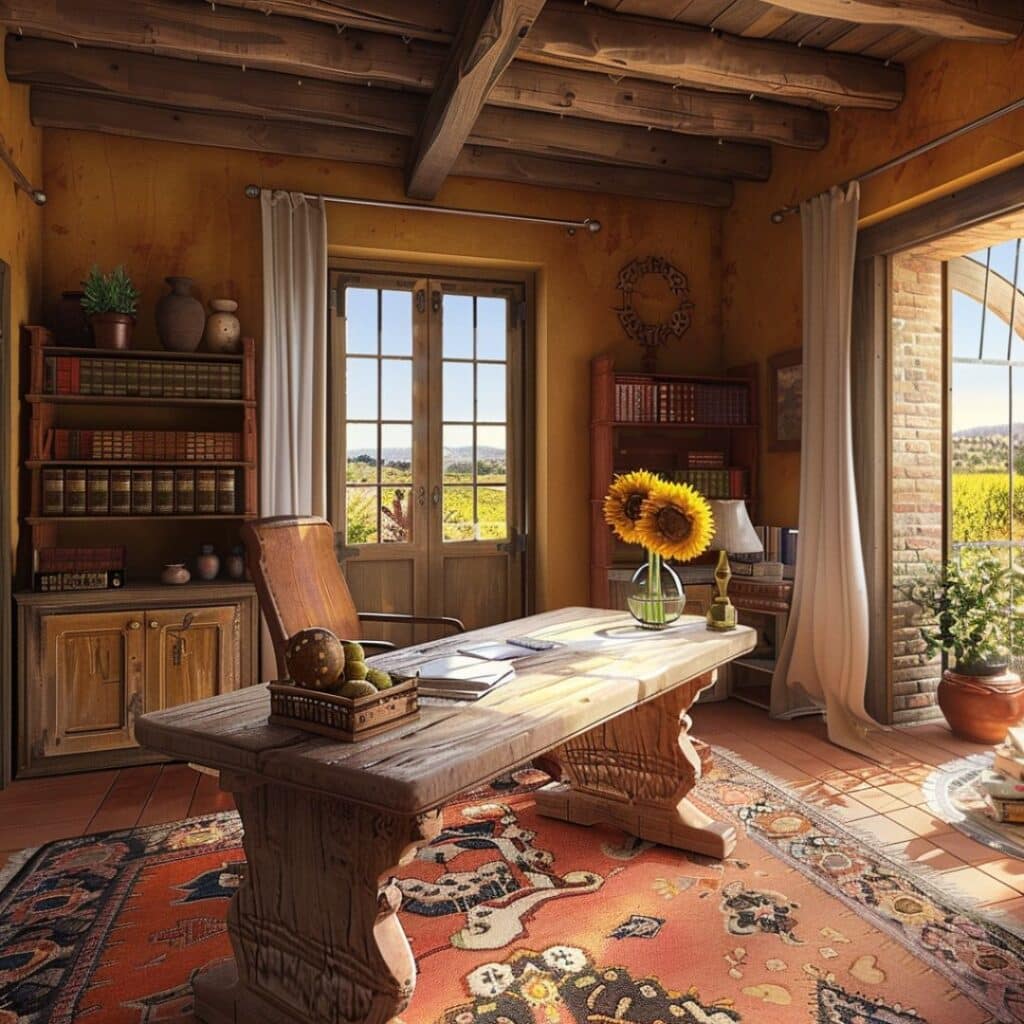
Traditional Spanish Style
Traditional Spanish interior design showcases rustic elements. You’ll often see exposed wooden beams, stone walls, and terracotta tiles. These materials add warmth and character to any space.
Warm colors dominate this style. Think earthy tones like terracotta, saffron, and olive. These hues create a cozy and inviting atmosphere.
Ornate details are also key features. Intricate carvings, wrought iron accents, and elaborate furnishings are common. They add elegance and a touch of history to your home.
Outdoor living is emphasized in traditional Spanish homes. Courtyards and expansive terraces offer perfect spots for al fresco dining or relaxing.
Spanish Modern Interior Design
Spanish modern design blends old-world charm with modern minimalism. Clean lines meet natural materials like wood, stone, and terracotta tiles for a balanced look.
An organic flair is present throughout the space. Natural textures bring depth while maintaining simplicity.
The color palette mixes warm hues with cooler tones. Terracotta pairs well with deep blues and greens, creating a harmonious yet dynamic environment.
#30. Urban Modern
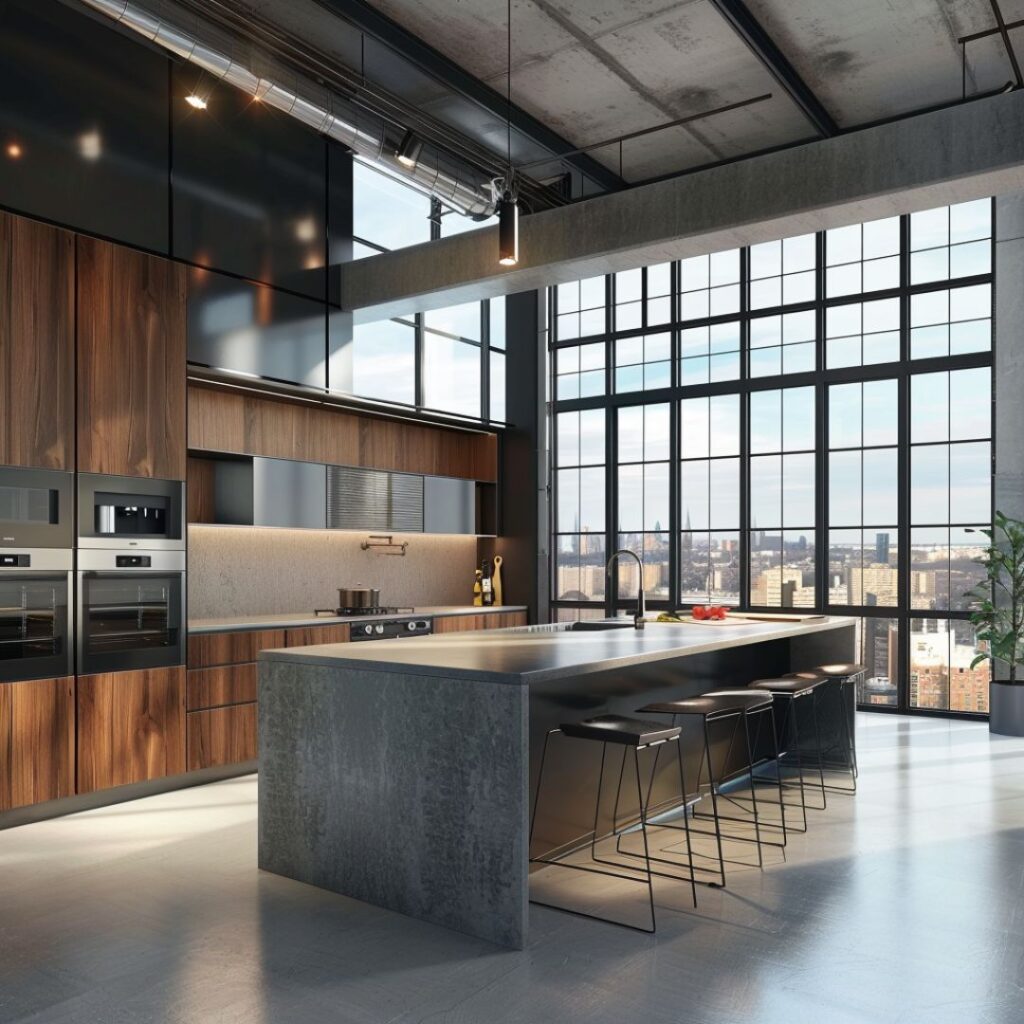
Urban modern interior design combines contemporary, industrial, and modern elements for a trendy look. It emphasizes comfort with plush furniture and warm colors. Large windows and steel-framed shelves add an urban touch.
Blending styles is key in urban modern decor. You’ll find sleek metal legs on chairs paired with soft upholstery, creating a balance between hard and soft materials.
Contrasting materials also play a big role. Picture metallic frames next to wooden tables or concrete floors softened by fluffy rugs.
Scale and proportion are essential. Mix large sofas with small side tables to create visual interest in your space.
For apartment dwellers, this style offers both minimalism and warmth. Incorporate cozy textiles like thick blankets or cushioned seating while maintaining clean lines and open spaces.
#31. Cottage
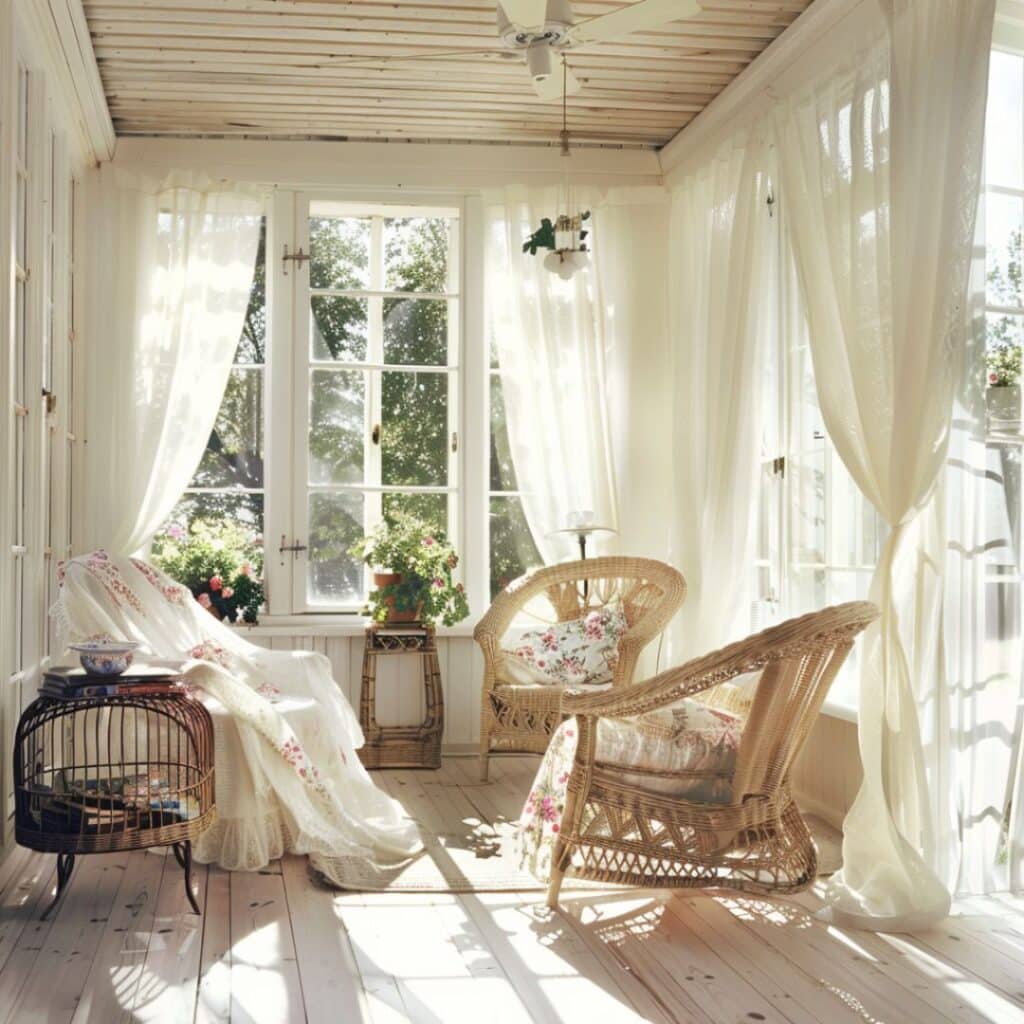
English Cottage Style:
- Architecture: Small houses with cozy nooks, slanted attic ceilings, and exposed beams. Walls often feature tongue and groove paneling, wallpaper, brick, or stone. Floors use ancient brick, stone, or wide planked wood, usually covered with wool or rag rugs.
- Lighting/Furnishings: Natural lighting pairs with soft ambient glows. Lamps are ubiquitous while furniture emphasizes comfort through plush rolled-arm sofas and colorful throws and cushions.
- Color Palette/Décor: Versatile colors range from muted and natural to bright and quirky. Decor includes flowers, books, and art focusing on history and comfort over showiness.
- Architecture: Influenced by French cottage style using raw or painted woods. This style creates a relaxed atmosphere perfect for seaside living.
#32. Chalet
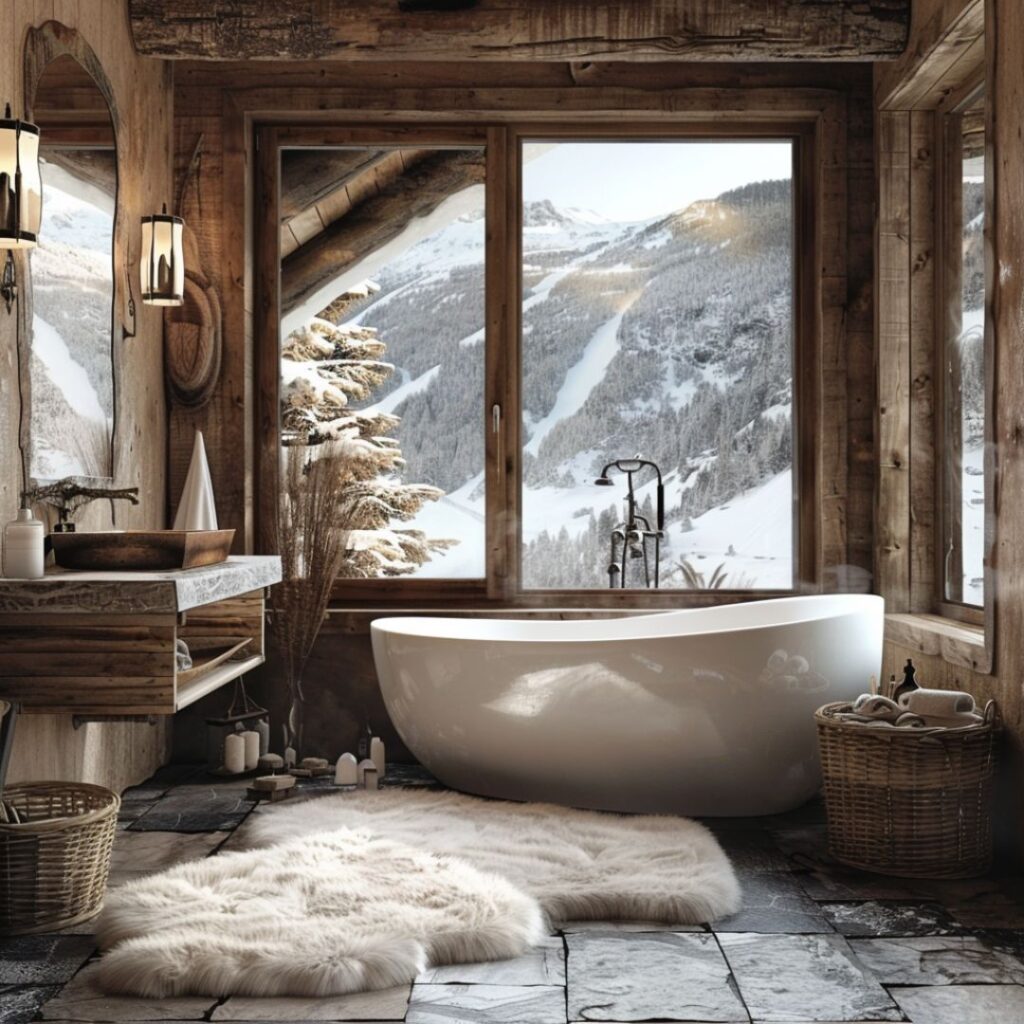
Chalet interior design brings the cozy atmosphere of alpine mountain houses into your home. This style combines rustic charm with modern comforts, often using natural materials like wood and stone.
Natural Materials
Wood and stone dominate chalet interiors. Exposed beams, timber-clad walls, and stone elements give a warm, earthy feel. Furniture often incorporates raw wood bases or petrified wood for tables.
A-Frame Architecture
Chalets feature distinctive A-frame structures. These gabled roofs shed heavy snow effortlessly while adding to the rustic aesthetic.
Overhanging Eaves
Overhanging eaves serve two purposes: protecting the home’s foundation and allowing snow to cascade gracefully from the roof.
Multiple Balconies
Multiple balconies are common in chalets. They often include ornamental carvings and moldings, providing both function and decorative appeal.
Generous Furnishings
Furniture in chalet interiors is generously proportioned. Expect heavy timbers, animal hides, and bulky pieces that make spaces feel inviting yet stylish.
Lighting Choices
Lighting typically includes cast iron or antler chandeliers. These fixtures add a touch of rugged elegance while illuminating the space effectively.
This section on chalet interior design highlights its key features which combine rustic elements with modern amenities for a cozy yet sophisticated living environment.
#33. Retro
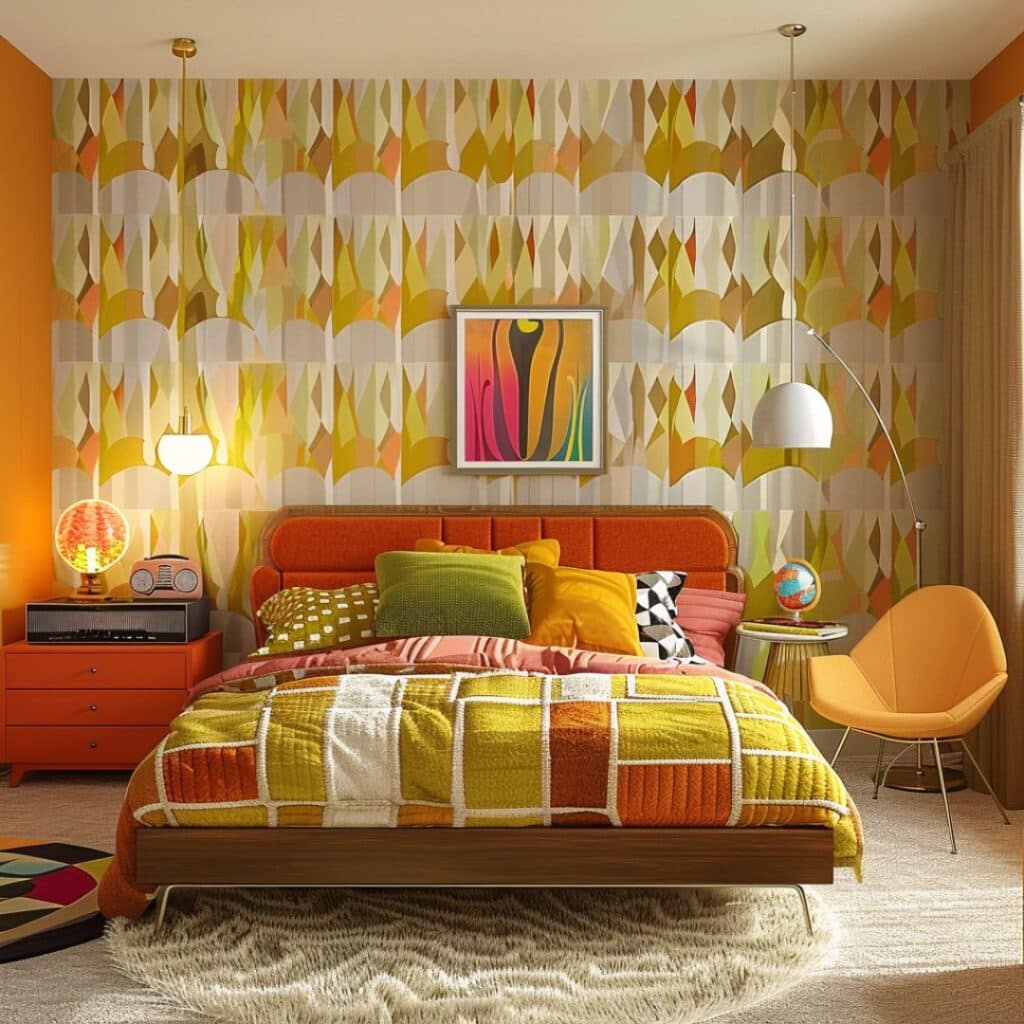
Retro interior design brings the vibrant past into modern living spaces. It’s a delightful blend of vintage and contemporary elements, often drawing inspiration from the 1950s, 1960s, and 1970s.
Vibrant Color Palette
Retro design thrives on bold colors. Think avocado green, mustard yellow, burnt orange, and deep blues. These hues bring an energetic vibe to any room.
Geometric Patterns
Patterns are a key feature in retro style. Chevrons, stripes, and polka dots appear on wallpapers and upholstery. They add visual interest without overwhelming the space.
Retro Furniture
Furniture in retro design is distinct for its clean lines and simple shapes. Pieces are functional yet stylish. Look for items with mid-century designs to complete your retro look.
By incorporating these elements—vibrant colors, geometric patterns, and iconic furniture—you can create a lively retro-inspired space that feels both nostalgic and fresh.
#34. Futuristic
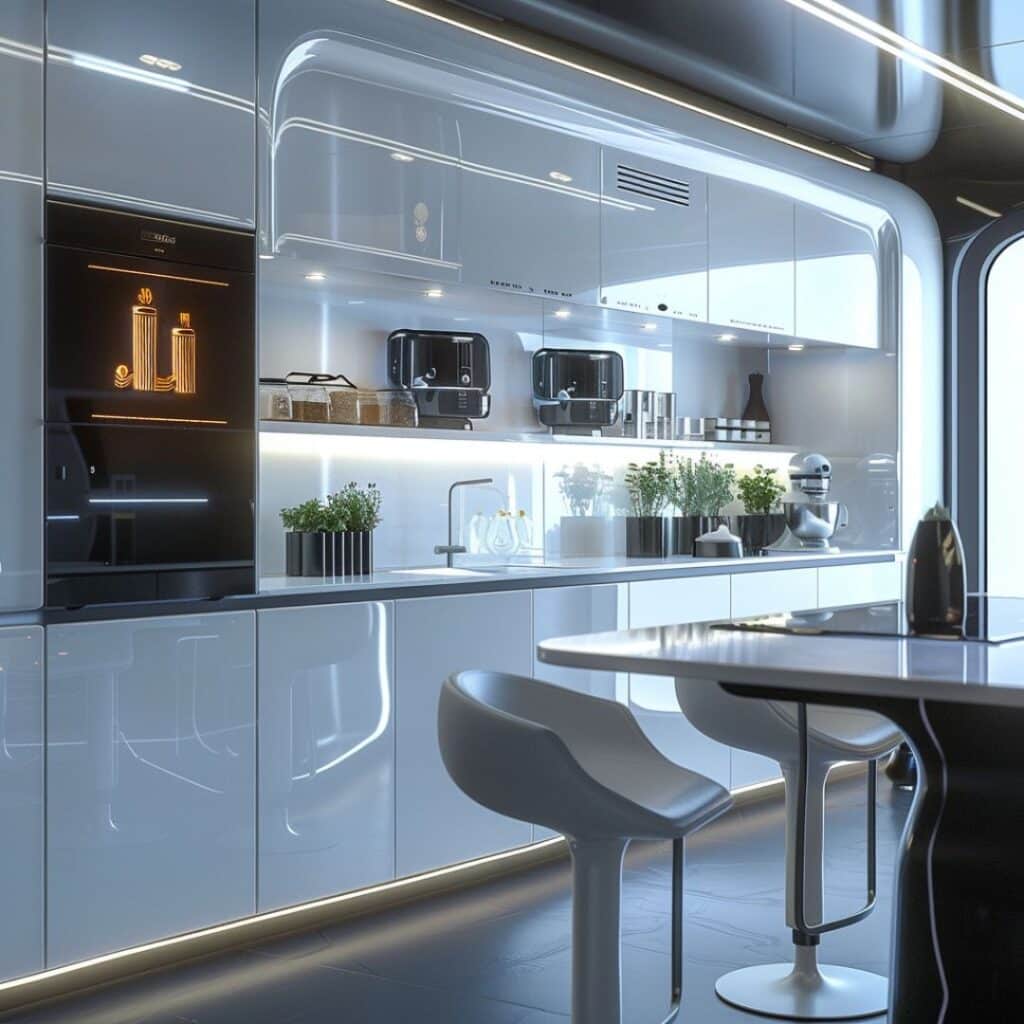
Futuristic interior design is all about clean lines and cutting-edge elements. It emphasizes simplicity with curved or angular shapes, using materials like glass, metal, plastic, or leather.
Minimalist Creativity
This style focuses on minimalism. You’ll often see spaces that are sleek and uncluttered. Curved or angular furnishings dominate the scene.
Geometric Shapes
Geometric shapes play a big role in futuristic interiors. Expect to find clean lines, sharp angles, and continuous curves creating a modern look.
Innovative Materials
Materials like glass, acrylic, and chrome add to the futuristic feel. These elements bring a sense of modernity and sophistication.
Smart Technology
Advanced technology is essential here. Think smart lighting systems, touch-controlled appliances, and voice-activated devices for convenience and efficiency.
#35. Avant-Garde
Avant-garde interior design is all about breaking the mold. It embraces bold and unconventional elements, pushing boundaries to create spaces that are anything but ordinary.
Unconventional Materials
Avant-garde design loves experimenting with materials. Think metal, concrete, and plastic used in unexpected ways. You may well see concrete walls paired with plush velvet furniture or a metal sculpture as a centerpiece.
Asymmetry
Asymmetry creates movement and energy in a room. Elements placed non-traditionally draw your eyes around the space. It’s not just about balance; it’s about making a powerful visual statement.
Bold Colors
Vibrant colors play a significant role in avant-garde interiors. Whether it’s an entire wall painted in bright red or splashes of neon accents, these hues bring drama and impact to any setting.
Patterns and Prints
Patterns are more than just decoration—they’re focal points. Bold prints on wallpapers or textiles add layers of visual intrigue, making each piece stand out like art.
Scale
Scale plays with perceptions by using oversized or miniature items. A giant lamp next to a tiny chair can turn heads and spark conversation, giving your space an eclectic vibe that’s truly captivating.
Avant-garde is for those who dare to be different, blending unusual elements into cohesive yet surprising designs.
#36. Bauhaus
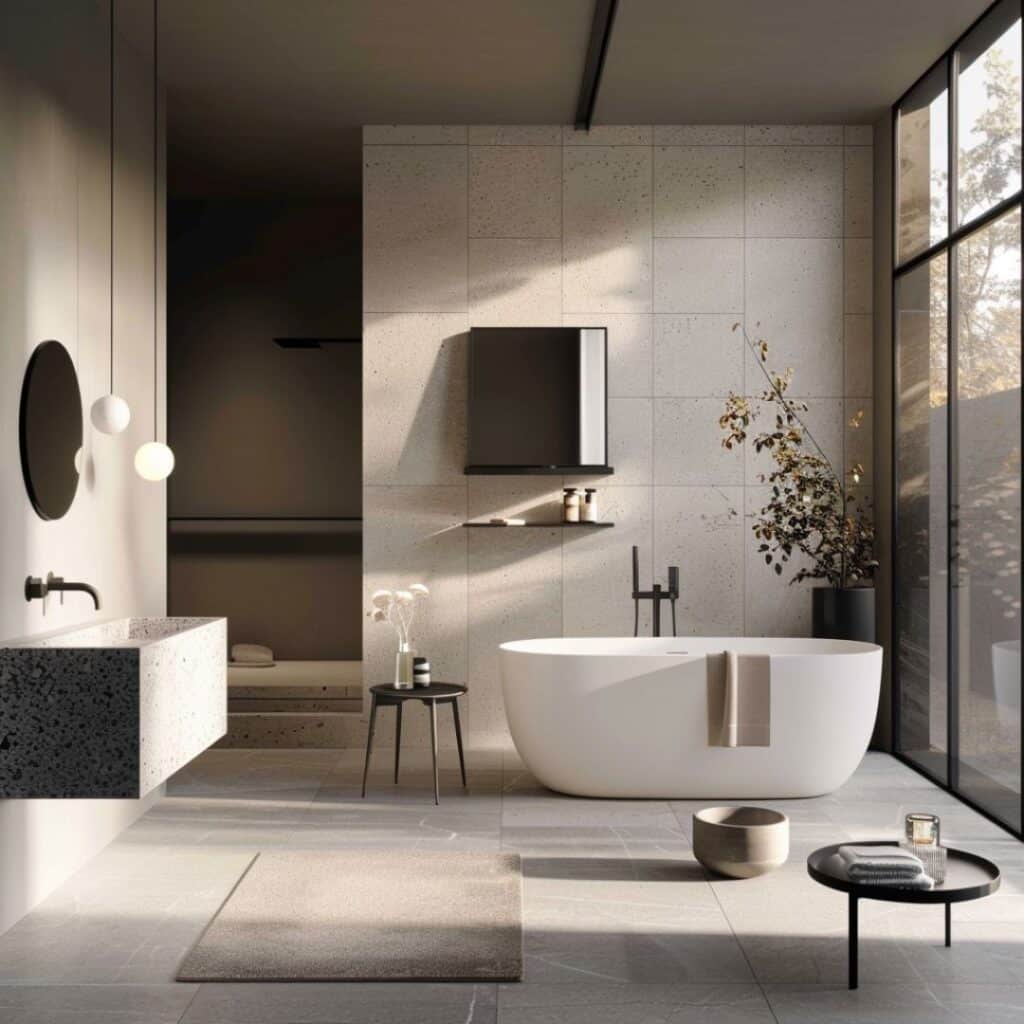
Bauhaus is a prominent interior design style that emerged in the early 20th century. It emphasizes functionality, simplicity, and rationality.
- Geometric Shapes: Bauhaus design often incorporates simple geometric forms like circles, squares, and triangles to create clean lines and balanced compositions. These shapes form the backbone of this style.
- Clean Lines: Furniture and architectural elements feature clean, minimalist lines. They reduce forms to their essential elements, eliminating ornamentation.
- Primary Colors: Bold but sparing use of primary colors (red, yellow, blue) adds visual impact. These colors create focal points within a room without overwhelming it.
- Industrial Materials: Bauhaus design often uses industrial materials such as steel, glass, and plywood. This highlights both their natural state and functionality.
Even patterns are allowed if they consist of simple geometric shapes. For Bauhaus followers, form always follows function; thus unnecessary flourishes are avoided.
A great advantage of this straightforward design is its timeless appeal. Even after a century, it can still look fresh and daring by incorporating primary colors alongside neutral palettes like black or white.
#37. Brutalist
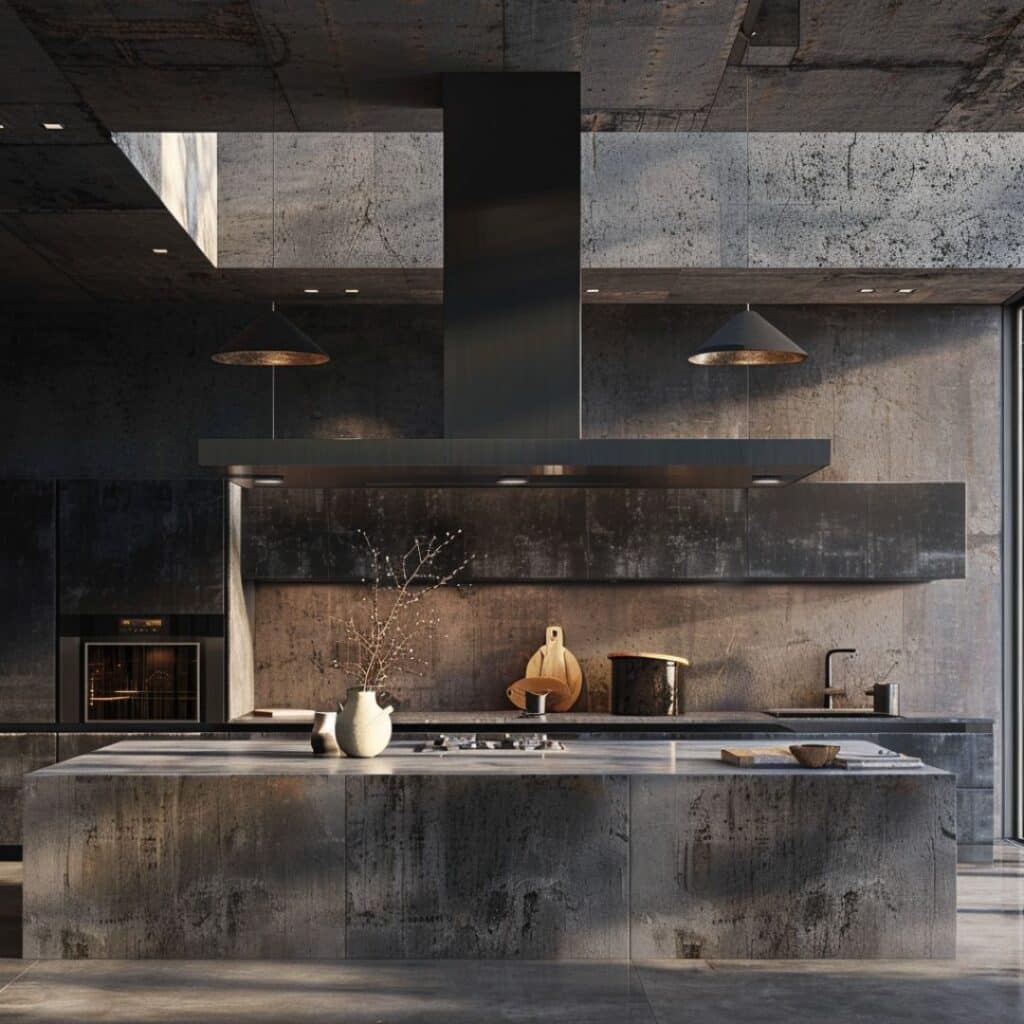
Brutalist interior design emerged in the 1950s, characterized by its industrial feel and minimalist approach. This style combines futuristic elements with modernist touches, often using robust furniture and curved details.
- Natural Flexibility: Brutalist design mixes futuristic elements with modernist touches. You’ll find robust furniture, accentuated lighting, and contrasting materials like wood.
- Materials: Concrete is a key material. It’s used for lamp bases, coffee tables, and ceramic sanitaryware. Metal elements in silver or gold add refinement to the space.
- Color Scheme: Gray tones dominate but are balanced with warm hues from wood or clay pieces.
- Shapes and Lighting: Large windows allow ample natural light. Modern artwork blends seamlessly with vintage and artisan pieces, creating an eclectic mix.
Brutalism emphasizes raw textures and materials while maintaining a functional aesthetic that’s both striking and practical.
#38. Cyberpunk
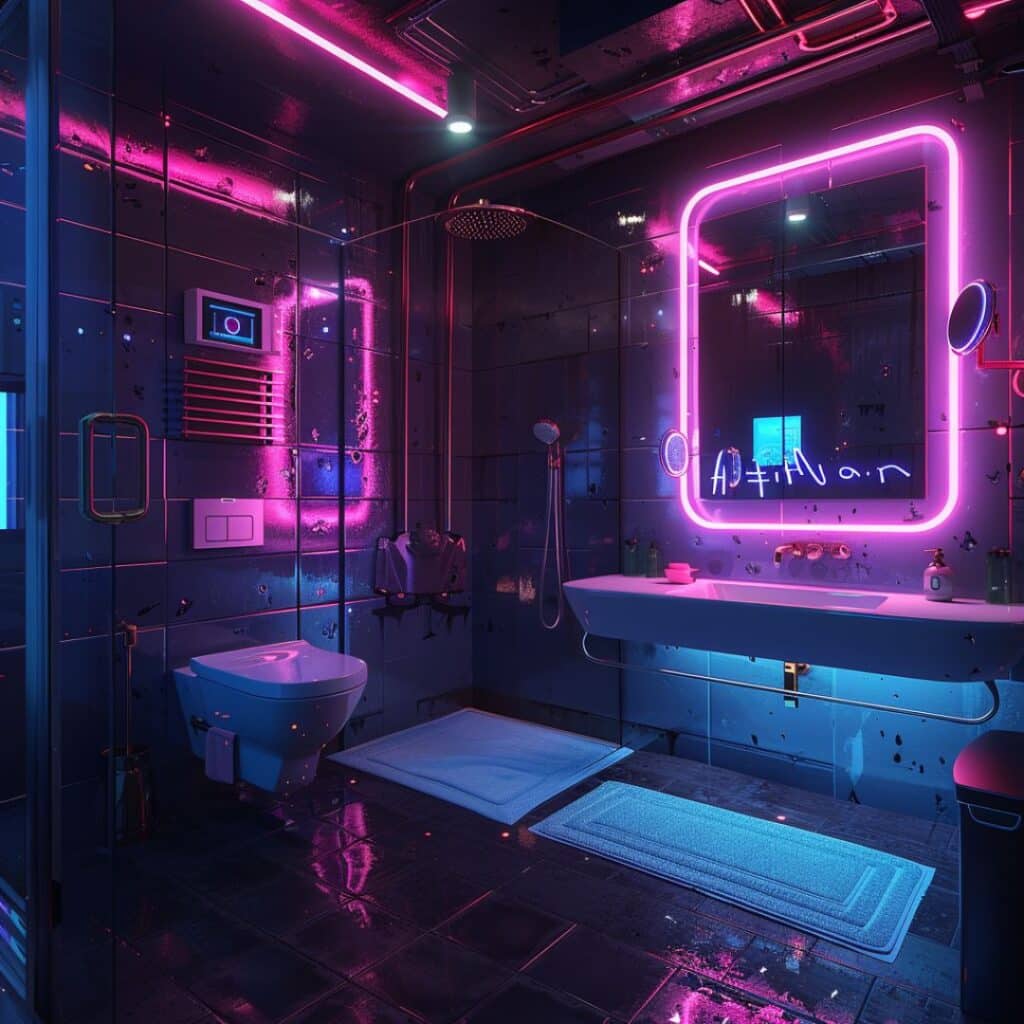
Cyberpunk interior design blends futuristic tech with gritty, industrial vibes. Vibrant neon lights in red, blue, and purple pop against dark backdrops. Think of edgy clubs or sci-fi movie sets.
Use materials like steel, concrete, and exposed brick for that raw look. These elements give spaces an intense, urban feel.
Incorporate retro-futuristic items like old computers and vintage machinery. This mix of past and future adds a nostalgic twist.
High-tech accents are key. Add holographic displays or LED lights to push the space into the future.
Create a lived-in vibe with layers of clutter, books, and personal items. It brings warmth amidst all the tech.
Cyberpunk is about contrasts—bright neons versus dark tones; high-tech gadgets within raw environments; modern ideas meeting vintage aesthetics.
#39. Steampunk
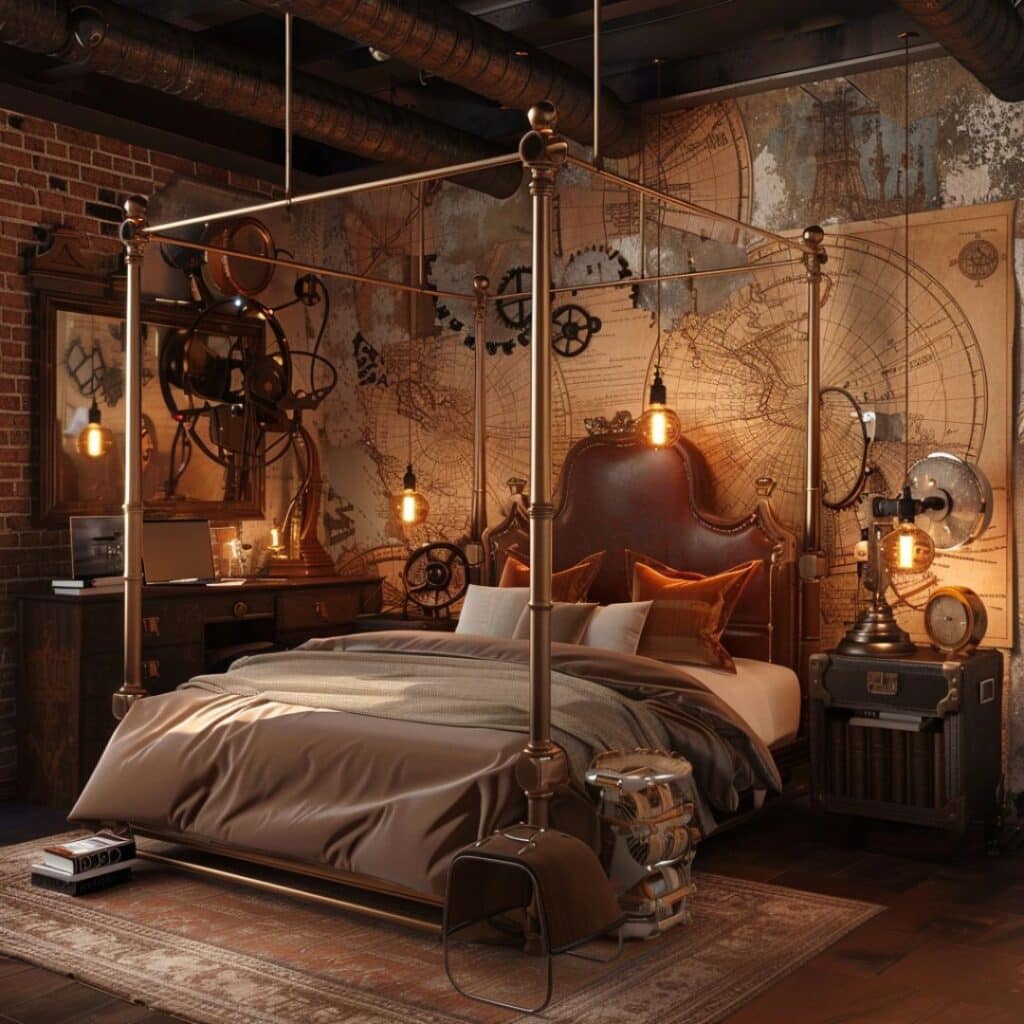
Origin
Steampunk has its roots in the 19th century. It takes inspiration from the Industrial Revolution and Victorian era. This style blends industrial machinery with elegant Victorian aesthetics.
Color Scheme
Steampunk interiors use a warm, earthy palette dominated by sepia tones. Common colors include burnt orange, deep lime, cyan, and pale violet. Dark shades like black, dark brown, and bottle green often contrast with lighter hues like cream and soft grey.
Furniture
Antique pieces with industrial details are key in Steampunk design. You’ll find dark wood, leather, and metallic accents to be popular choices.
#40. Maximalist
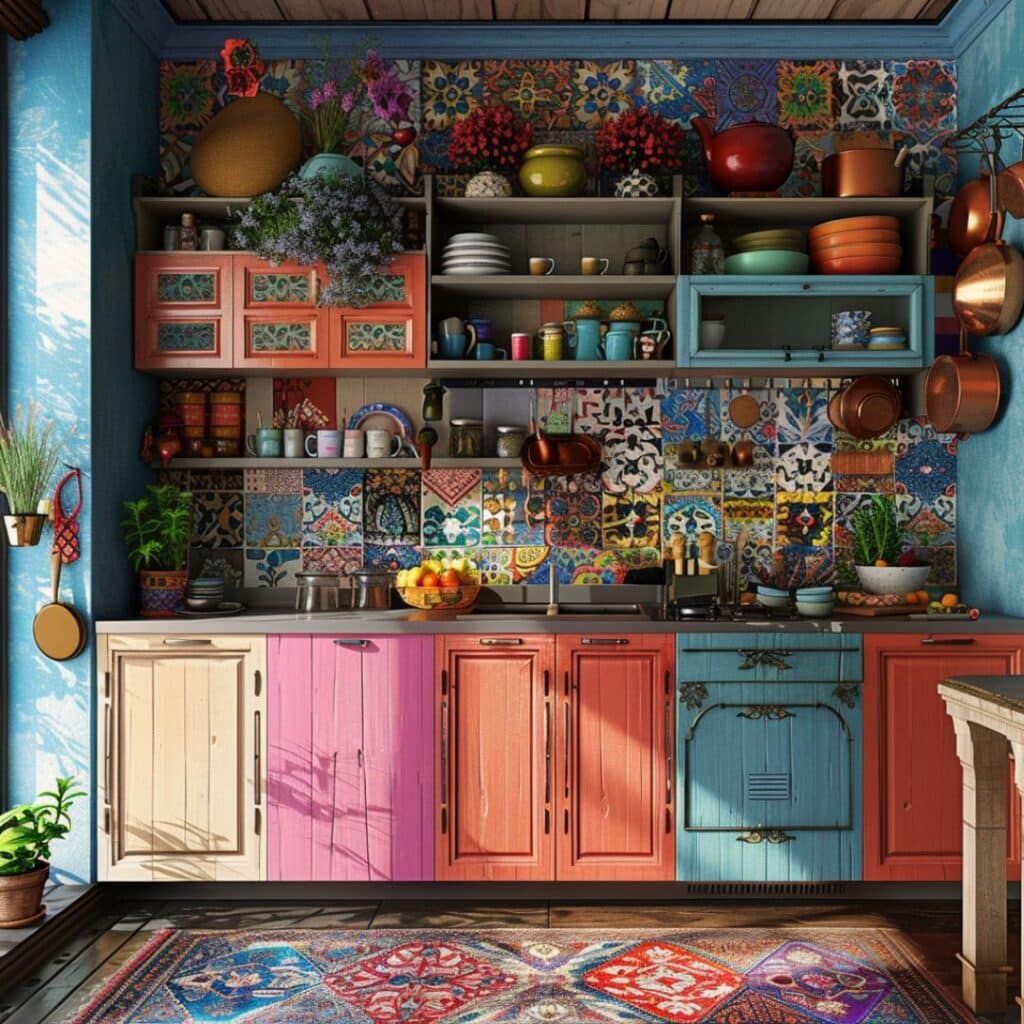
Maximalism thrives on the “more is more” philosophy. It embraces layers of bright colors, clashing patterns, and contrasting textures. This style showcases your personality through an eclectic collection of artwork and unique finds.
Start with Bright Prints
Choose vivid prints for walls, rugs, and upholstery. Mix florals with geometrics to create visual interest. Aim for bold contrasts to make each element pop.
Layer Textures
Combine various materials like velvet, silk, and leather. Add multiple throw pillows in different fabrics on a single couch. Use textured wallpaper or area rugs to add depth.
Curate Eclectic Collections
Display your favorite artworks prominently. Mix vintage pieces with contemporary sculptures. Don’t shy away from placing quirky items next to classic decor.
Use Contrasting Colors
Opt for vibrant hues that clash yet complement each other. Pair deep blues with bright yellows or rich reds with emerald greens. The goal is to create a lively atmosphere.
Focus on Statement Pieces
Place eye-catching furniture at the center of your rooms. Think oversized sofas or intricately designed coffee tables. These pieces become focal points in your maximalist space.
Edit Impulsively
Step back occasionally to evaluate the overall look. Snap photos to gain impartial perspectives on your design choices. Adjust as needed but trust your instincts.
Test in Small Spaces
Start in areas like guest rooms or hall baths if you’re uncertain about going full maximalist immediately. Smaller spaces allow you to experiment without being overwhelming.
#41. Japandi

Japandi combines Japanese and Scandinavian minimalist interior design styles to create serene, balanced spaces. Dominated by calming neutral tones like beiges, grays, taupes, and creams, it offers a peaceful environment.
Natural elements are key in Japandi. Woods and clays feature prominently in accent pieces such as vases, mugs, or pots. Black accents sometimes add contrast to the otherwise soft palette.
Furniture favors clean lines and simplicity. This makes it perfect for those with busy lives seeking tranquility at home. The minimalistic approach ensures every piece is functional yet stylish.
Earthy colors dominate the palette. Think browns, greens, and soft floral patterns that add subtle interest without overwhelming the senses.
Scandinavian influences come from Sweden, Denmark, and Norway. These designs emphasize functionality and minimalism with organic shapes and textural plays that bring warmth into any room.
Japanese elements contribute Zen-like calmness through natural materials like bamboo and stone. These materials form a soothing color base of brown-gray-green combinations enhancing relaxation.
Two subtrends have influenced Japandi: hygge from Denmark focuses on warmth and comfort while Swedish lagom promotes minimalist choices that conserve resources—both perfectly blend into the Japandi aesthetic for a practical yet inviting home atmosphere.
#42. Minimal Boho
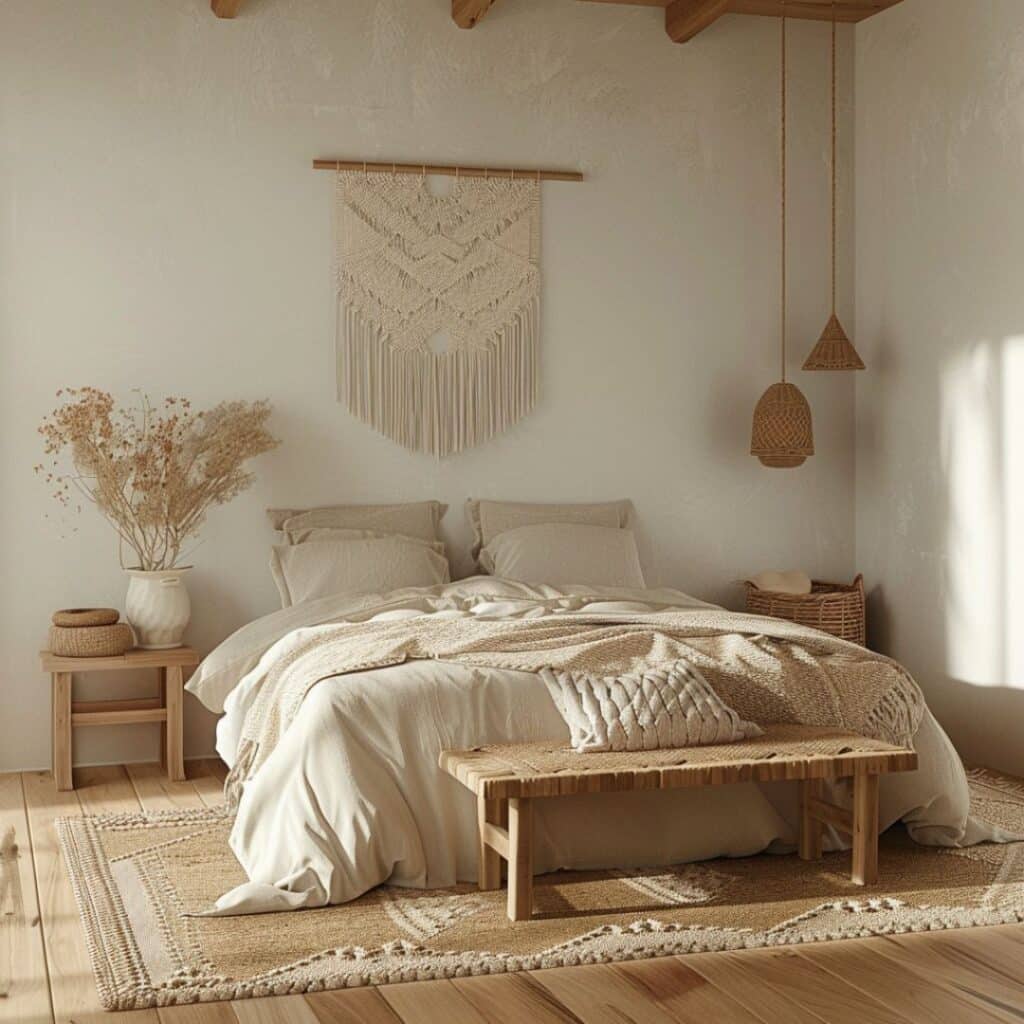
Minimal Boho merges minimalist and bohemian elements, creating a balanced yet eclectic space. This hybrid style prioritizes clean lines and simplicity while incorporating global accents.
Neutral Color Palette
Minimal Boho interiors often use neutral colors like white, beige, and gray. These shades create a serene backdrop for vibrant bohemian touches.
Mix of Furniture Styles
Expect to see modern, midcentury modern, and vintage furniture in Minimal Boho spaces. Combining these styles gives your room an eclectic feel without overwhelming the senses.
Natural Textures
Natural materials play a crucial role in this design style. Wood, woven fibers, and plants add warmth and texture to any Minimal Boho space.
Functional Decor
While the aesthetic is vital, functionality isn’t sacrificed. Choose pieces that are both beautiful and practical to maintain the minimalist aspect of Minimal Boho design.
#43. Coastal Modern

Coastal modern design is all about creating a light, airy space that brings the beach to your home. Start with a crisp white base and layer in sea and sky-inspired blues. Add earthy browns and greens for a natural touch.
Light is crucial. Large windows are perfect for letting in lots of natural sunlight. Use sheer curtains or none at all to keep spaces bright.
Choose materials like wood, jute, linen, cotton, and glass. These elements keep the vibe organic and relaxed. Think wicker chairs or bamboo accents.
Furniture should be simple but comfortable. Light-toned upholstery works well against darker wood tones or black metal finishes.
Incorporate coastal-themed decor sparingly: nautical stripes, seashells, or coral pieces add charm without overwhelming the space.
Finally, mix different styles like bohemian, industrial, mid-century modern, and Scandinavian elements to make it feel eclectic yet cohesive.
#44. Organic Modern
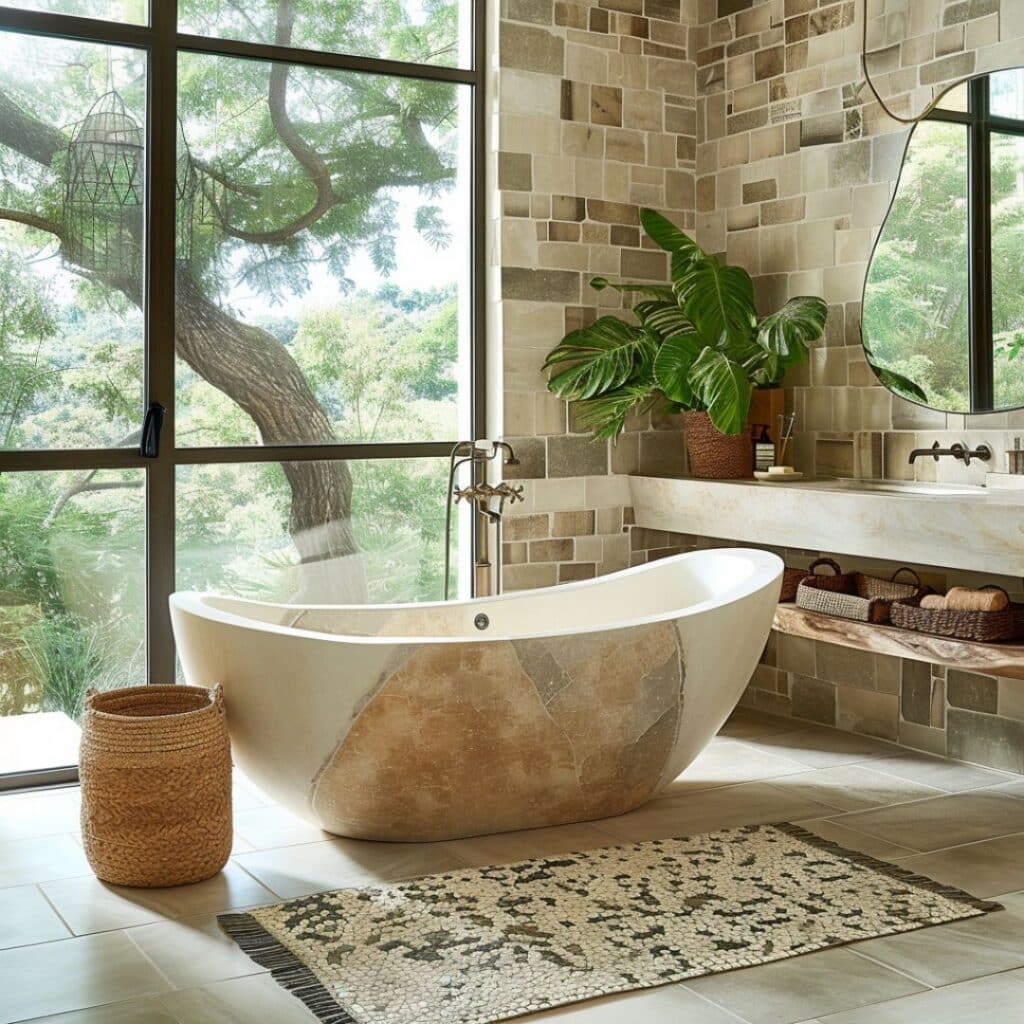
Organic modern design uses natural materials to infuse modern spaces with warmth and textures. It blends elements like wood, stone, and plants to create a harmonious environment. Think of it as bringing the outdoors inside.
Focus on sustainability when selecting materials. Look for reclaimed wood, bamboo, or recycled glass. These choices not only add character but also promote eco-friendliness.
Incorporate neutral color palettes that mimic nature. Shades like beige, olive green, and soft browns work well. They provide a calming backdrop for your space.
Mix modern furniture with organic elements for balance. A sleek sofa paired with a live-edge wooden coffee table can make an eye-catching statement.
Use plenty of natural light to highlight the textures in your room. Large windows or skylights can accomplish this beautifully.
Add greenery to breathe life into your space. Plants like ferns or succulents are easy to care for and enhance the organic feel.
Choose simple yet elegant decor items made from natural fibers or hand-crafted pieces. Items like woven baskets or ceramic vases fit perfectly within this style.
Keep clutter minimal to maintain a clean look while still feeling cozy and inviting. This approach will help your space feel open and airy while retaining its warmth.
By blending these elements thoughtfully, you can achieve an inviting organic modern interior that feels both contemporary and grounded in nature.
#45. Eclectic Boho

Embrace a free-spirited vibe with Eclectic Boho. This style is perfect if you love mixing and matching different elements.
Mix Old and New
Combine modern furniture with vintage finds from flea markets. It’s okay to have six different chairs around one table.
Play with Textures
Use untreated natural materials like wood and rattan. Add inviting fabrics such as cotton, mohair, and linen in neutral tones like beige, brown, and olive.
Add Bold Accents
Incorporate bright yellows or blues through pillows or art pieces. Bold patterns, wild fringes, and dazzling embroidery are welcome additions.
Showcase Global Influences
Display items from various cultures to enhance the eclectic feel. Incorporate batik prints, macramé wall hangings, or hanging baskets for an artisan touch.
Go Green
Include lots of plants to echo nature indoors. Mixing greenery with your decor adds warmth and life to the space.
Eclectic Boho allows you to be as conventional or unconventional as you desire while creating a warm and inviting home environment.
#46. Industrial Modern
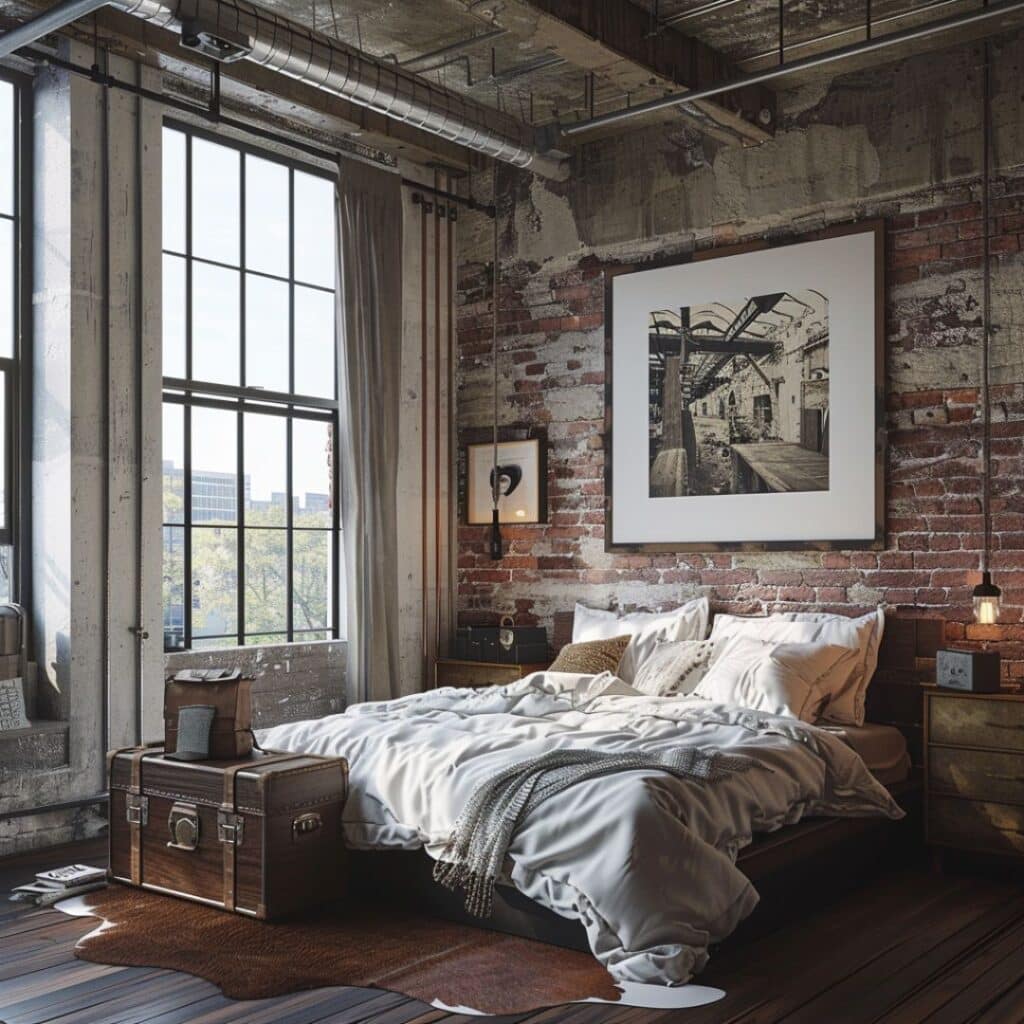
Industrial Modern blends sleek modernity with raw, unfinished elements. Think exposed brick walls, metal beams, and concrete floors paired with minimalist furniture.
Start by incorporating open spaces. Industrial designs thrive on large, airy areas without many partitions. Use neutral colors like grays and blacks to create a cohesive look.
Add vintage industrial lighting fixtures. Pendant lights with Edison bulbs or metal shades can give your space that desired factory feel.
Utilize reclaimed materials for an authentic touch. Furniture made from old wood or repurposed metal adds character and sustainability to your design.
Include functional decor elements. Items like steel-framed mirrors or wooden shelves are not only practical but also enhance the industrial aesthetic.
Opt for simple yet bold furniture pieces. A leather sofa or a sturdy metal coffee table can serve as focal points in an otherwise minimal setup.
Remember to keep the space clutter-free. The beauty of Industrial Modern lies in its simplicity and functionality, making every piece count.
#47. Desert Modern
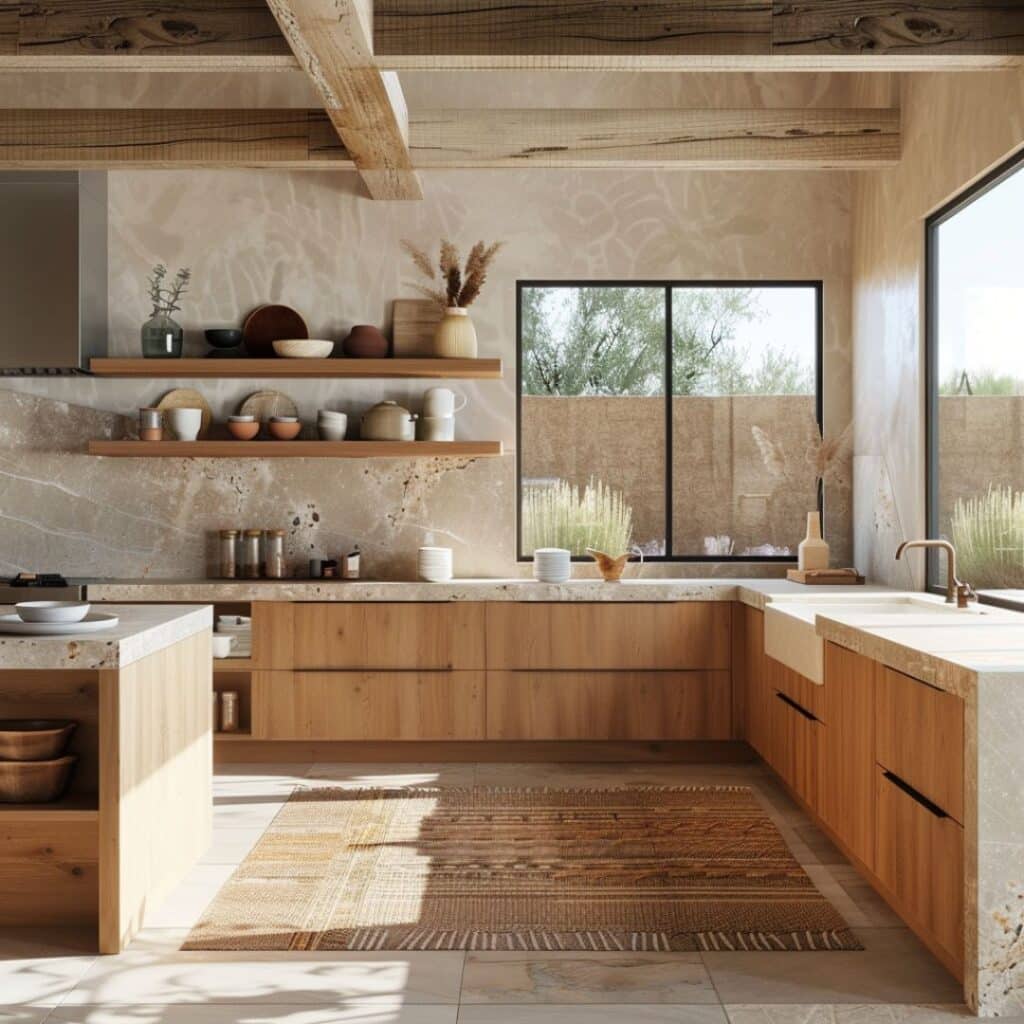
Desert Modern borrows from boho and eclectic styles but with a focus on earthen textures. Think plaster, clay, and stone combined with geometric and organic shapes. This style evokes a vibe reminiscent of the desert.
Integrate natural materials to bring warmth into your space. Use elements like terracotta pots, woven baskets, and raw wood furniture. These items add texture and authenticity.
Choose a neutral color palette inspired by desert landscapes. Opt for sandy beiges, warm browns, and soft whites to create a calm environment. Adding pops of muted terracotta or sage green keeps things interesting without overwhelming the senses.
Incorporate minimalist yet comfortable furnishings. Look for low-profile sofas with clean lines paired with rustic wooden coffee tables. Simple doesn’t mean boring; it means each piece stands out.
Use textiles that reflect the desert’s essence. Select linen curtains, wool rugs, or leather cushions to layer in different textures while maintaining harmony within your design scheme.
Add plants that thrive in dry conditions for an authentic touch. Cacti and succulents are perfect choices—they’re low maintenance yet visually striking.
Don’t forget about lighting! Choose fixtures made from natural materials like rattan or bamboo to enhance the earthy feel of your space. Soft lighting helps maintain that serene ambiance so central to Desert Modern design.
Lastly, incorporate art pieces reflecting desert themes or landscapes. Whether it’s pottery-inspired wall hangings or abstract paintings in earthy tones—these additions provide character while keeping true to the overall aesthetic.
#48. Dark Academia
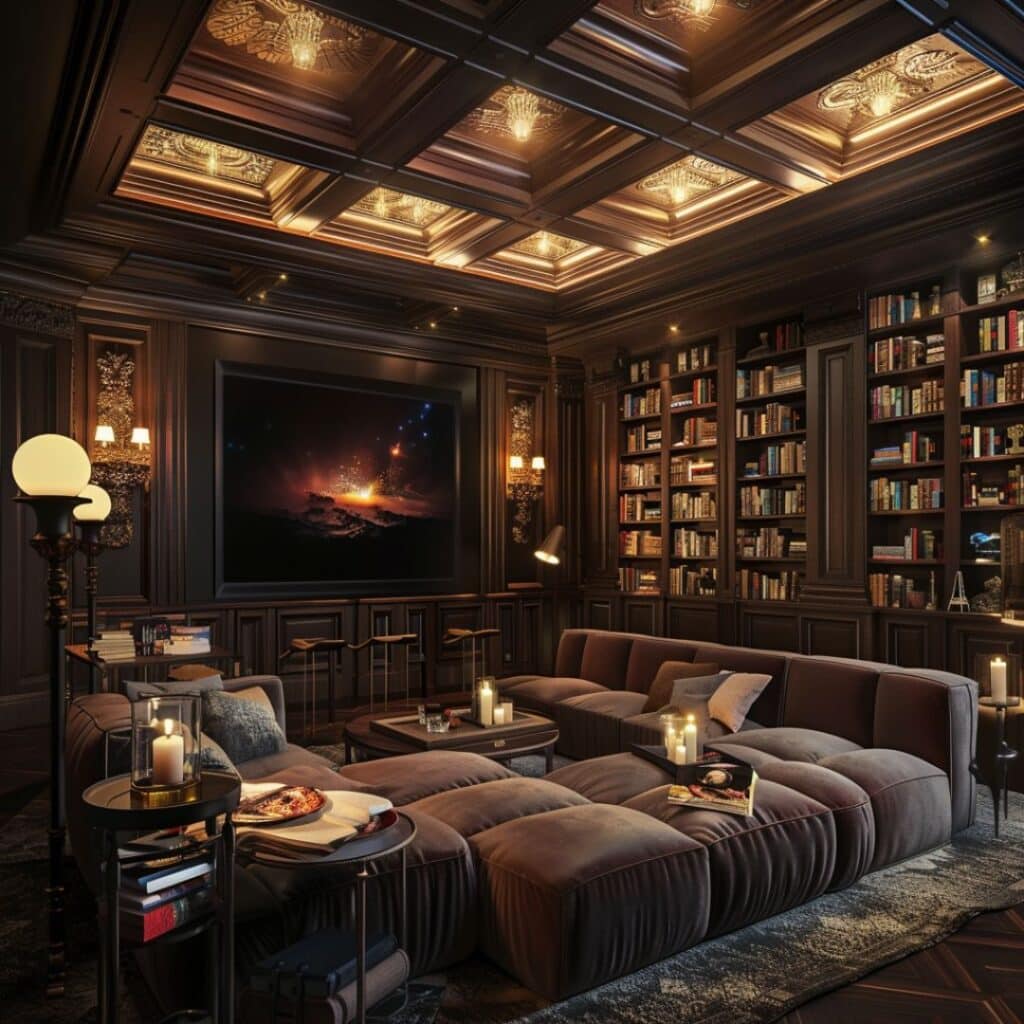
Dark Academia melds scholarly aesthetics with a gothic touch. Think vintage books, dark wood furniture, and antique decor. It’s all about creating a space that feels like an old university library.
Use moody colors like deep greens, browns, and blacks. These shades set the tone for the design style. Incorporate rich fabrics such as velvet or leather for upholstery.
Display classical art pieces and sculptures to enhance the intellectual vibe. Place these on shelves or mantels to evoke an academic atmosphere.
Lighting should be soft and ambient. Try using table lamps with warm-toned bulbs or candles in brass holders.
Add details like quill pens, old maps, and globes. Items like these add authenticity to your Dark Academia aesthetic.
Books are essential in this style. Stack them on tables or arrange them neatly on bookshelves for a scholarly look.
Incorporate vintage rugs with intricate patterns to cover hardwood floors. This adds warmth and depth to your space.
Don’t forget wall paneling if possible; it can amplify the classic feel of Dark Academia interiors.
#49. Light Academia
Light Academia is all about embracing a scholarly yet bright and airy aesthetic. It blends classical elements with a softer, more welcoming feel. Think vintage books and light wood furniture paired with pastel hues and natural light.
Start by choosing a color palette that includes whites, creams, soft grays, and light pastels. These colors create an inviting atmosphere while maintaining the intellectual vibe of the style.
Incorporate plenty of natural materials like wood, linen, and cotton. Choose furniture pieces that have a vintage or antique look but in lighter finishes to keep the space feeling open and fresh.
Add decorative items such as framed botanical prints, classic sculptures, and delicate ceramics. These small touches add character without overwhelming the space.
Lighting plays a crucial role in Light Academia interiors. Use soft ambient lighting through table lamps with fabric shades or pendant lights with intricate designs to enhance the serene environment.
Don’t forget to include comfortable reading nooks filled with plush cushions and throws. A well-placed armchair next to a bookshelf invites moments of quiet study or relaxation.
Finally, accessorize with elements like globes, old maps, and quill pens for that academic touch. These details tie everything together while adding depth to your interior design style.
#50. Neo-Gothic

Neo-Gothic design fuses medieval inspiration with contemporary elements. Start by integrating pointed arches and intricate wood carvings in your space. Opt for dark, moody colors like deep reds and purples to create a dramatic effect.
Use antique furniture pieces to anchor the room’s character. Include ornate chandeliers and stained glass windows to amplify the gothic vibe. Consider adding stone or brick elements for an authentic touch.
Incorporate rich fabrics like velvet or brocade for upholstery and drapery. Decorative accents such as gargoyles, candle holders, and vintage mirrors enhance the ambiance further. Maintain balance by pairing these heavy details with modern minimalist items to avoid overwhelming the space.
Choose artwork depicting historical scenes or mythical creatures to add layers of interest. Focus on creating a cozy yet grand atmosphere that welcomes while impressing guests.
#51. Baroque
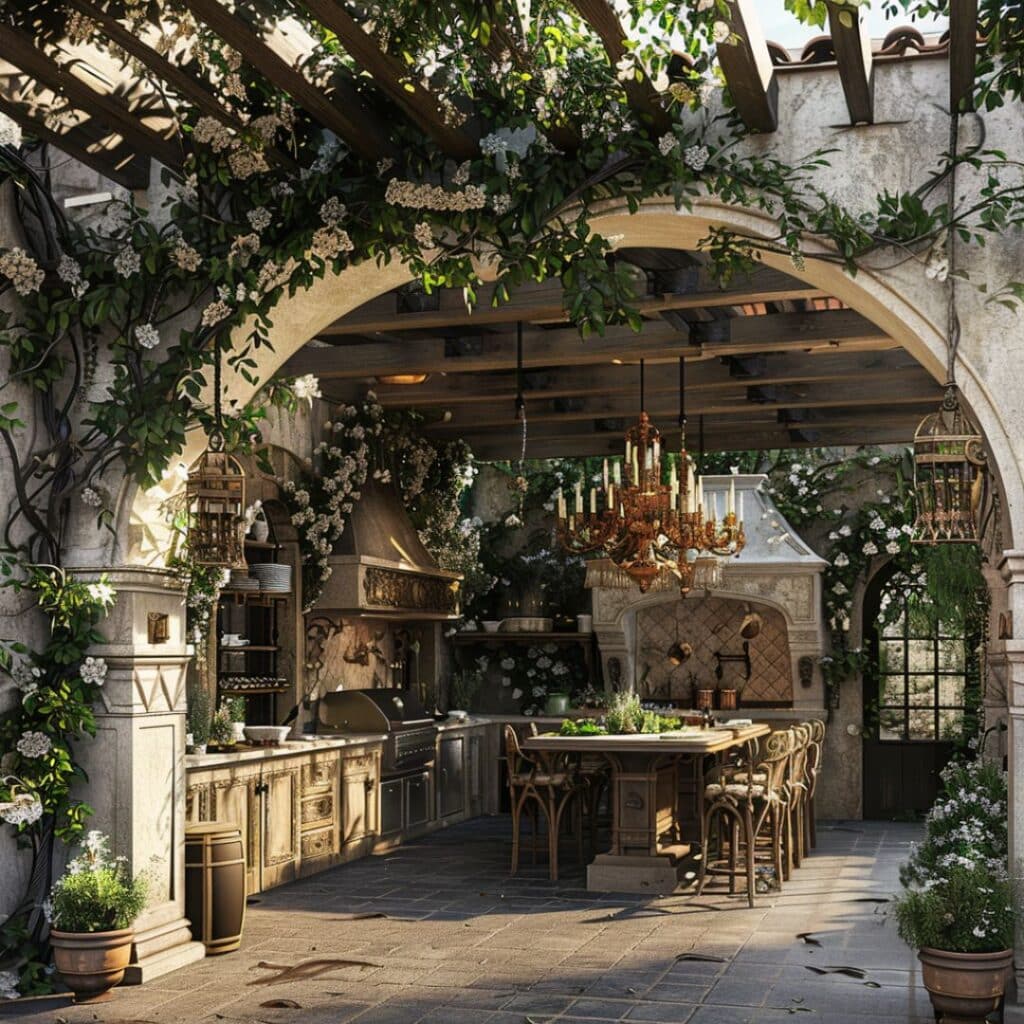
Baroque interior design is all about opulence and grandeur. Originating in 17th-century Europe, it features lavish decorations, bold colors, and intricate details. Think of rich golds, deep reds, and ornate patterns.
Incorporate heavy drapery with luxurious fabrics like velvet or silk. These add a sense of drama and elegance to any room. Use carved wood furniture with elaborate designs for that authentic Baroque feel.
Mirrors framed in gold leaf are perfect for enhancing the space’s richness. Chandeliers with crystal accents elevate the overall ambiance too. Artwork should be grandiose; large oil paintings depicting historical scenes fit well.
Marble floors or tabletops can add an extra layer of sophistication. If possible, include architectural elements such as columns or pilasters—these scream Baroque style effortlessly.
Accessories should be equally extravagant. Opt for gilded sculptures or decorative vases filled with fresh flowers to complete the look.
This style isn’t just about extravagance but creating a cohesive yet visually striking environment that feels both historic and luxurious at once.
#52. Rococo
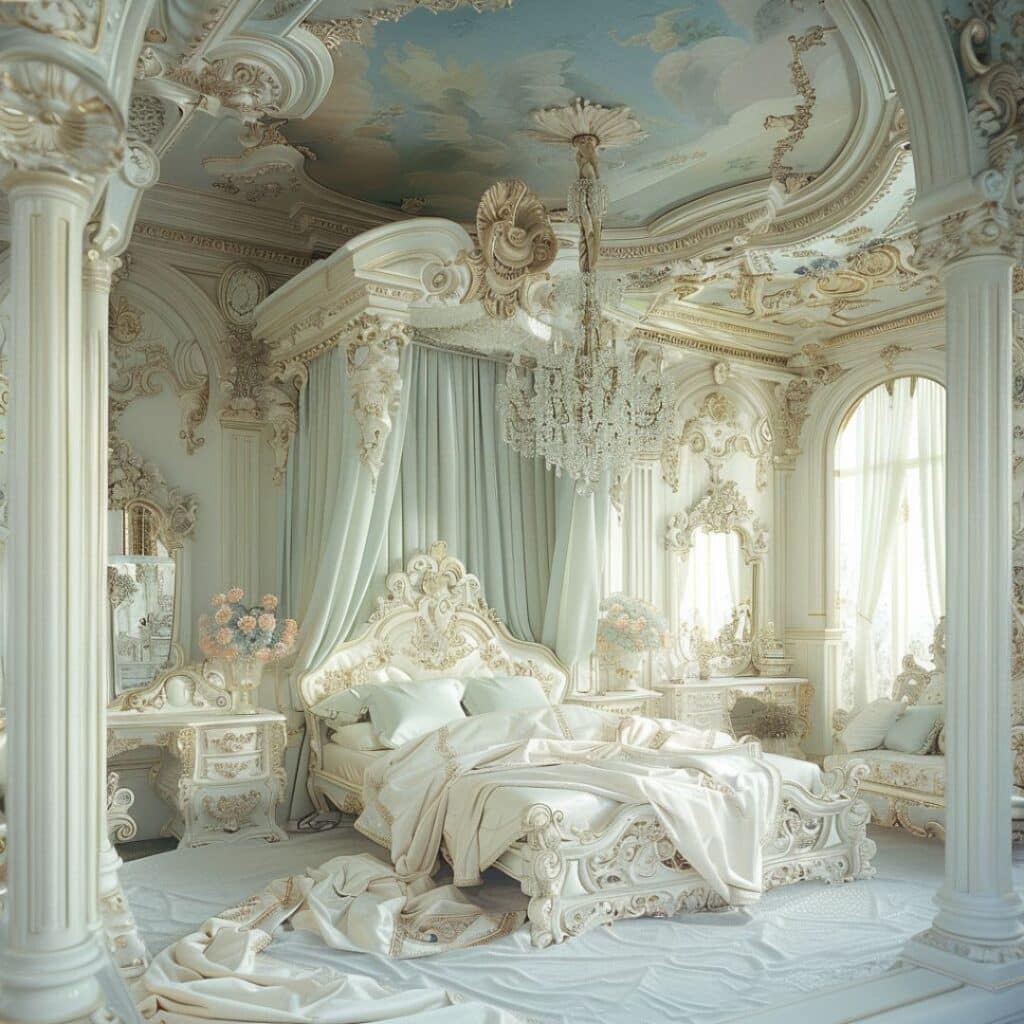
Rococo interior design is typified by the decorative styles of the Louis XIV, XV, and XVI eras. Originating in the late 17th century and extending into the early 19th century, this style is revered for its finely crafted furniture. You’ll notice intricate carvings and opulent gilding.
Asymmetry plays a significant role in Rococo design. Look for bombe silhouettes and Neoclassical elements like Roman gods, lyres, urns, and winged lions. These features capture the quintessential French aesthetic.
Decorative show wood frames are prominent in Rococo interiors. Furniture often has cabriole or fluted legs which have remained a staple of elegant design through the centuries. Incorporate these details to create an authentically grand space.
To truly embrace Rococo style, focus on achieving a balance between luxury and whimsy. Think of opulent fabrics paired with playful motifs to evoke this historical charm effectively in your home decor.
#53. Regency
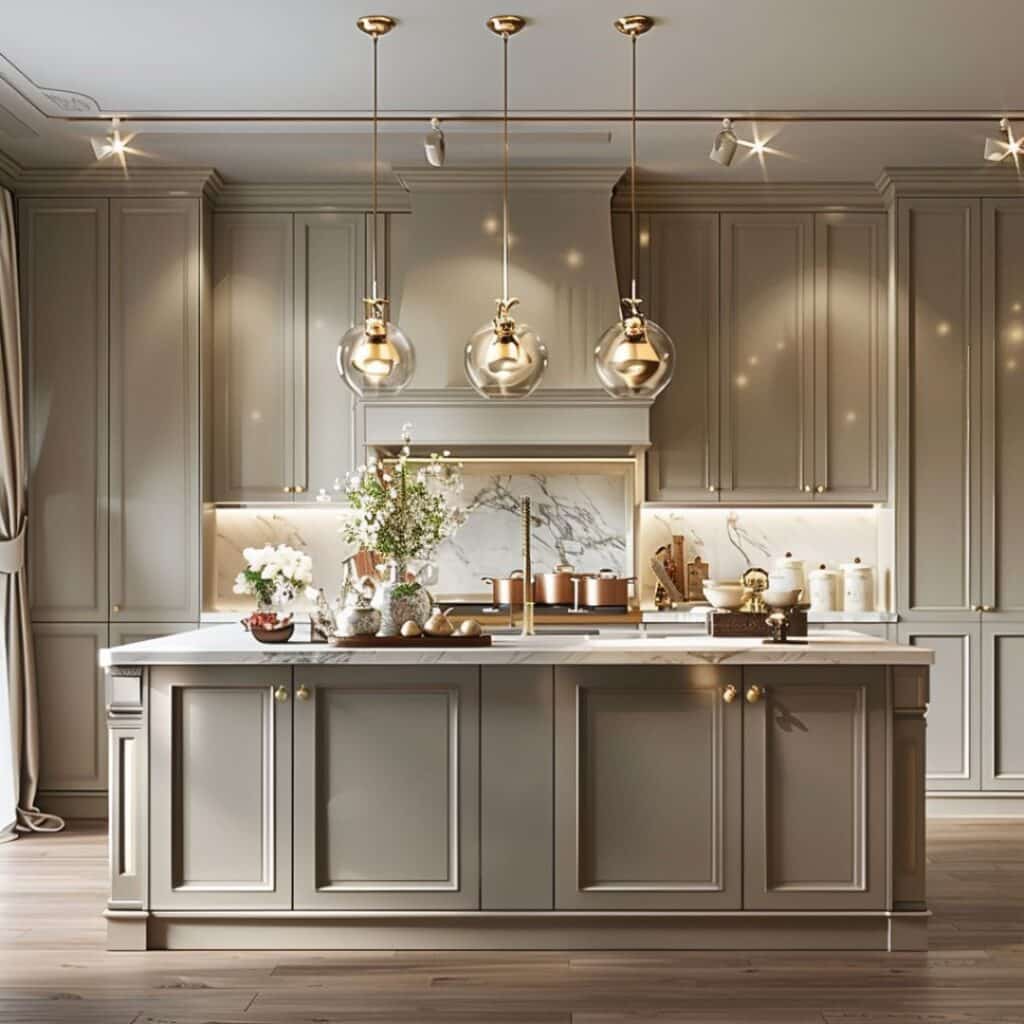
Regency style speaks to opulence and grandeur with touches of the exotic. Animal masks used as decor add a flamboyant feel. Key pieces include heavy drapes, high-backed chairs, chandeliers, and gilded mirrors.
Materials favored by this style include dark heavy woods such as mahogany or rosewood. Brass inlays add an extra touch of luxury. Chair legs often feature column, concave, or X-shaped designs.
Lighting plays a significant role in achieving the right ambiance. Chandeliers are essential elements for adding elegance. Sconces and lamps with intricate designs also fit well within this aesthetic.
Color palettes focus on deep hues like rich reds and greens. These colors convey warmth and sophistication. Gold accents further enhance the overall luxurious vibe.
Textiles are another crucial aspect of Regency interiors. Velvet, brocade, and silk materials dominate furnishings and window treatments alike for added texture and depth.
Incorporate ornamental details wherever possible for authenticity’s sake. Think plasterwork ceilings or intricate wall moldings to complete the look seamlessly.
For finishing touches, consider using period-appropriate accessories like porcelain vases or classic artwork frames to accentuate your space accurately without overwhelming it.
#54. Empire

Empire interior design takes inspiration from the grandeur of Napoleonic France. This style is known for its majestic feel, incorporating elements like columns, arches, and rich wooden tones.
- Columns and Arches Consider adding columns and arches to your space. These architectural features create a sense of elegance reminiscent of ancient Roman structures.
- Furniture Choices Opt for furniture with strong lines and classical motifs. Look for pieces that include lion heads or other regal symbols.
- Color Palette Use deep reds, greens, and golds to evoke luxury. These colors help in crafting an opulent atmosphere.
- Materials Choose materials like marble and dark woods such as mahogany. These materials add weight and sophistication to the room.
- Decorative Elements Integrate gilded mirrors, crystal chandeliers, and heavy drapes into your decor. These items enhance the luxurious feel typical of Empire interiors.
- Textiles Incorporate fabrics like velvet and silk in your cushions or curtains. Rich textiles contribute to a sumptuous environment.
- Lighting Utilize ornate lighting fixtures such as sconces and chandeliers made from metals like bronze or gold-plated finishes.
- Artwork Display large-scale paintings depicting historical scenes or portraits framed in ornate gold frames for an authentic touch.
By following these guidelines, you can bring the grandiosity of Empire style into your home seamlessly.
#55. Biedermeier
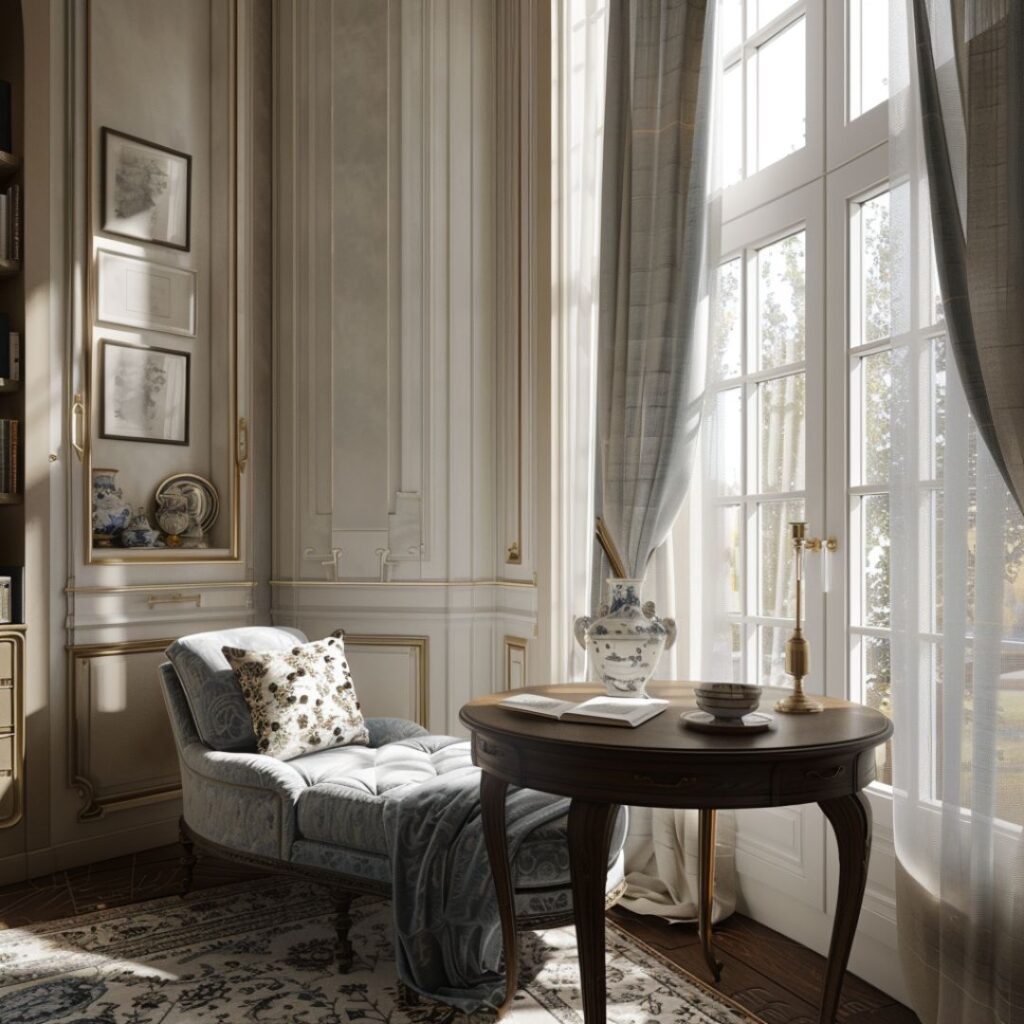
Biedermeier interior design originated in early 19th-century Germany. This style focuses on simplicity and practicality, making it perfect for everyday living.
Incorporate clean lines and minimal ornamentation into your decor. Furniture from this period is often functional yet elegant, with an emphasis on comfort.
Use light wood tones like birch and cherry to create a warm atmosphere. Upholstery tends to feature simple patterns or solid colors, avoiding overly intricate designs.
Integrate artwork that reflects scenes of daily life or nature. These pieces add charm without overwhelming the space.
Include decorative elements such as porcelain figurines and glassware sparingly. These items should enhance rather than dominate your room’s aesthetic.
Opt for natural light by using sheer curtains or strategically placed mirrors. This approach brightens up the space while maintaining its understated elegance.
By following these steps, you can effortlessly incorporate Biedermeier style into your home, achieving a balance of functionality and beauty.
#56. Romanticism
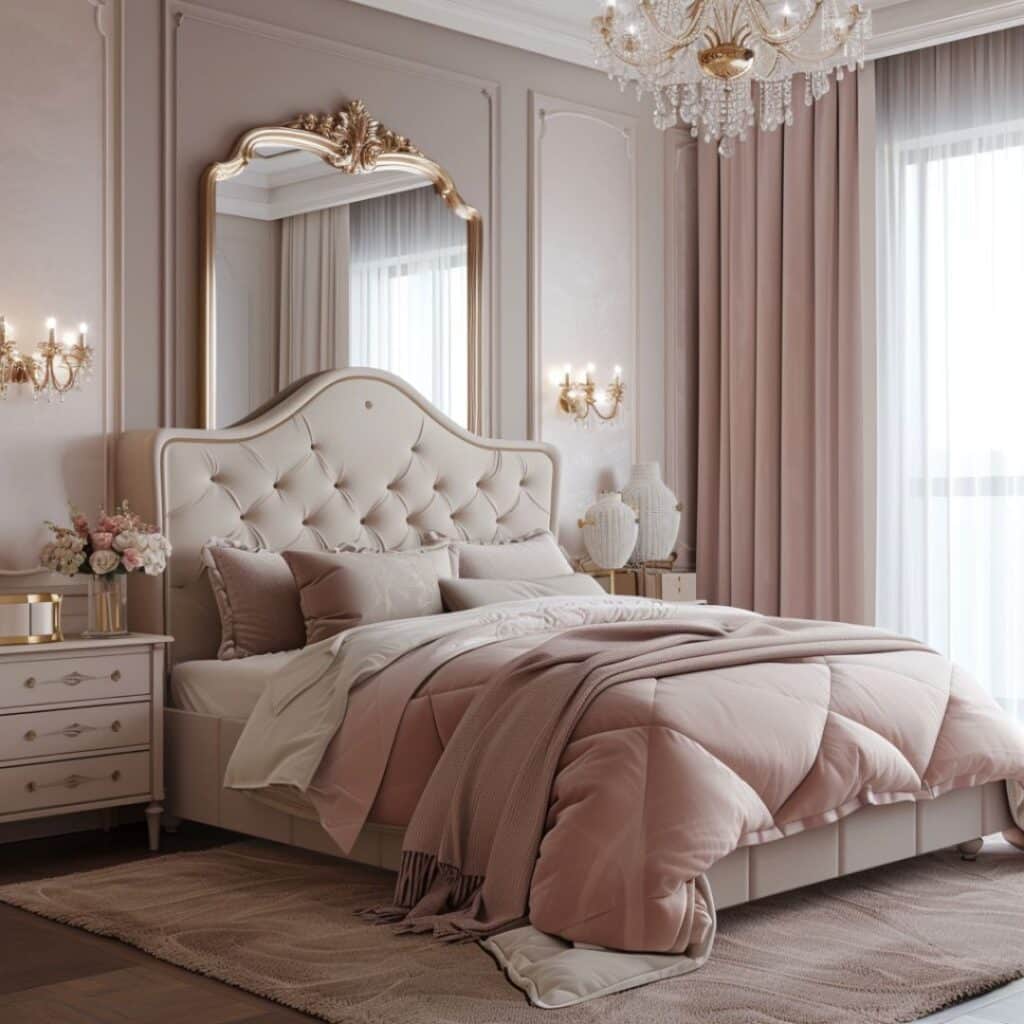
Romanticism interior design draws inspiration from the 19th-century artistic movement. Focus on creating an atmosphere full of emotion and drama. Utilize rich, deep colors like burgundy, emerald green, and navy blue.
Incorporate ornate furniture pieces with intricate carvings. Think antique wooden dressers and upholstered chairs with curved legs. Use luxurious fabrics such as velvet for curtains, pillows, and upholstery.
Add vintage-inspired accessories to enhance the romantic feel. Include items like candle holders, chandeliers, and decorative mirrors with gold frames. Display artwork that evokes strong emotions or depicts nature scenes.
Soft lighting creates a cozy ambiance in Romanticism interiors. Use table lamps with fabric shades or wall sconces to cast a warm glow across your space. Avoid harsh overhead lighting to maintain intimacy.
Integrate floral patterns into your decor through wallpaper or textiles. Choose designs featuring roses, peonies, or delicate vines to echo nature’s beauty inside your home.
Finally, layer textures for depth and interest. Combine materials like lace, silk, and wool in rugs, throws, and cushions to create a sumptuous environment that’s inviting yet elegant.
#57. Neoclassical
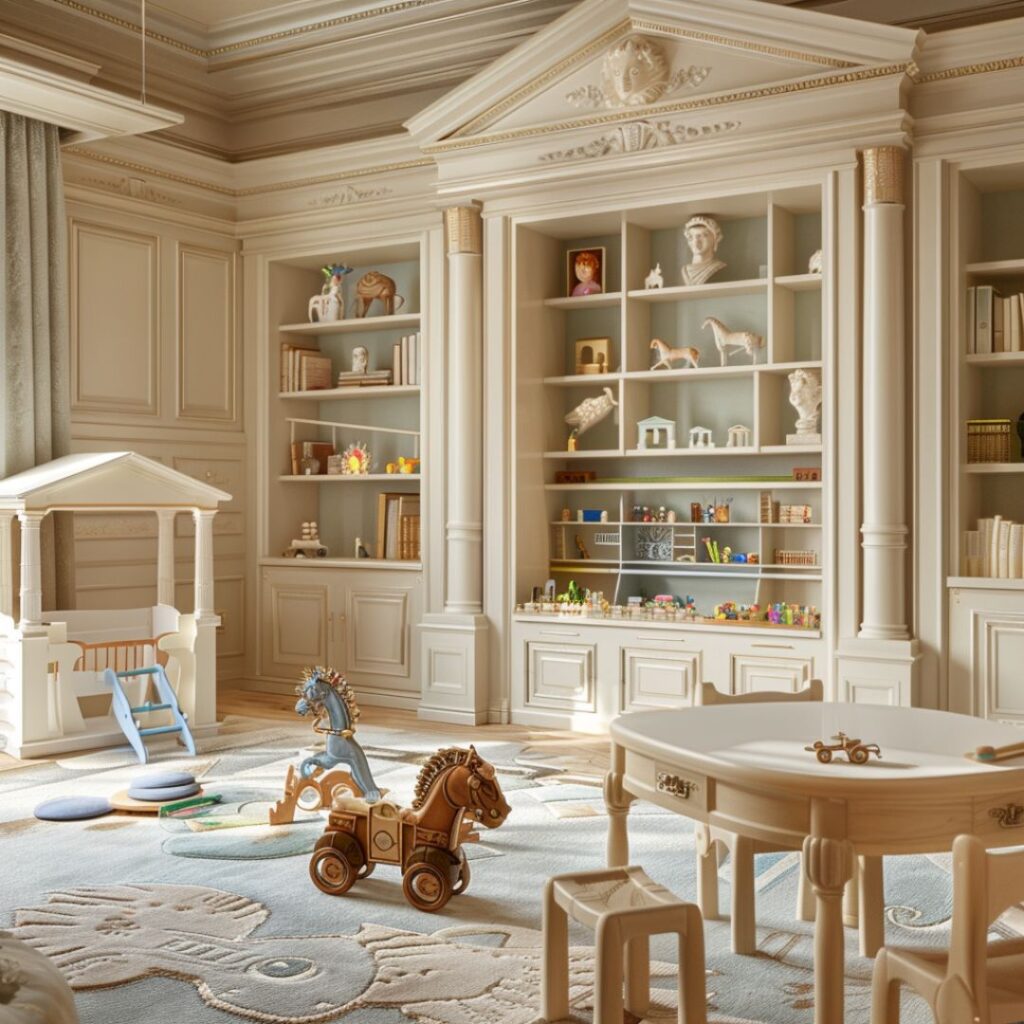
Neoclassical interior design draws heavily from the decorative styles of the late 17th to early 19th centuries. It’s known for its finely crafted furniture, intricate carvings, and opulent gilding.
Look for elements like Roman gods, lyres, urns, and winged lions. These neoclassical motifs add a touch of ancient grandeur to your space.
Select decorative show wood frames featuring prominently in your furniture. Pieces often have cabriole or fluted legs, adding an elegant touch that remains timeless.
Choose materials such as marble and mahogany. These rich tones are typical of neoclassical interiors and exude sophistication.
Incorporate luxurious fabrics like velvet and silk into your upholstery choices. They enhance the overall lavish feel of the design style.
Add large-scale artwork in ornate frames to make bold statements on your walls. This art should reflect classical themes to stay true to the style’s roots.
Use black-and-white checkered flooring if possible. It perfectly complements neoclassical decor with its striking yet classic look.
Opt for chandeliers paired with high-gloss or mirrored cabinetry. These details contribute layers of elegance and glamour unique to this design philosophy.
Integrate patterns such as Greek key or geometric designs in fabrics and wallpapers. Bold yet timeless patterns fit well within this aesthetic framework.
#58. Safari
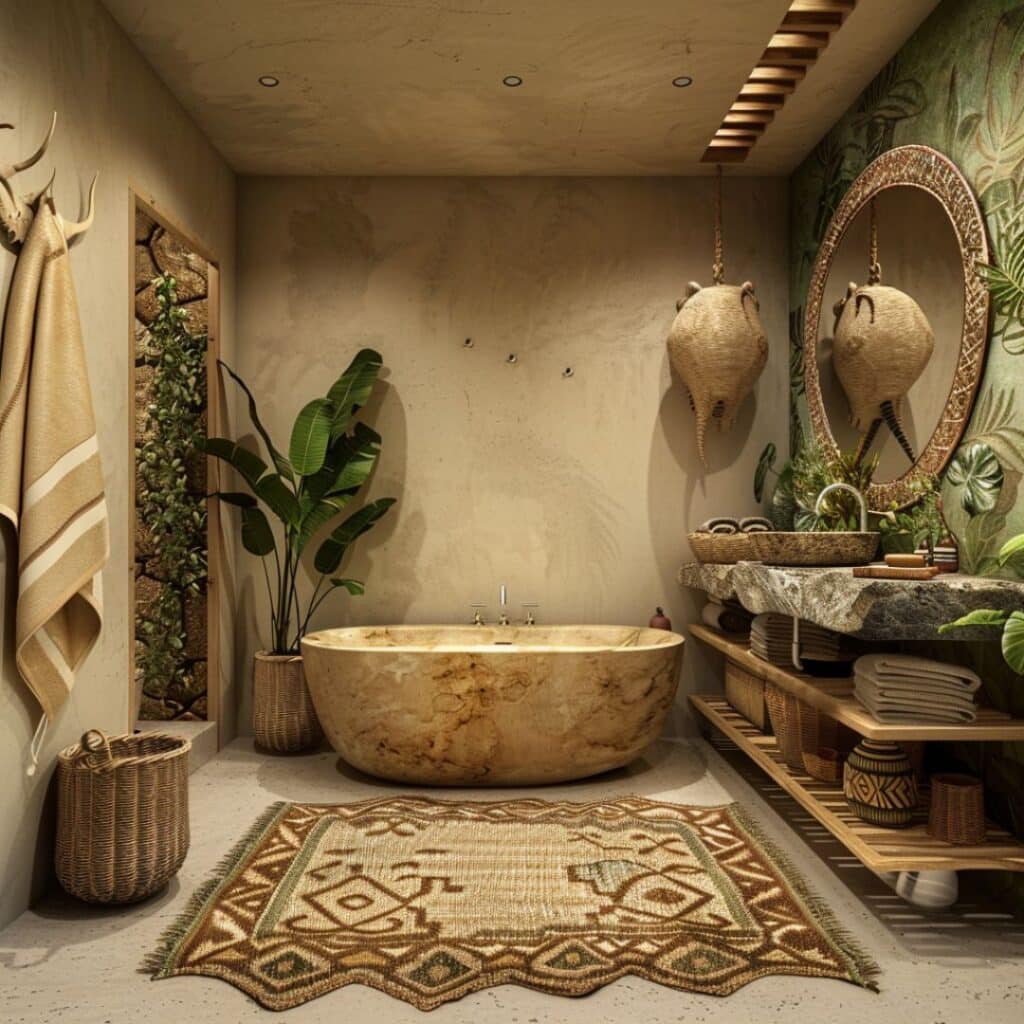
Safari interior design transports you to the heart of Africa. Incorporate natural materials like wood, stone, and leather. Use earthy tones such as browns, beiges, and greens to create a warm atmosphere.
Animal prints are essential in this style. Choose patterns like zebra stripes or leopard spots for cushions and rugs. Decorative elements may well include tribal masks, woven baskets, and handcrafted pottery.
Furniture should be robust yet comfortable. Opt for pieces made from dark woods with simple lines. Add texture with woven chairs or rattan accents.
Lighting plays a crucial role in setting the mood. Use lantern-style fixtures or lamps with organic finishes. Soft lighting helps evoke the serene feeling of a safari lodge.
Accessorize with items that reflect African culture. Think about incorporating artifacts or sculptures from local artisans. These elements add authenticity to your space.
Consider large plants like palms or ferns for greenery. They bring life into the room and tie together the natural theme seamlessly.
This design style blends adventure with comfort by combining rugged elements and cozy touches throughout your home decor.
#59. Urban Chic

Urban Chic marries modern elegance with industrial charm. Think sleek furniture, exposed brick walls, and steel fixtures. This style thrives on simplicity and sophistication.
Choose clean lines to define your space. Opt for minimalist sofas, glass coffee tables, and metal shelving units. Keep the color palette neutral—whites, grays, and blacks work best.
Incorporate industrial elements seamlessly. Use materials like concrete for countertops or reclaimed wood for flooring. Exposed ducts or pipes can add a raw edge.
Play with textures to add depth. Mix soft fabrics like velvet cushions with rougher surfaces such as brick or metal accents.
Add statement pieces sparingly but effectively. Large abstract artwork or a bold light fixture can tie the room together without overwhelming it.
Use natural light to its full potential. Large windows or skylights help illuminate the space while maintaining an airy feel.
Keep clutter at bay with smart storage solutions. Built-in cabinets or hidden shelves can keep your essentials organized yet out of sight.
Integrate greenery subtly to soften the overall look. Small potted plants on open shelves or a single large indoor plant in one corner will do wonders.
By blending these elements thoughtfully, you create an inviting yet sophisticated Urban Chic environment that feels effortless and stylish all at once.
#60. Tropical Modern

Tropical Modern style merges the essence of tropical environments with sleek, contemporary designs. It’s characterized by clean lines, natural materials, and a vibrant color palette inspired by lush landscapes.
Key Elements
Natural Materials
Use wood, bamboo, rattan, and wicker to create an organic feel. These materials add warmth and texture to your space.
Vibrant Colors
Incorporate greens, blues, yellows, and whites. These colors mimic the hues found in tropical settings.
Furniture Choices
Minimalist Design
Opt for simple yet functional furniture. Pieces should have clean lines and be made from natural materials like teak or bamboo.
Comfort Focused
Choose plush seating options like oversized sofas and cushioned chairs. Comfort is paramount in this style.
Decor Tips
Indoor Plants
Add large houseplants such as palms or ferns. They bring life into your interior while enhancing the tropical vibe.
Textiles & Patterns
Utilize textiles with bold patterns like palm leaves or exotic florals. Mix these with solid-colored cushions to balance the look.
Lighting Solutions
Natural Light Emphasis
Maximize windows to let in ample sunlight. Use sheer curtains to soften light without blocking it entirely.
Ambient Lighting
Incorporate pendant lights or floor lamps made from natural fibers such as jute or rattan for a cozy ambiance.
Accessory Ideas
Wall Art
Hang artwork depicting tropical scenes or abstract pieces in vibrant colors. Choose frames that match other natural elements in your decor.
By blending modern design principles with tropical influences you can create a serene yet stylish living environment that’s both inviting and visually stunning.
#61. Scandinavian Modern
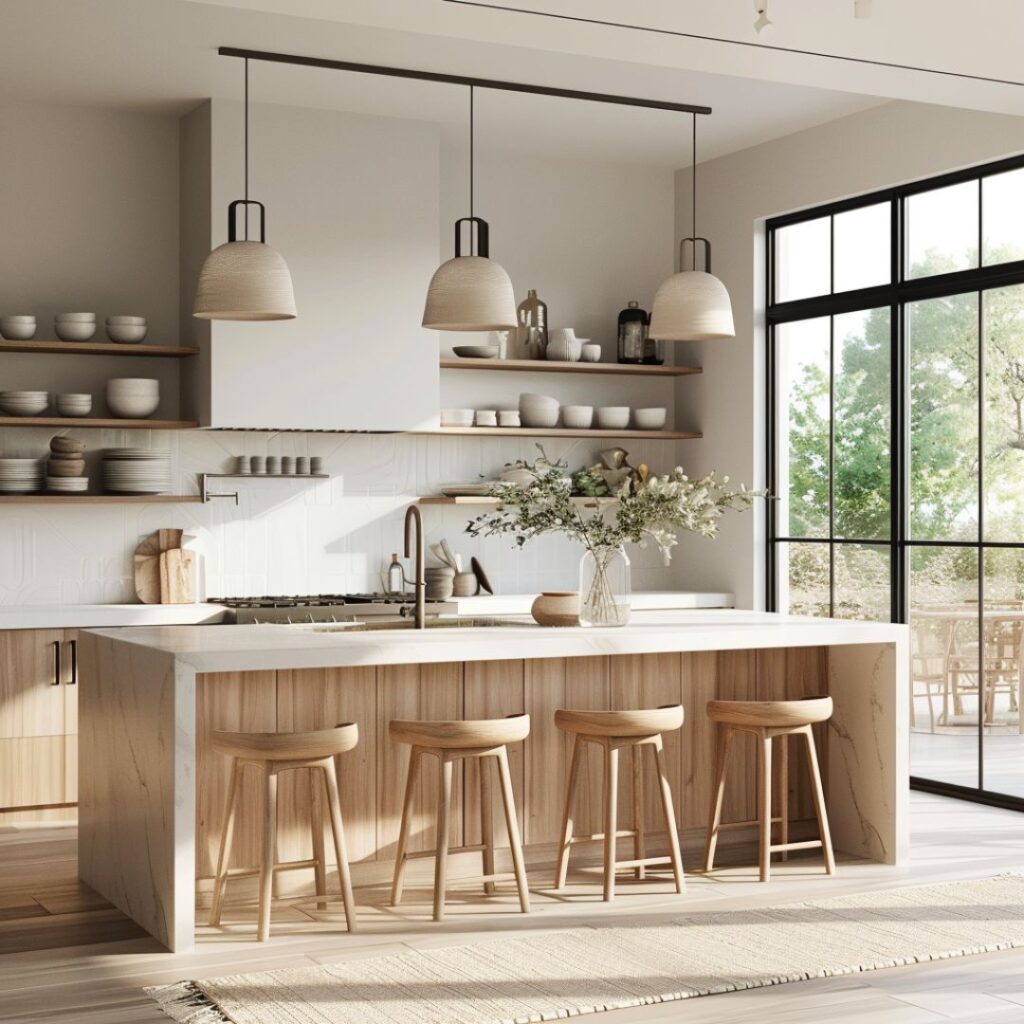
Scandinavian Modern design is all about simplicity and functionality. Originating in the Nordic countries, it emphasizes clean lines and a minimalistic approach. Furniture often features light woods like pine or beech.
Natural elements are key in this style. Expect to see plenty of natural light, soft textiles, and neutral color palettes. Think white walls with pops of muted pastels or earthy tones.
Functionality is paramount. Every piece serves a purpose without unnecessary embellishments. Storage solutions are sleek, helping maintain a clutter-free environment.
Hygge plays an important role too. Cozy touches like wool throws and plush cushions add warmth to these otherwise streamlined spaces.
Lighting is also crucial. Floor lamps with simple designs and pendant lights help keep spaces bright yet inviting.
Iconic furniture pieces abound in Scandinavian Modern interiors. Classic items include the Eames Lounger and the Egg Chair, which add both form and function to any room.
If you’re aiming for this look, embrace open layouts that foster flow between living areas. This openness enhances the airy feel that’s central to Scandinavian design principles.
#62. Japanese
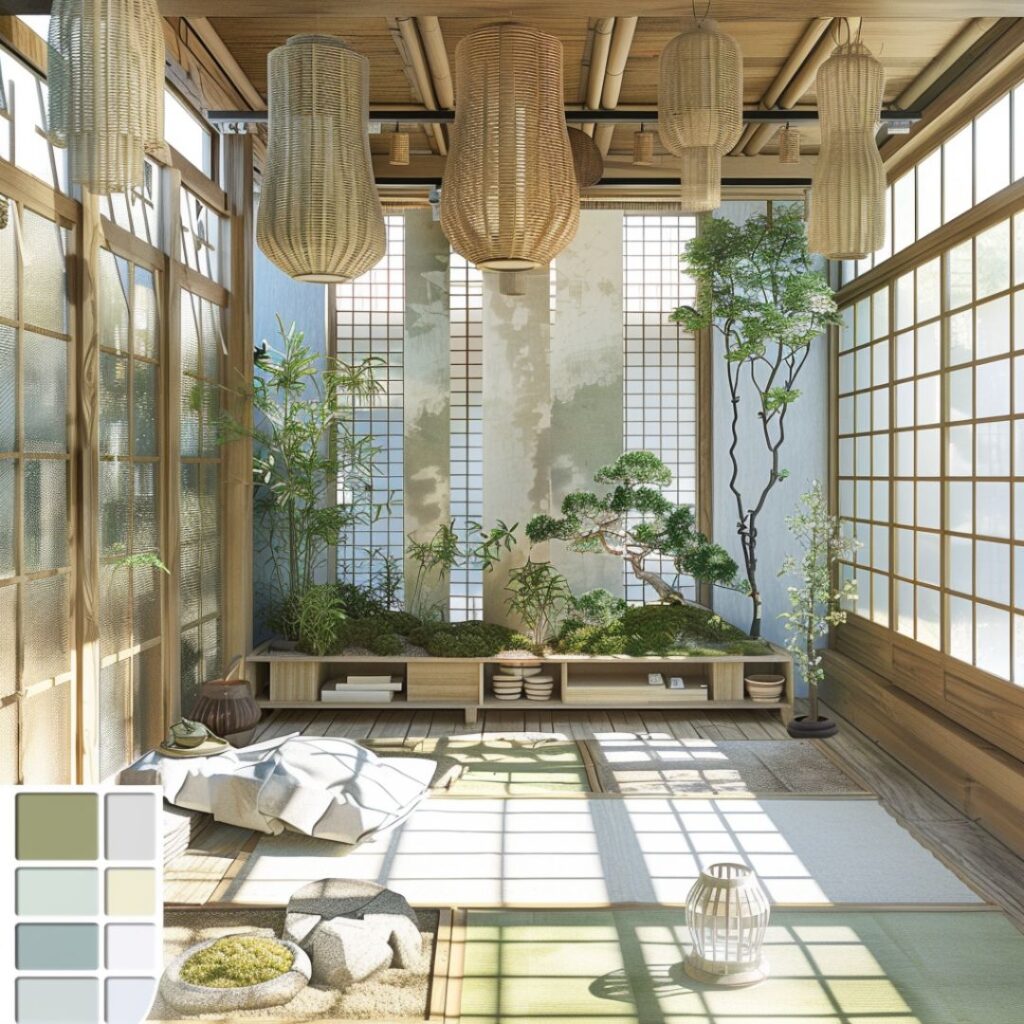
Japanese interior design is rooted in simplicity and a deep connection to nature. It embraces minimalism, using only essential items to create a serene environment. Clean lines, open spaces, and natural materials like wood and bamboo are key elements.
Light plays an important role. Large windows let in plenty of natural light, creating a calm ambiance. Paper screens known as shoji help diffuse light softly throughout the room.
Furniture is low to the ground. Tatami mats and futons are common, promoting comfort and grounding the space. Sliding doors save space while adding architectural interest.
Natural elements enhance tranquility. Indoor plants like bonsai trees or simple flower arrangements bring nature indoors. Stones, water features, and sand gardens also contribute to this peaceful vibe.
Colors are neutral and understated. Think soft whites, muted greens, browns, and grays that reflect the natural world outside your window.
Decoration is minimal but meaningful. Artworks often depict nature scenes or traditional Japanese motifs like cherry blossoms or koi fish.
Every item has a purpose and place. This creates harmony within the space while reducing clutter dramatically.
Incorporating these principles can transform any home into a tranquil retreat inspired by Japanese design traditions.
#63. Bali
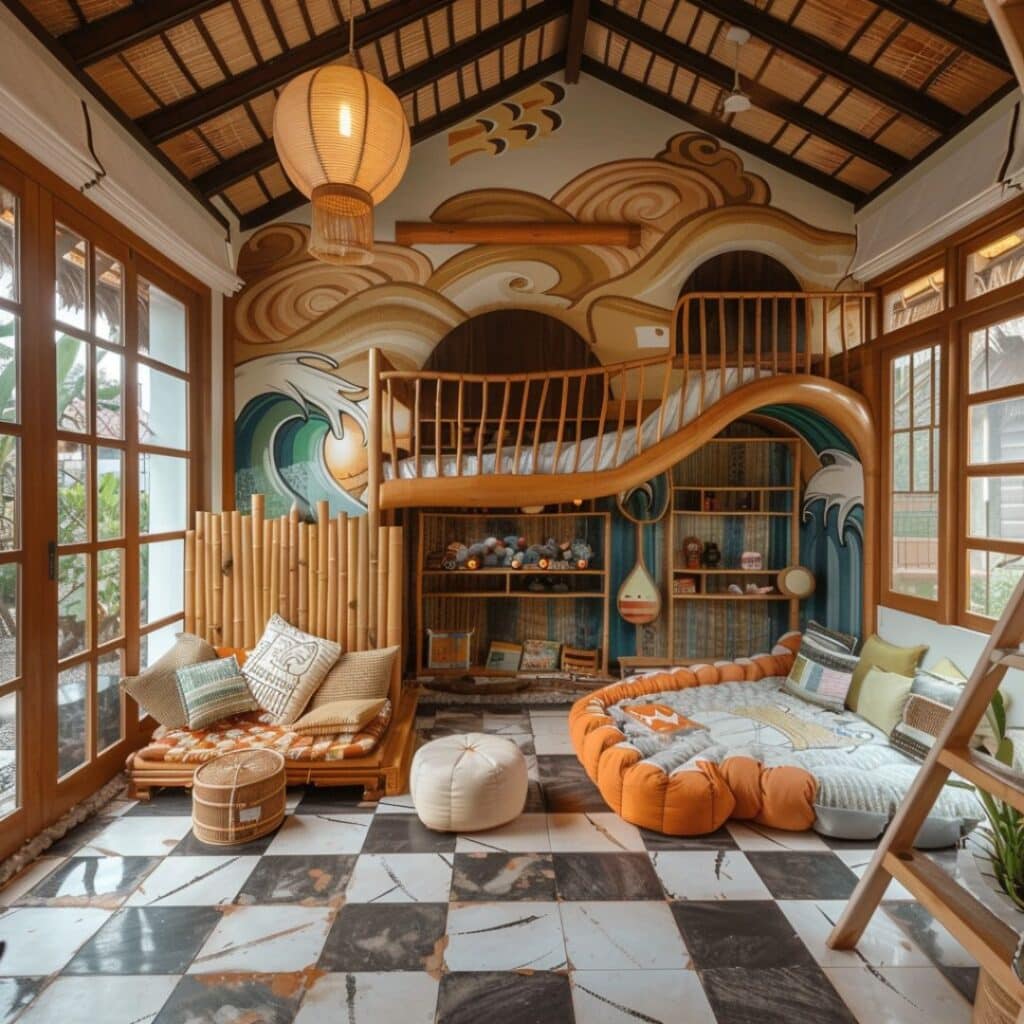
Bali interior design draws inspiration from the serene landscapes and rich culture of the Indonesian island. This style features natural materials like bamboo, teak wood, and rattan. You’ll often see furniture with intricate carvings and textiles showcasing traditional patterns.
Incorporate lush greenery to mimic Bali’s tropical environment. Indoor plants like palms and orchids add a vibrant touch to your space. Use earthy color palettes with deep greens, browns, and terracotta shades to create a grounded atmosphere.
Water elements are essential in Balinese design. Consider adding a small indoor fountain or water feature for tranquility. Decorative items such as stone sculptures or woven baskets further enhance the natural feel.
Open layouts are common in Balinese homes. Aim for airy spaces that allow plenty of natural light to flow through large windows or open doors. Soft lighting options like lanterns or candles can create a warm ambiance during evenings.
Textiles play a significant role too. Opt for handwoven rugs, batik pillows, and lightweight curtains to introduce texture. These elements bring an authentic touch that reflects Bali’s artisanal craftsmanship.
Finally, consider using low seating arrangements like floor cushions or daybeds for relaxation areas. This not only adds comfort but also stays true to the casual elegance of Balinese living spaces.
#64. Christmas

Transform your home into a festive wonderland with a Christmas interior design style.
Festive Decorations
Fill your space with traditional decorations like wreaths, garlands, and twinkling lights. Use red, green, gold, and silver to create a classic holiday palette.
Cozy Ambiance
Create a warm atmosphere with plush throws and soft cushions. Place candles around the room for a soft glow that enhances the cozy feel.
Themed Tree
Adorn your tree with ornaments that reflect your personal style. Whether it’s vintage baubles or handcrafted pieces, make it special.
Seasonal Scents
Incorporate scents like cinnamon, pine, and vanilla through candles or essential oil diffusers. These aromas instantly evoke holiday memories.
Table Settings
Set an inviting table with festive dinnerware and linens. Add decorative elements such as holly sprigs or mini wreaths to each place setting.
#65. Easter
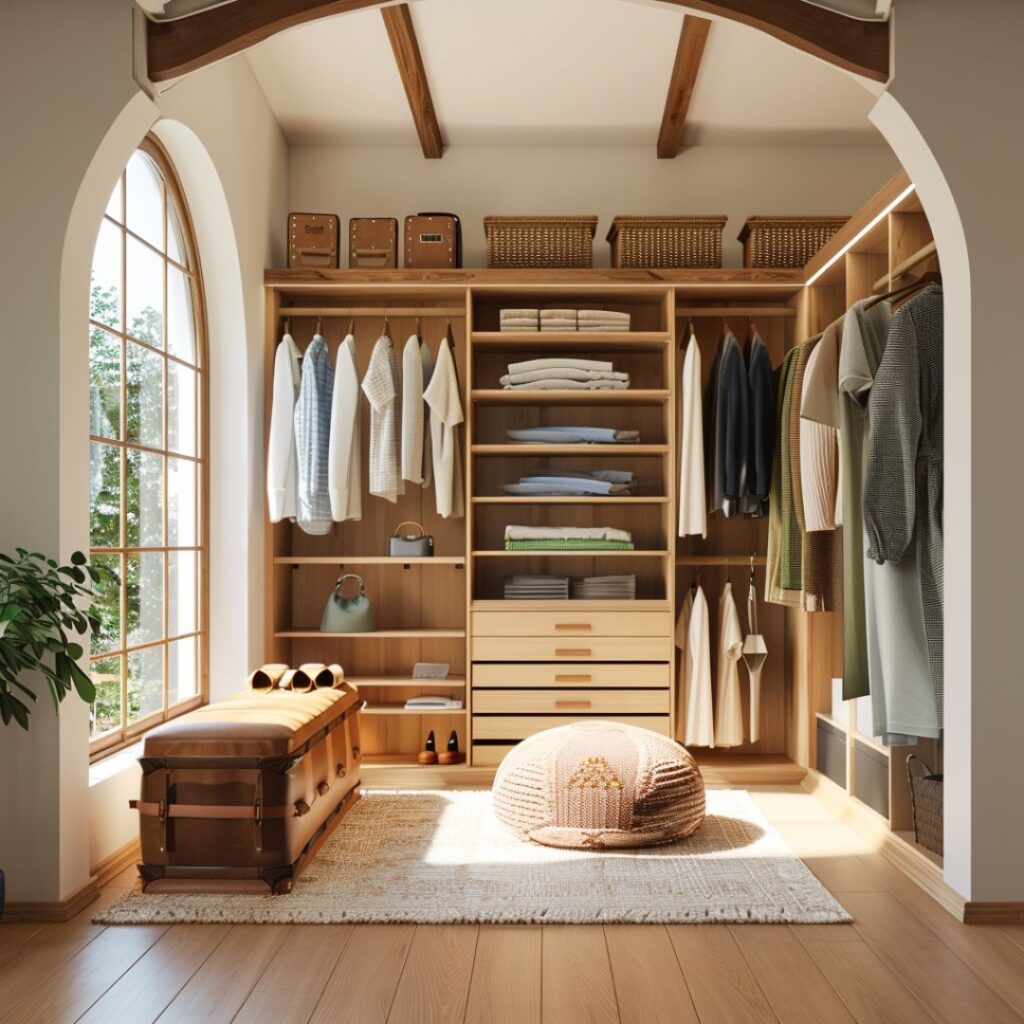
Easter interior design brightens spaces with pastel colors and charming decorations. Start by incorporating shades like soft pinks, yellows, greens, and blues into your decor. Add fresh flowers such as tulips, daffodils, and lilies in vases or arrangements.
Display playful elements like bunny figurines and egg-themed ornaments on mantels or shelves. Use decorative nests filled with faux eggs to create focal points on tables.
Opt for whimsical table settings with themed dinnerware and linens. Pair these with spring-inspired centerpieces that include blooming branches or potted plants.
Enhance the festive atmosphere by hanging garlands made of paper or fabric in pastel hues around windows or doorways. Integrate scented candles that evoke springtime fragrances like lavender or citrus.
Finally, consider a seasonal wreath for your front door adorned with ribbons, flowers, and tiny decorative eggs to greet guests warmly. This creates an inviting entryway that embraces the essence of Easter celebrations.
#66. Halloween
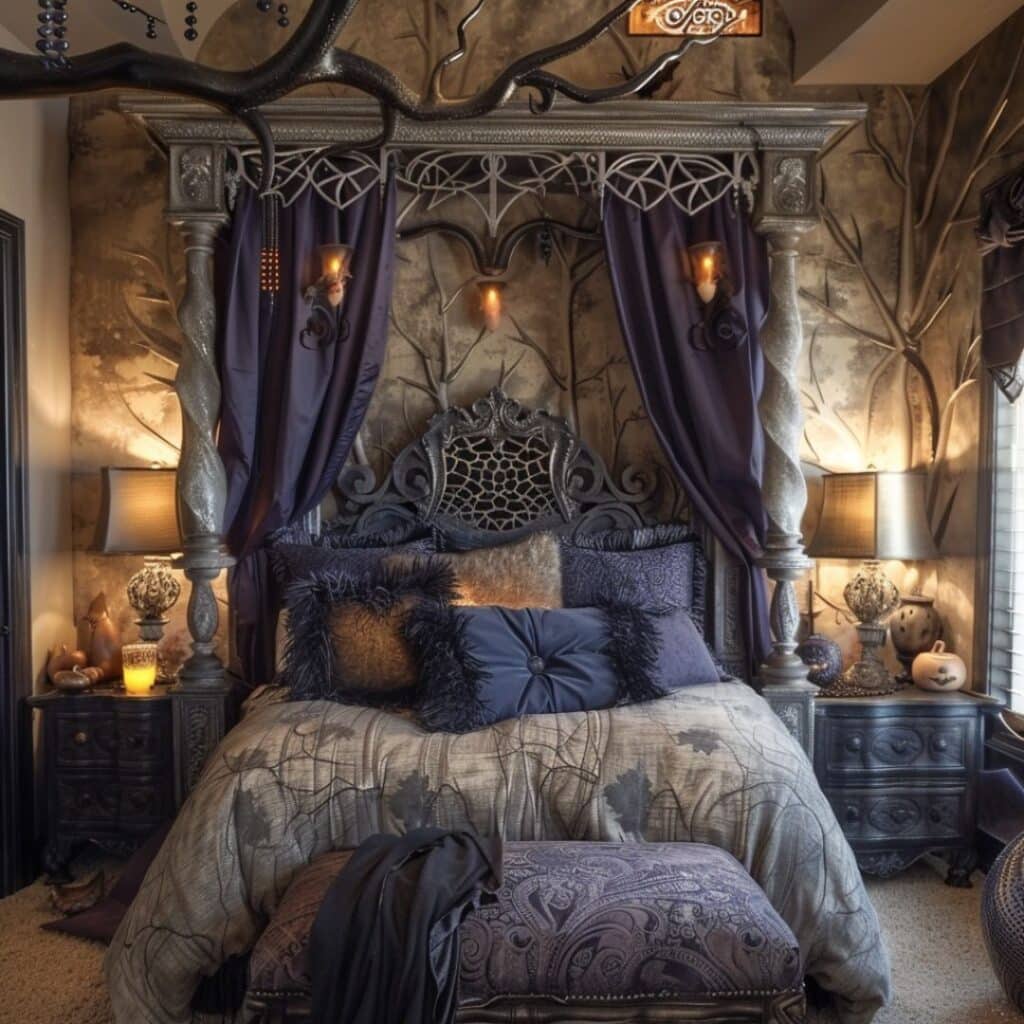
Decorating for Halloween can be a fun and exciting endeavor. Start by incorporating classic elements like pumpkins, spider webs, and eerie lighting. Choose a color palette dominated by black, orange, and purple to set the spooky mood.
Use vintage-inspired decorations such as antique lanterns and old books to add a mysterious touch. Place these items on mantels, side tables, or shelves for an authentic haunted house vibe. Don’t forget cobwebs for that extra creepy factor.
Integrate plush cushions in dark fabrics like velvet or silk for comfort while maintaining the theme. Add throw blankets with Halloween motifs to sofas or chairs to enhance coziness without losing the festive spirit.
Consider using mirrors with distressed frames to amplify light sources like candles or string lights, creating eerie reflections around your space. Position them strategically in hallways or living rooms for maximum effect.
Finally, include themed table settings with skull candle holders and bat-shaped napkin rings. These small details make your dining area both stylish and seasonally appropriate.
#67. Nautical
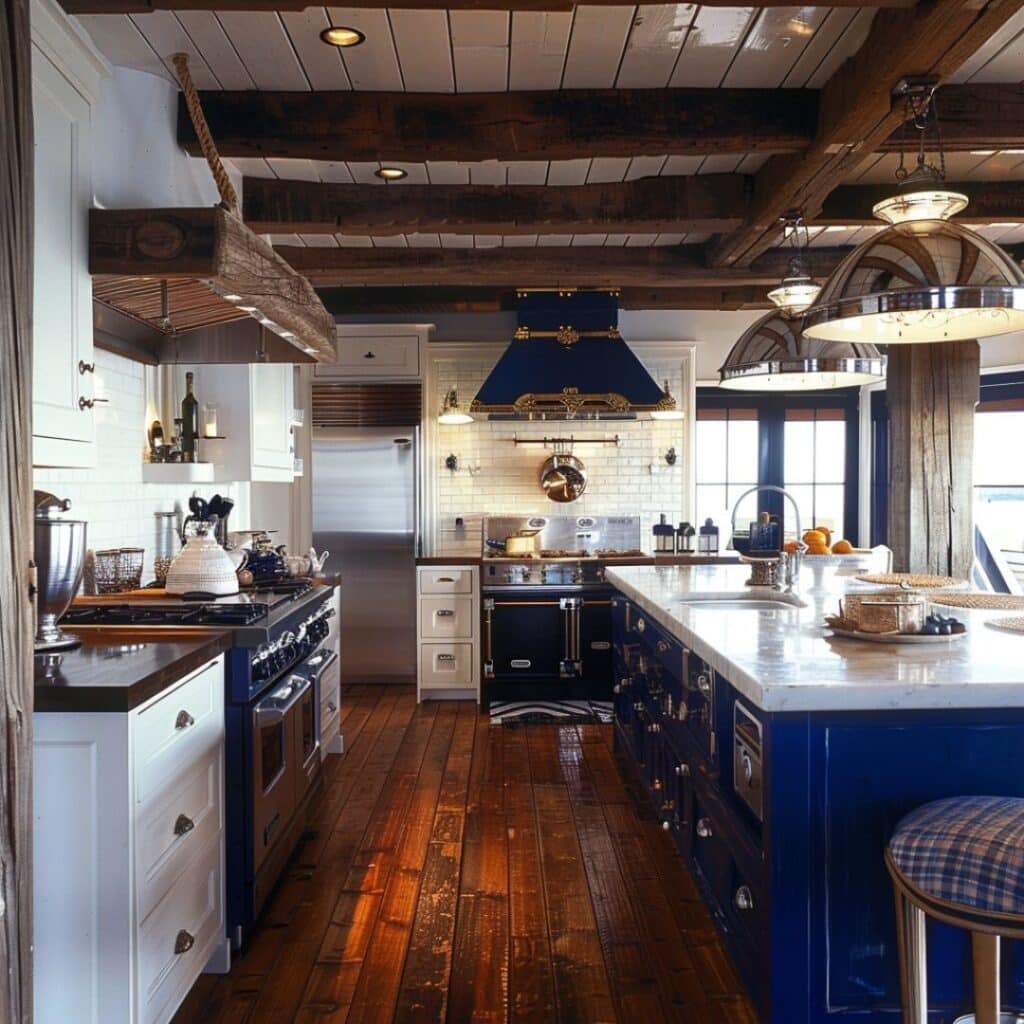
Nautical interior design captures the essence of the sea and maritime life. It uses a color palette dominated by navy blue, white, and shades of beige to mimic the ocean and sandy beaches. These colors create a clean, crisp look that feels both refreshing and timeless.
Incorporate natural materials such as wood and rope into your furnishings to enhance the maritime vibe. Weathered or distressed finishes can add authenticity to your space. Think about using wooden coffee tables, rope-wrapped mirrors, or wicker baskets for storage.
Accents in nautical design often include items like ship wheels, anchors, and seashells. Displaying model sailboats or framed maps can also add character. Striped patterns on cushions or rugs are popular choices that evoke sailors’ uniforms.
Lighting is another critical element. Lantern-style lamps or pendant lights with a rustic finish can provide both function and style. Consider adding wall sconces shaped like lighthouses for an extra touch.
Personal touches make all the difference in nautical decor. You may well use family photos from beach vacations or collectables from coastal trips to bring a sentimental feel to your room. This helps blend maritime elements with personal history seamlessly.
Window treatments should be simple yet elegant—think light sheers or nautical-themed curtains in navy stripes. Keep things airy to maintain that open-sea atmosphere.
Furniture should be functional but stylish. Opt for pieces like comfy sofas in neutral tones accented with blue throw pillows or chairs made from natural fibers like rattan.
Add greenery sparingly through potted plants that remind you of coastal vegetation—like succulents or ferns—to bring some life indoors without overpowering the theme.
Collectively, a successful nautical design combines functionality with aesthetics inspired by seafaring life, making it perfect for those who love everything about the ocean without needing to live near one.
#68. Beach House
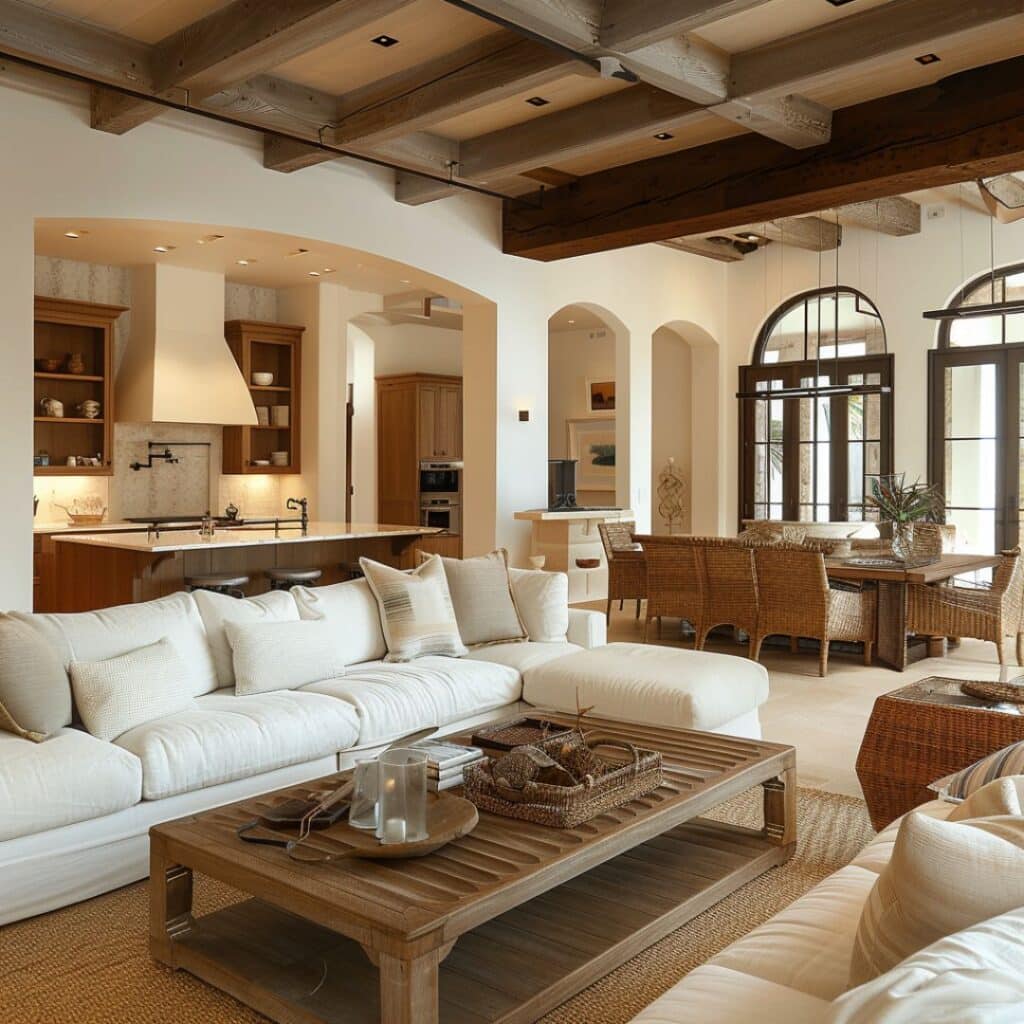
Bringing the beach indoors can transform your home into a coastal retreat. This Beach House interior design style is perfect for those seeking a relaxed and airy atmosphere. Start with a light and airy color palette, primarily using whites, soft blues, and sandy beiges. These colors mimic the seaside environment and create a relaxed atmosphere.
Choose natural materials for furniture, such as wicker or rattan chairs and wooden tables. These elements add texture and warmth to your space. Stone accents can also evoke the rugged beauty of the shoreline.
Incorporate nautical decor items like driftwood sculptures, seashell collections, or even vintage surfboards. Wall art featuring ocean scenes or marine life further enhances the coastal vibe.
Select lightweight fabrics for curtains and upholstery to maintain an open feel. Linen and cotton are excellent choices that offer both comfort and style. Add throw pillows in various shades of blue to complement your theme.
Lighting should be soft yet functional. Opt for fixtures made from materials like glass or rope to reflect seaside aesthetics. Pendant lights resembling lanterns bring a touch of maritime charm.
Flooring is key in achieving this design style. Wide-plank wood floors work well, especially when finished in distressed white or gray tones to resemble weathered beach decks.
Lastly, don’t forget greenery! Indoor plants like palms or succulents can bring a touch of nature indoors while contributing to the beach house ambiance.
#69. Hamptons

Hamptons style captures the essence of relaxed coastal living with a touch of elegance. Think airy spaces, light color palettes, and natural materials. It’s perfect for creating a serene yet sophisticated home environment.
Start by choosing a palette dominated by whites, soft blues, and sandy neutrals. These colors reflect the coastal landscape and bring an airy feel to your space.
Incorporate natural elements like wood and linen. Wooden furniture pieces with clean lines are staples in Hamptons design. Linen slipcovers for sofas or chairs add both comfort and casual sophistication.
Add texture through rugs, throw pillows, and woven baskets. Jute or sisal rugs work well in this setting due to their organic look and feel.
Lighting is crucial in Hamptons interiors. Choose fixtures that emit a warm glow, such as lantern-style pendants or chandeliers with a beachy vibe.
Accessorize sparingly but thoughtfully. Opt for decorative items like glass vases filled with fresh flowers or simple ceramic pieces that evoke the sea.
Window treatments should be kept light and breezy. Sheer curtains allow natural light to flood into your rooms while maintaining privacy.
Finally, don’t forget greenery! Plants like potted palms or fiddle leaf figs enhance the fresh, coastal ambiance of your home without overwhelming it.
By following these steps, you can effortlessly bring the charm of Hamptons style into any space.
#70. Glam
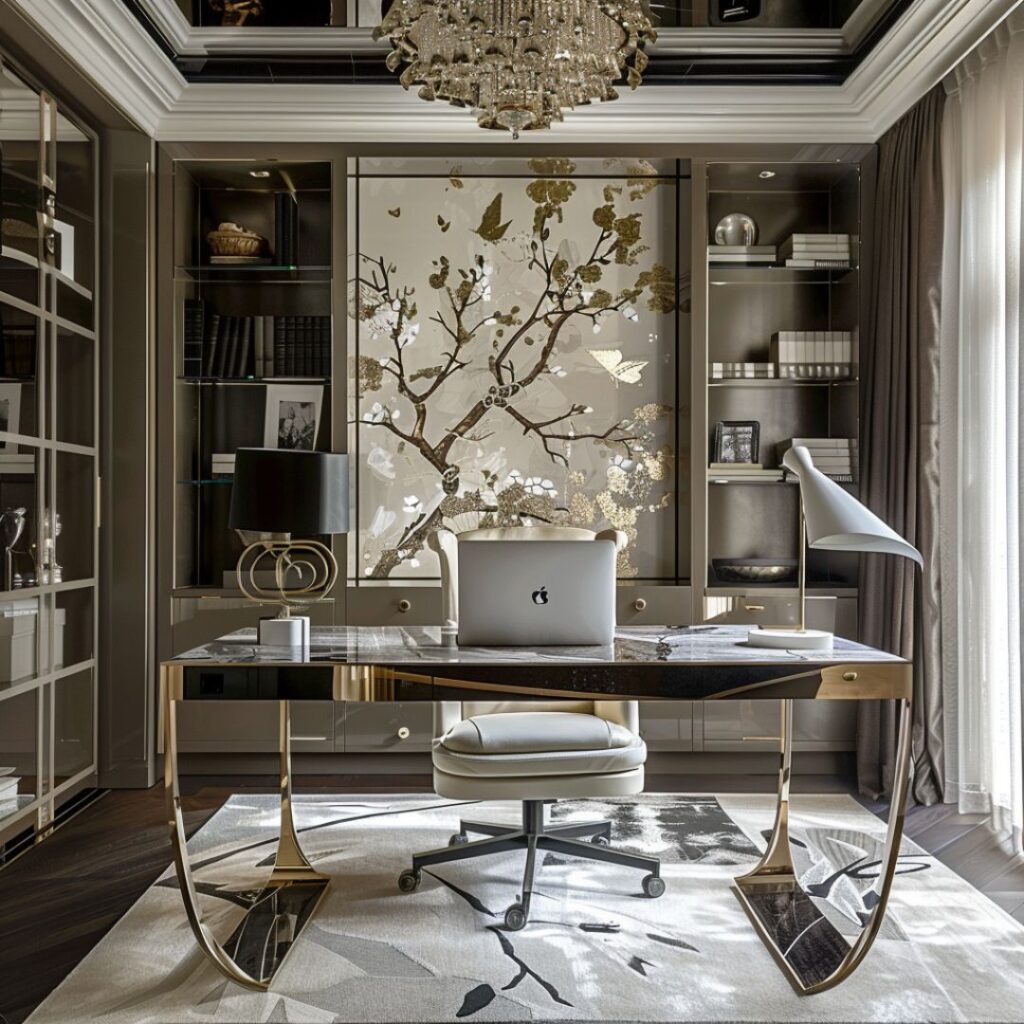
Hollywood glam interior design has been a staple in California since the mid-20th century. This style blends art deco and midcentury ultramodern elements. High contrast color combinations like hot pink and green, as well as black and white, are key features.
Patterns in Hollywood glam are bold and timeless. Fabrics to flooring can include Greek key, kiosk patterns, geometrics, and animal prints. Art deco and neoclassical motifs add an extra layer of sophistication.
Black and white checkered flooring fits perfectly within this style. Over-the-top chandeliers paired with high gloss or mirrored furniture amplify the luxurious vibe. These rooms often feel sexy yet sophisticated.
Suede, lacquer, leather, and metallic highlights bring richness to the space. If you enjoy wallpaper or carpeting, these can also complement this design style seamlessly.
This approach is not just glamorous but practical too. It’s perfect for hosting guests while making a statement about your taste in interior design.
#71. High-Tech
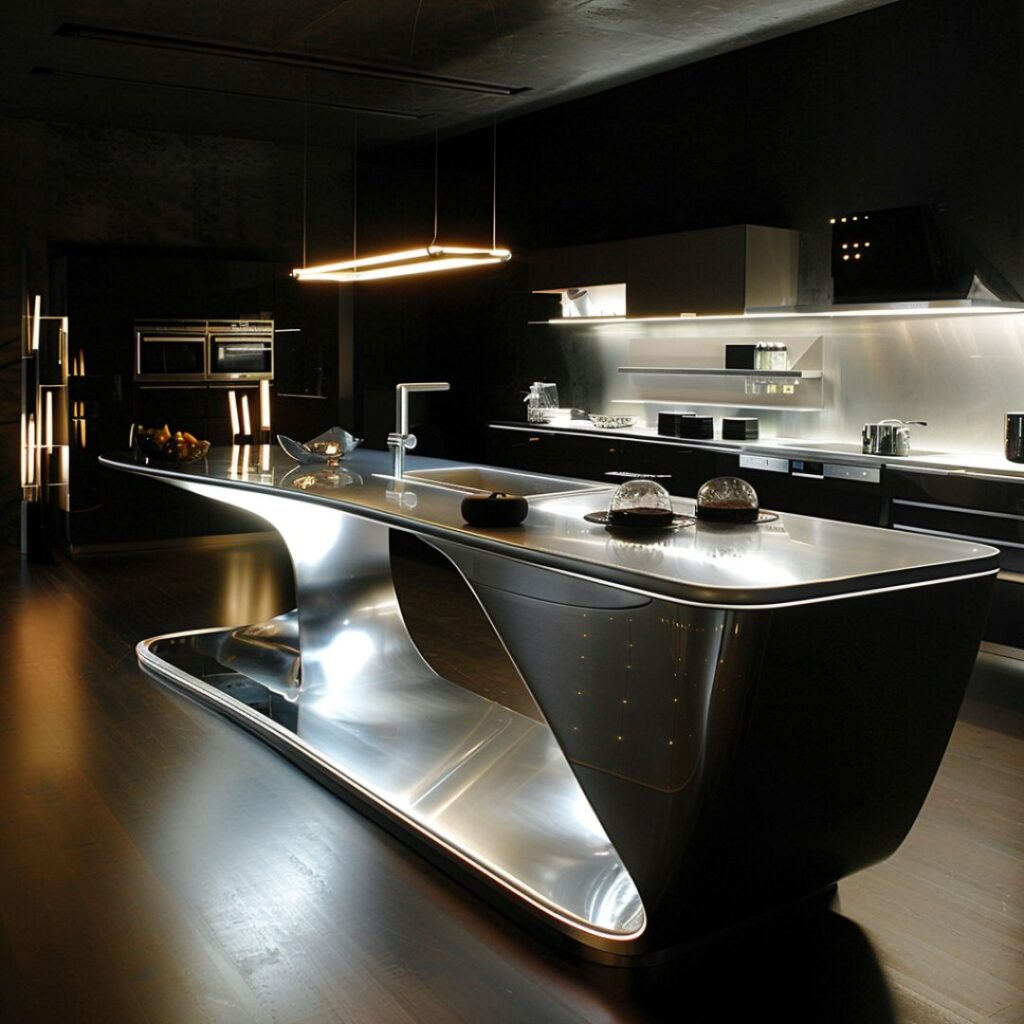
High-Tech interior design emphasizes sleek, modern aesthetics with cutting-edge technology. Think streamlined furniture, integrated smart home systems, and minimalist decor.
Prioritize materials like steel, glass, and concrete for a polished look. These elements contribute to the clean lines and sophisticated vibe characteristic of this style.
Incorporate state-of-the-art gadgets seamlessly into your living space. Automated lighting, climate control systems, and advanced security features are common in high-tech homes.
Opt for a monochromatic color scheme dominated by blacks, whites, and grays. This palette enhances the futuristic feel while maintaining an elegant simplicity.
Feature furniture with sharp angles and geometric shapes. Items like modular sofas or tables with metallic finishes fit perfectly within this design framework.
Use hidden storage solutions to maintain clutter-free environments. Built-in cabinets or underfloor compartments can help keep your space organized without compromising style.
Choose functional yet stylish lighting options such as LED strips or recessed fixtures. These not only illuminate the space effectively but also add to the modern aesthetic.
Integrate multimedia setups that blend seamlessly into the room’s design. Wall-mounted televisions or concealed speakers can enhance both form and function in a high-tech setting.
Experiment with textures like brushed metal or glossy surfaces to add depth without overwhelming the minimalist approach. Balance is key in achieving a harmonious look.
#72. Rustic Modern
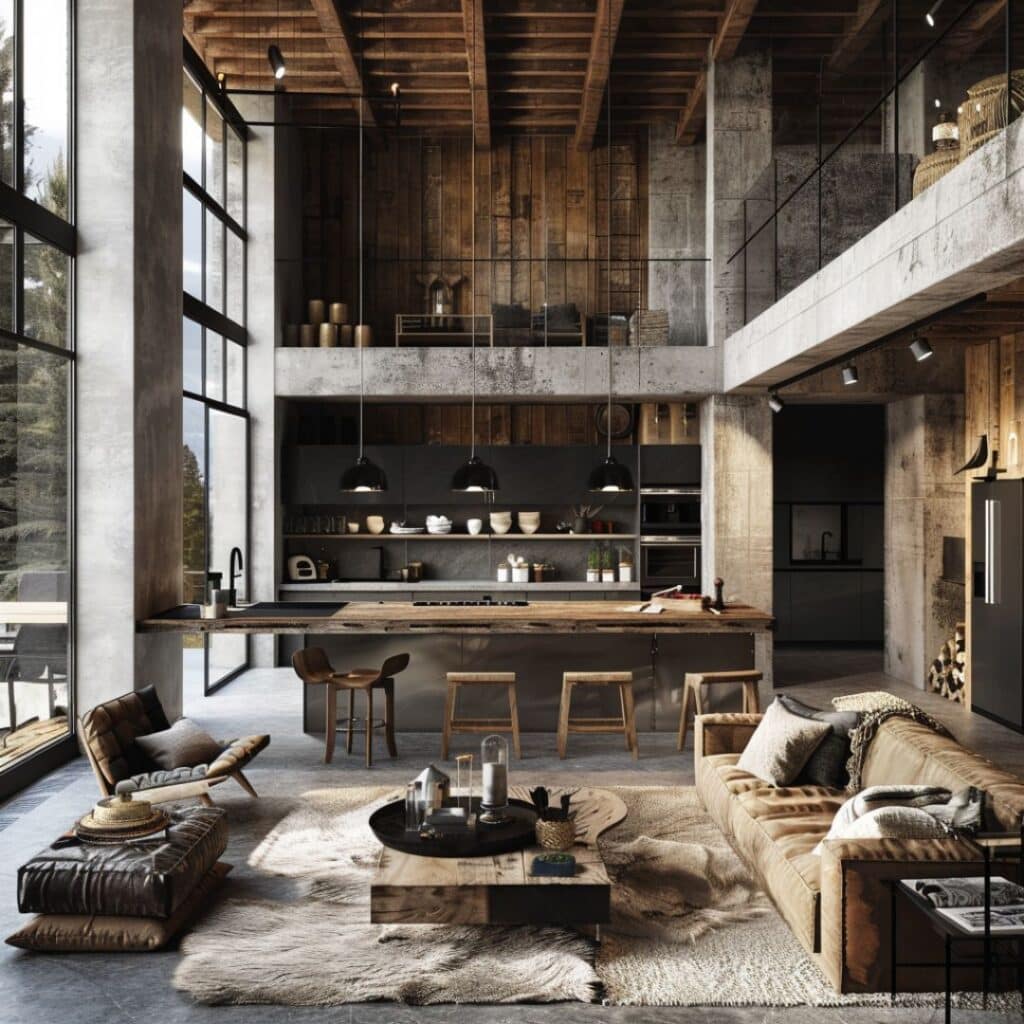
Blending rustic charm with modern elegance, the Rustic Modern style is a favorite. It combines natural materials with sleek finishes for a cozy yet sophisticated ambiance.
Natural Materials
Use wood, stone, and metals to bring nature indoors. Exposed beams, wooden floors, and stone accents add warmth and character.
Cozy Textiles
Add cowhides or sheepskin throws to soften the look. These elements make the space inviting and comfortable.
Neutral Palette
Stick to neutral colors like white, beige, and gray. This keeps the design clean while letting natural textures shine.
Industrial Touches
Incorporate industrial elements like metal light fixtures or exposed piping. These pieces provide a modern edge to your rustic environment.
Vintage Accents
Include vintage furniture or antiques to enhance the rustic feel. Think reclaimed wood tables or old leather chairs for an authentic touch.
Minimalist Approach
Opt for a less cluttered layout with functional decor. Focus on quality over quantity to maintain a balanced aesthetic.
By combining these components, you’ll create a space that feels both timeless and contemporary.
#73. Urban Jungle
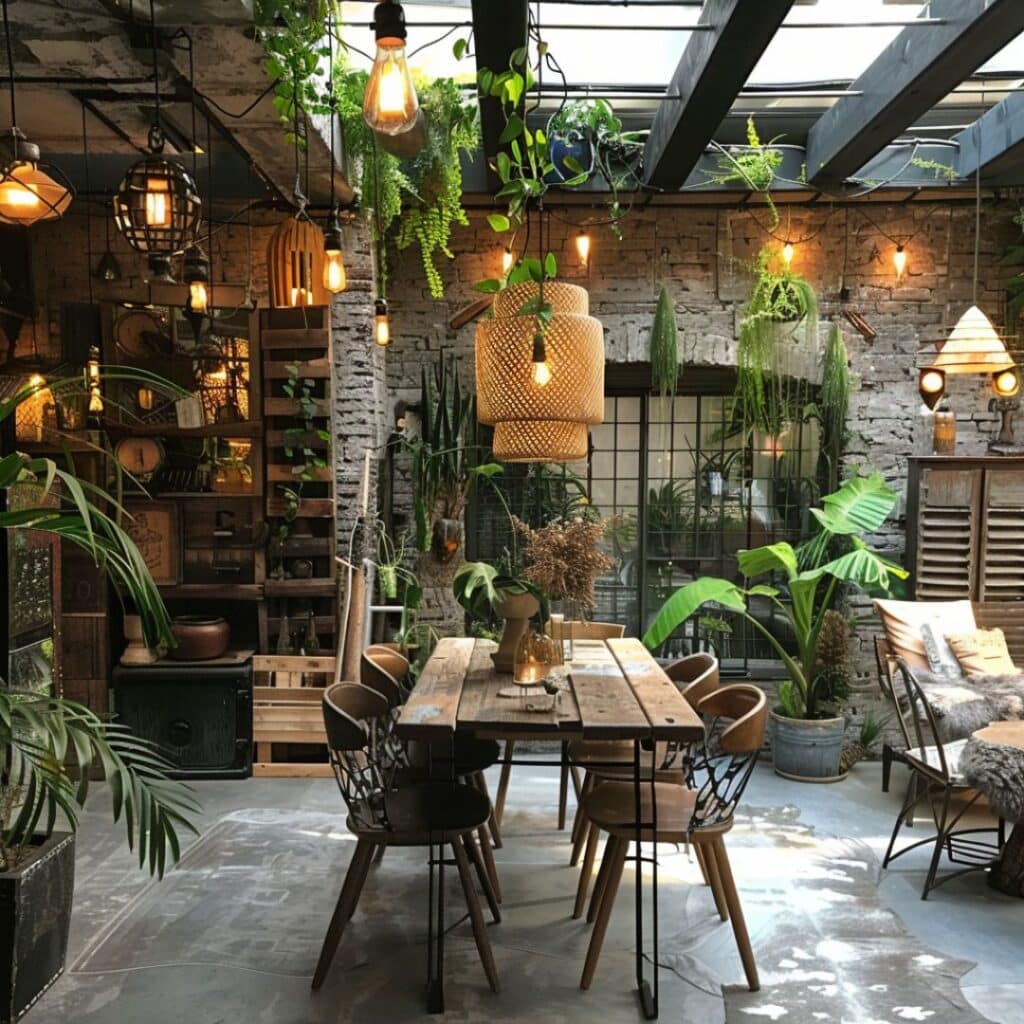
Embrace the green with your very own urban jungle. Fill your space with a variety of indoor plants, from tall palms to tiny succulents. By using different plant heights and textures, you can create a lush, layered look.
Incorporate natural materials like rattan and bamboo furniture to enhance the earthy feel. Opt for pieces that showcase intricate weaves or organic shapes. Earthy tones such as deep greens, browns, and neutrals help tie everything together.
Maximize natural light by keeping window treatments minimal. Sheer curtains work well in this setting. Reflective surfaces like mirrors can also help bounce light around the room.
Add botanical prints through artwork or textiles for visual interest. Think throw pillows with leaf patterns or wall art featuring tropical scenes. These elements bring cohesion without overwhelming the space.
Include unique accessories like terrariums or hanging planters for added dimension. Flea markets often have interesting finds that fit this style perfectly.
Lastly, consider incorporating water features if possible. A small tabletop fountain can introduce soothing sounds and elevate the overall ambiance of your urban jungle space.
#74. Green Living

Green living focuses on creating environmentally conscious spaces. It’s all about using nature’s resources wisely.
Use Sustainable Materials
Opt for materials like bamboo, reclaimed wood, and recycled metal. These reduce your environmental footprint while adding aesthetic appeal.
Maximize Natural Light
Position windows to let in ample sunlight. Consider skylights or light tubes for darker areas.
Incorporate Indoor Plants
Add plants of various sizes to improve air quality and bring life into your home. Choose low-maintenance varieties like succulents or ferns.
Energy-Efficient Appliances
Select appliances with high energy ratings. They consume less power and save on utility bills over time.
Eco-Friendly Paints
Use non-toxic, low-VOC paints. They release fewer pollutants, ensuring better indoor air quality.
Water Conservation Features
Install low-flow faucets and showerheads. These fixtures conserve water without compromising performance.
By integrating these steps, you can create a space that’s both stylish and sustainable.
#75. Smart Home

Modern Interior Design
Smart home technology has revolutionized modern interior design. Smart Lighting systems can be controlled remotely, offering energy efficiency and customized lighting scenes. Smart Thermostats allow you to pre-set optimal temperatures for comfort and energy savings. Voice-controlled entertainment systems and smart TVs enhance your living experience.
Traditional Interior Design
Traditional designs elegantly conceal smart technologies. Custom storage units or decorative elements hide devices, maintaining a classic aesthetic while integrating modern conveniences.
By seamlessly blending smart home features with different interior design styles, you create spaces that are both functional and visually appealing.
#76. Garden Oasis
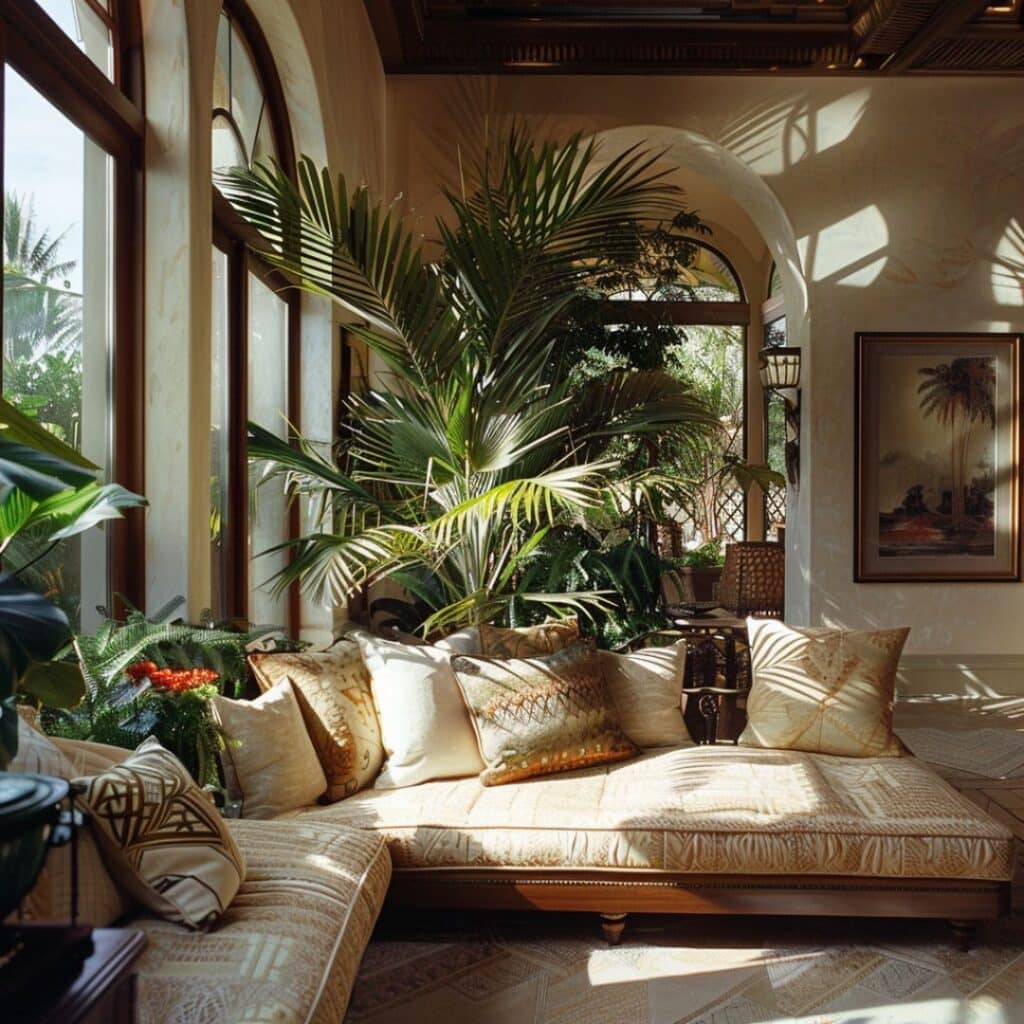
Creating a garden oasis transforms your outdoor space into a serene retreat. Different interior design styles can help you achieve this peaceful environment.
Cottage-Style
Cottage-style gardens are cozy and inviting. Use natural materials like wood and wicker. Soft colors such as pastels enhance the charm.
Zen Garden
A Zen garden focuses on minimalism and tranquility. Opt for low decks and built-in seating. Organic landscaping with rocks and gravel adds to the serenity.
Timeless
Timeless gardens feature simple seating areas. Manicured lawns and vintage decor pieces create an elegant vibe.
Modern
Modern garden designs are sleek and comfortable. Include fire pits, plush seating, and tropical plants for a relaxed atmosphere.
Rustic
Rustic gardens blend seamlessly with nature. Stone patios and organically-shaped pools offer a natural feel.
Midcentury Modern
Midcentury modern gardens provide privacy with high walls. Streamlined furnishings paired with lush landscaping contribute to a polished look.

